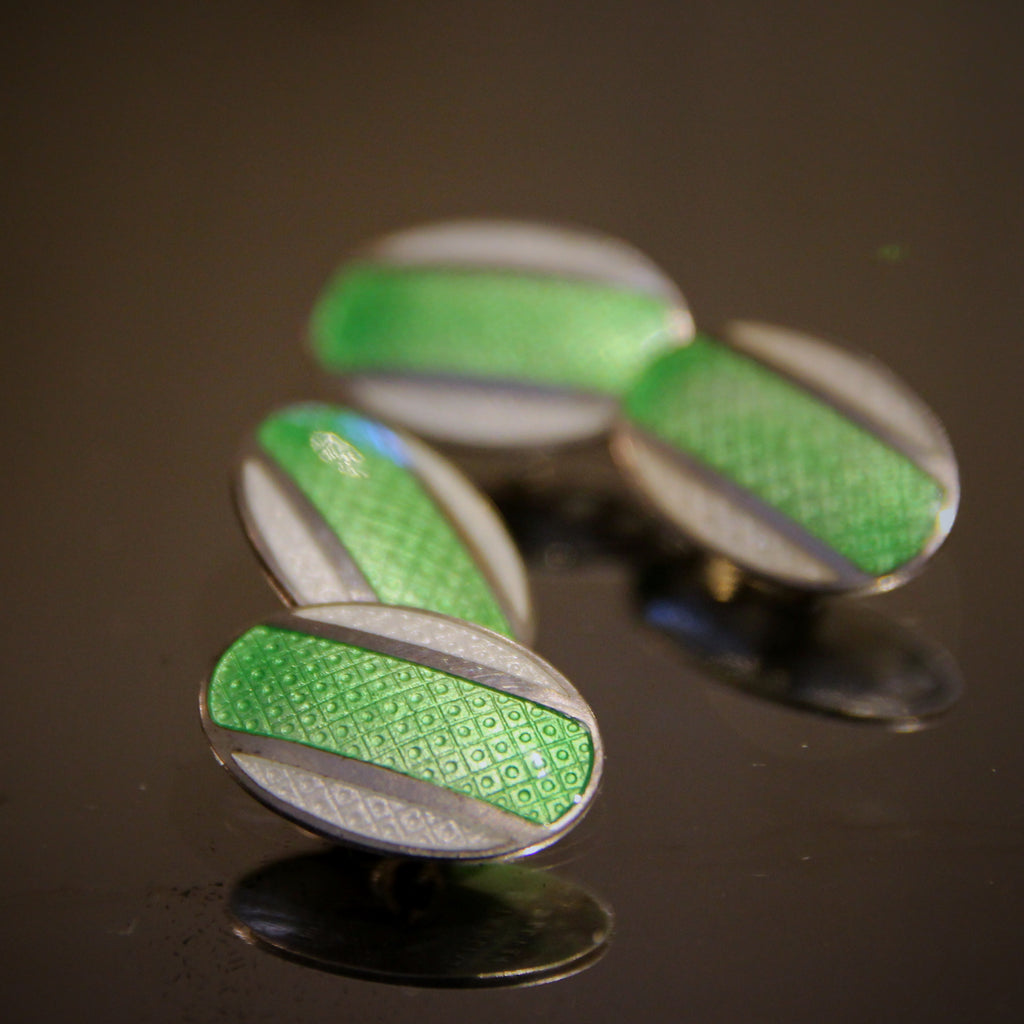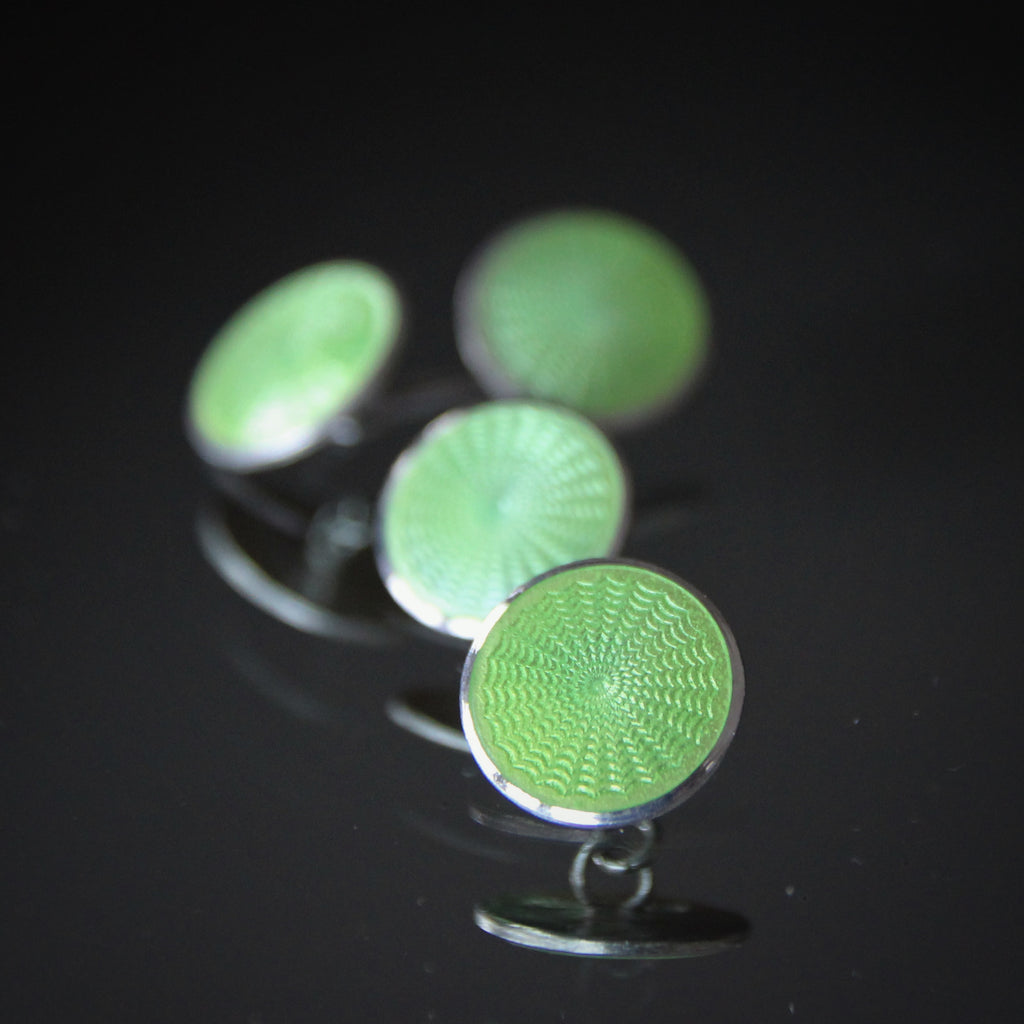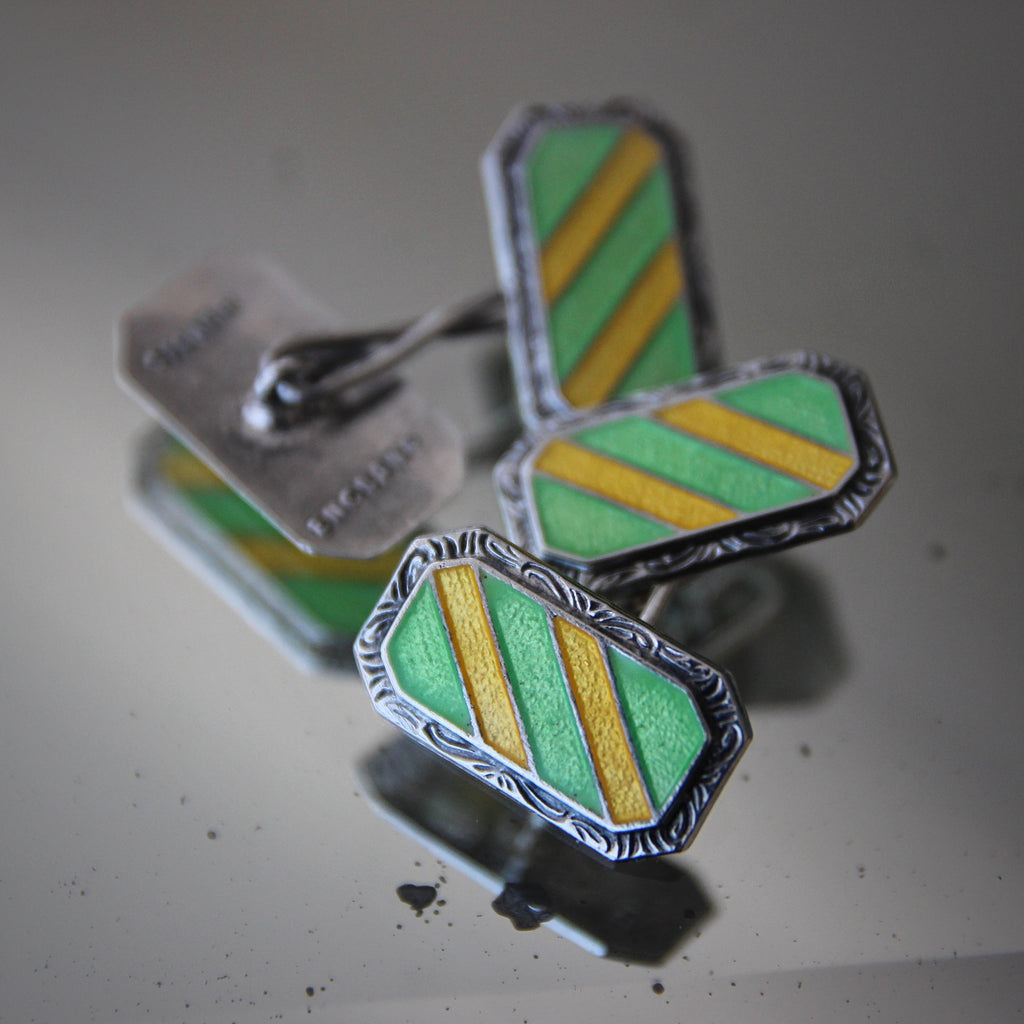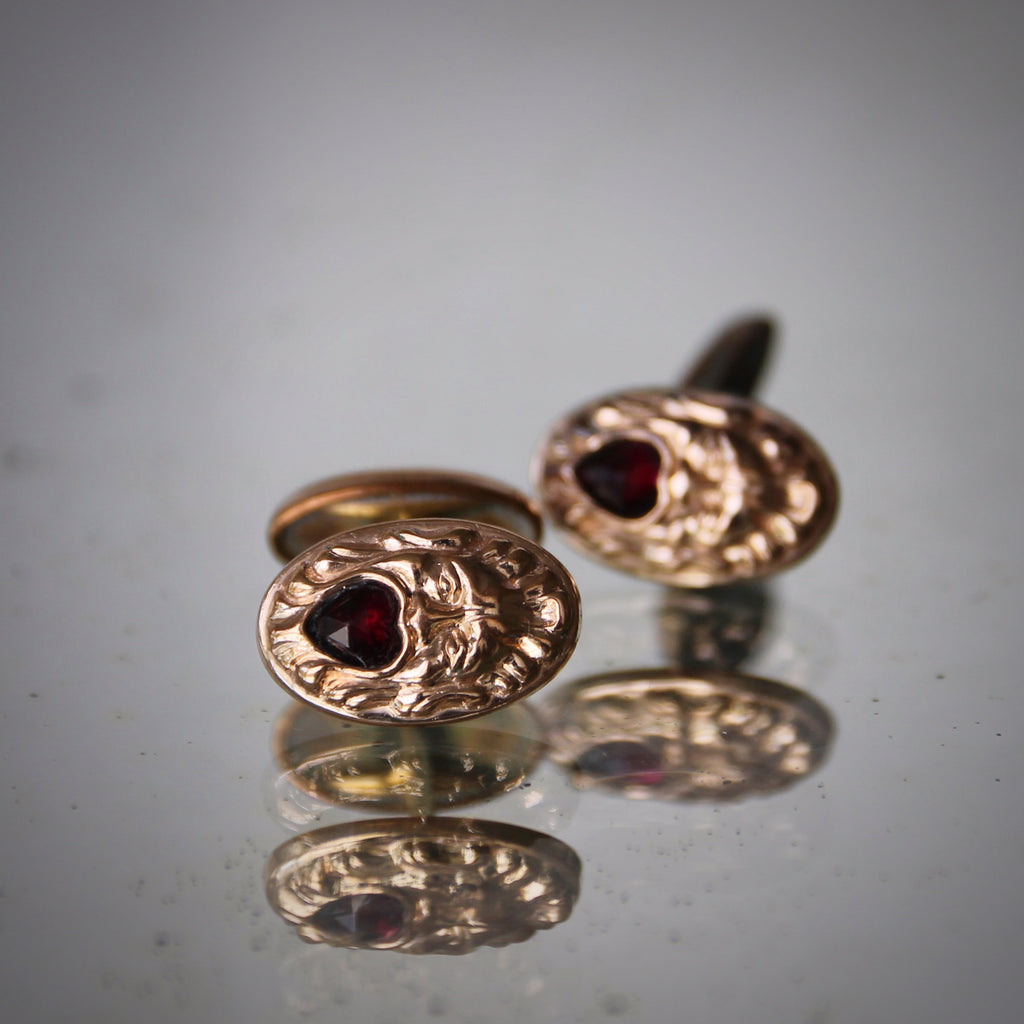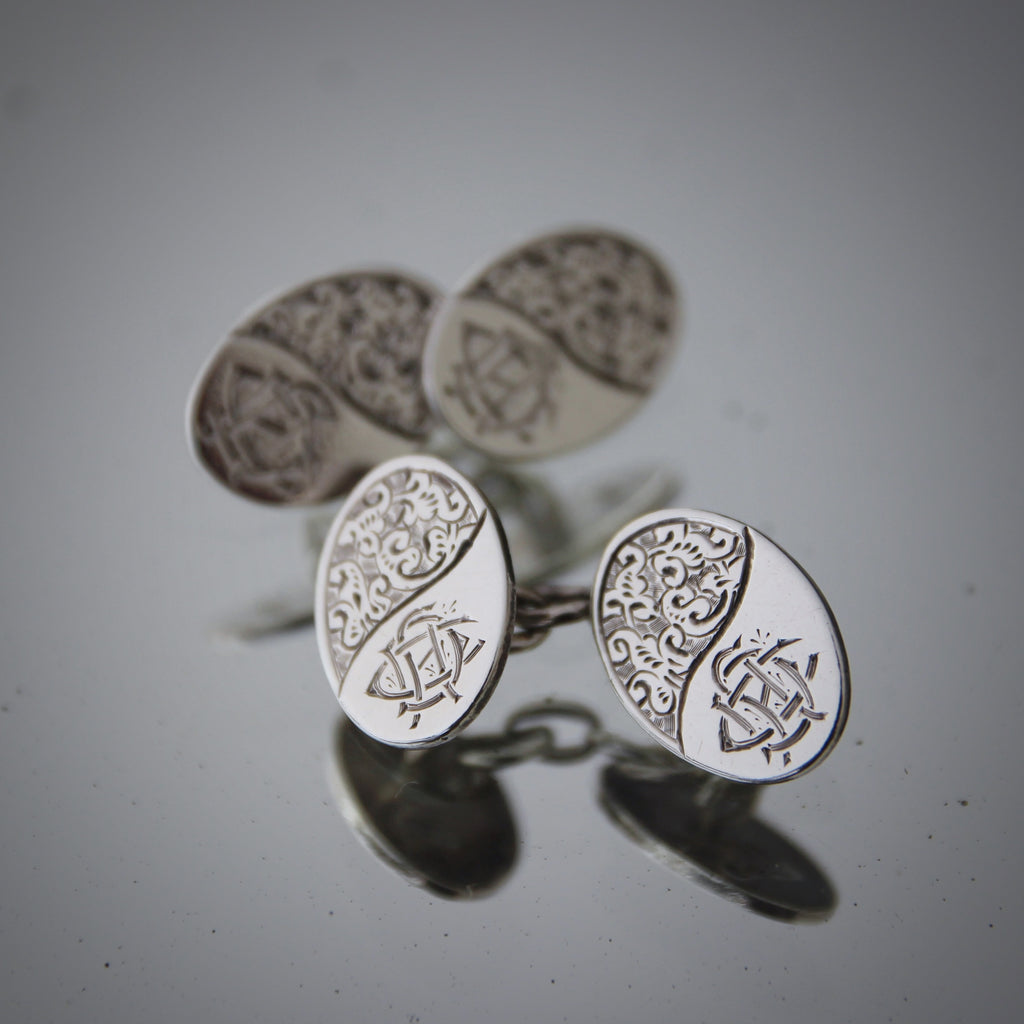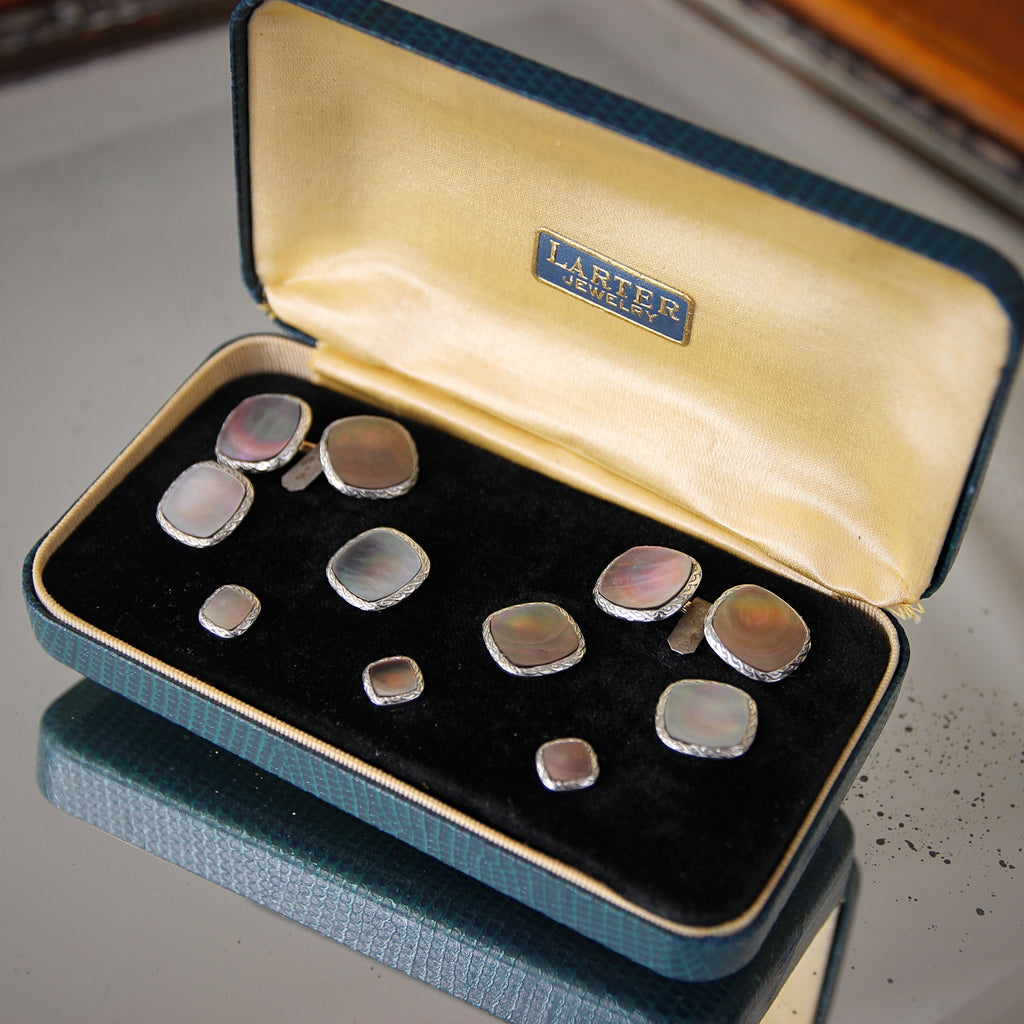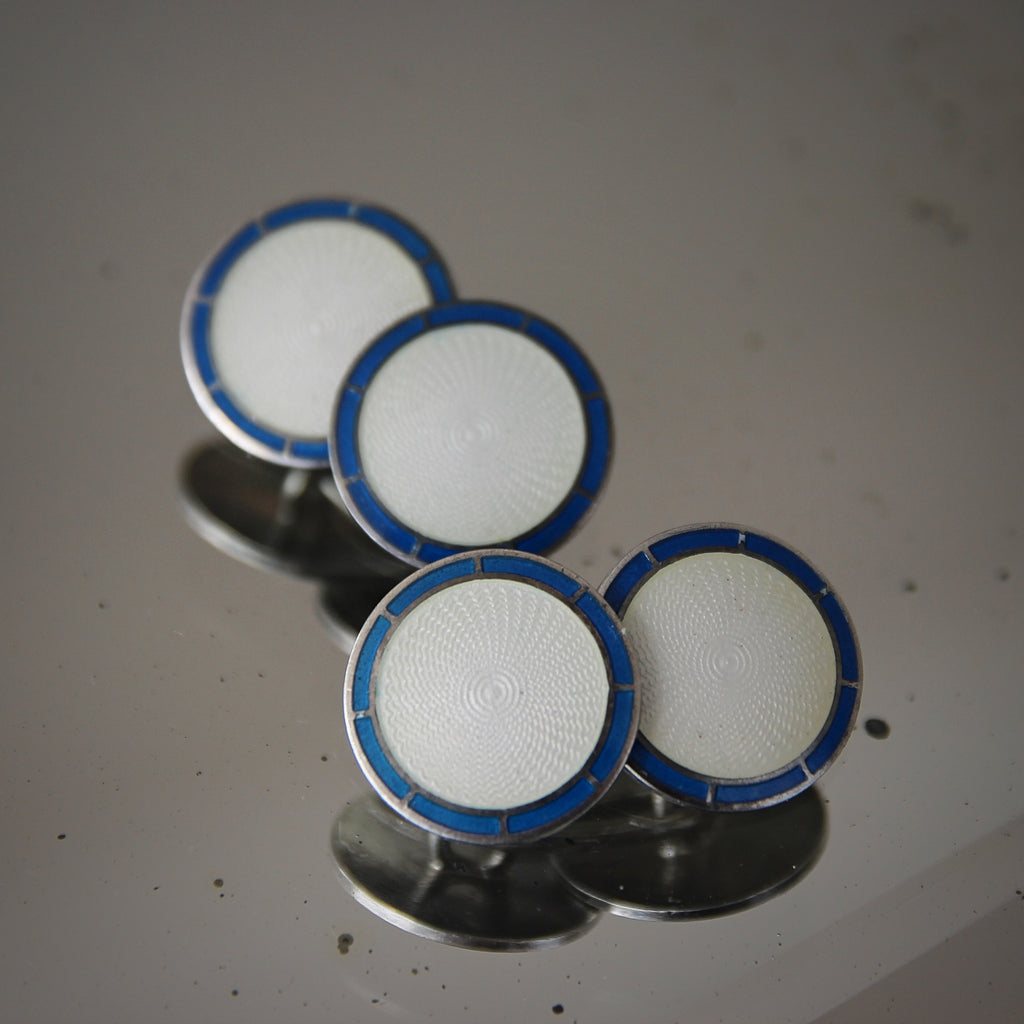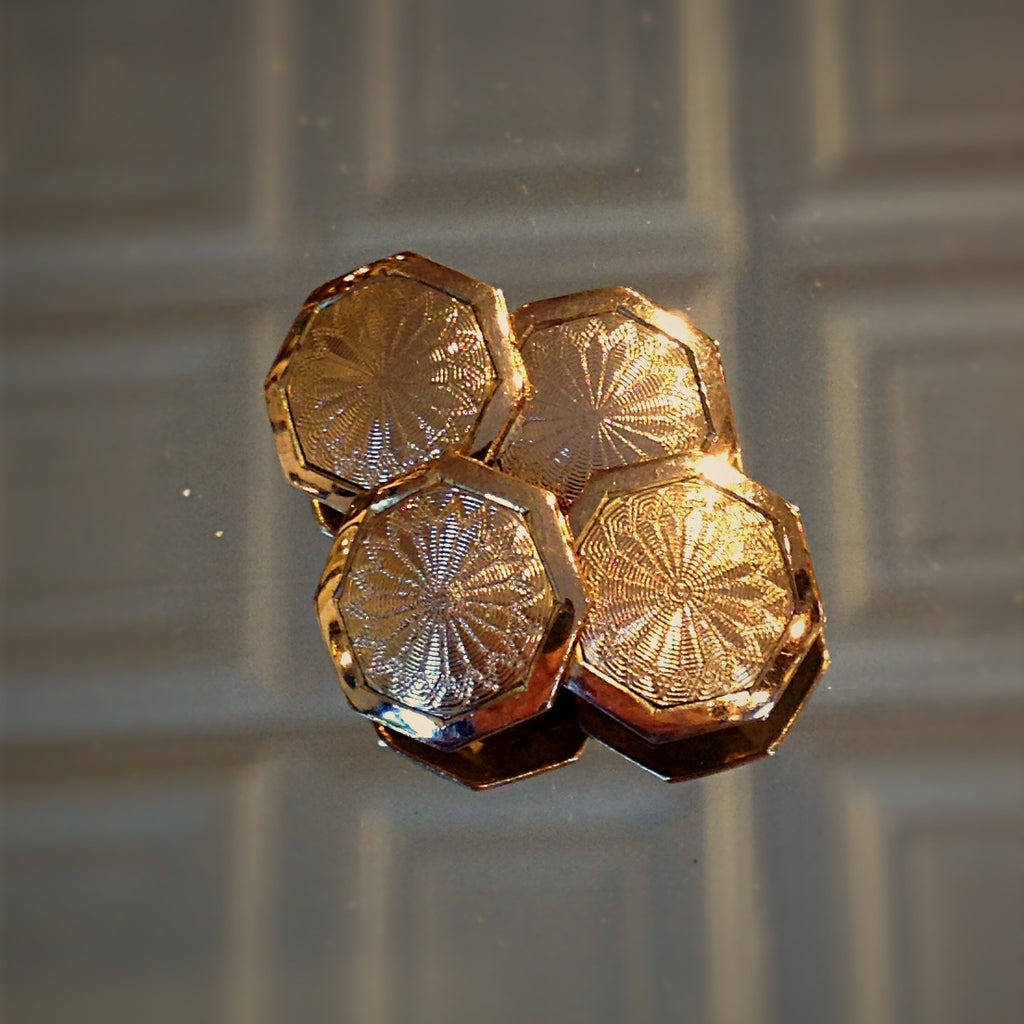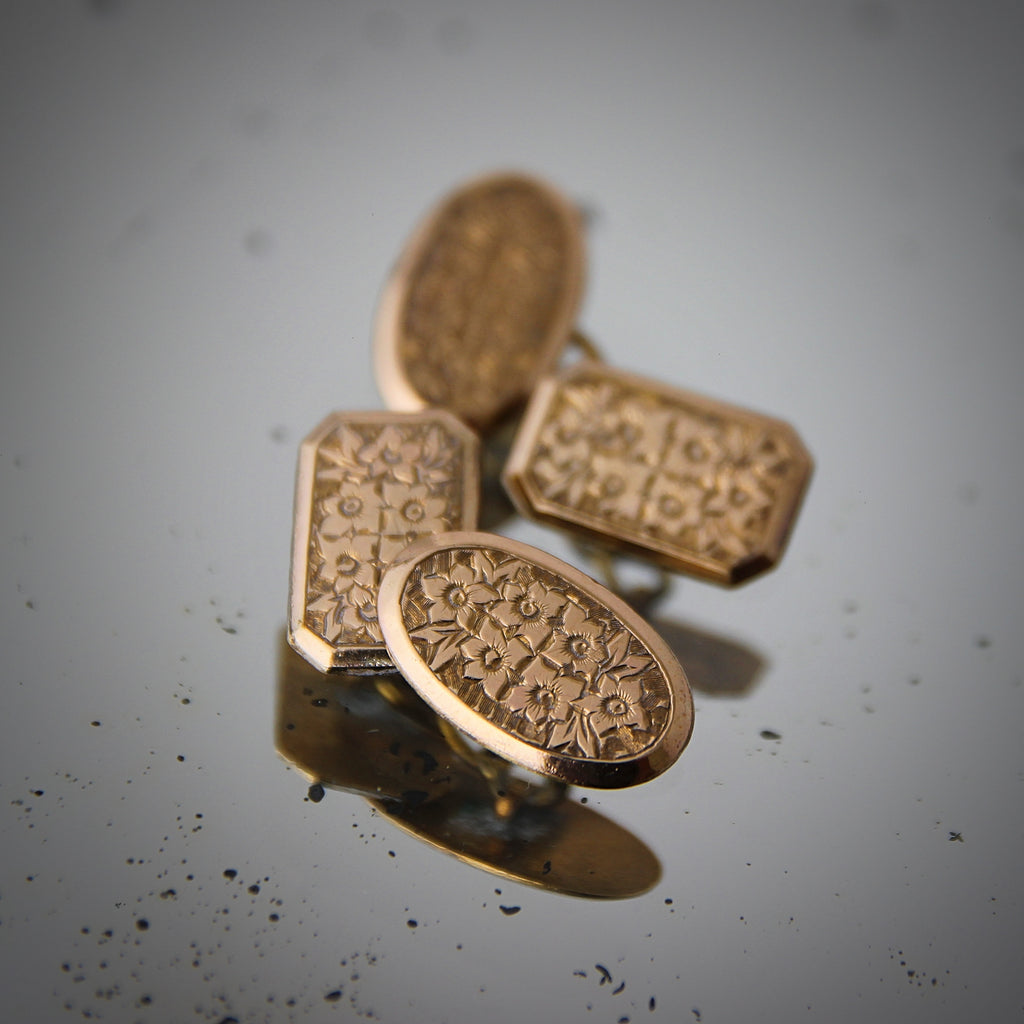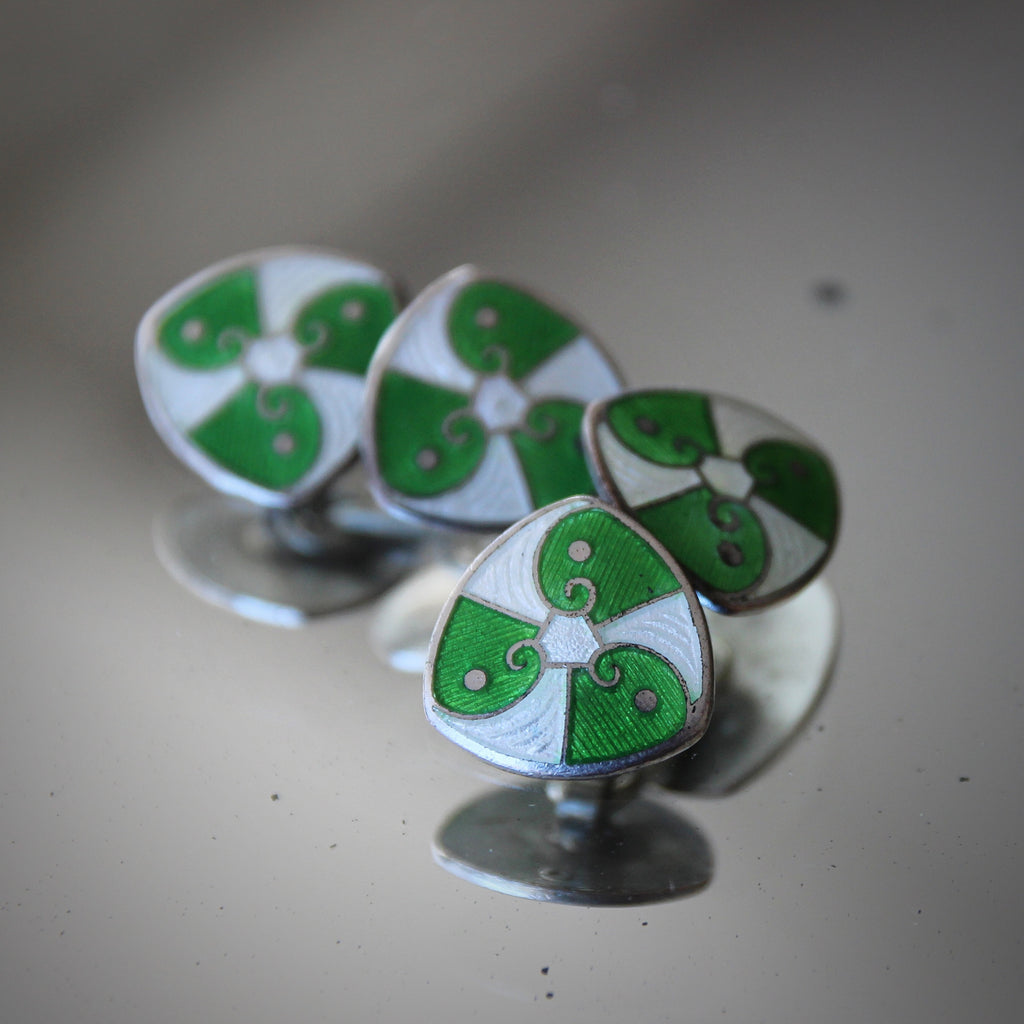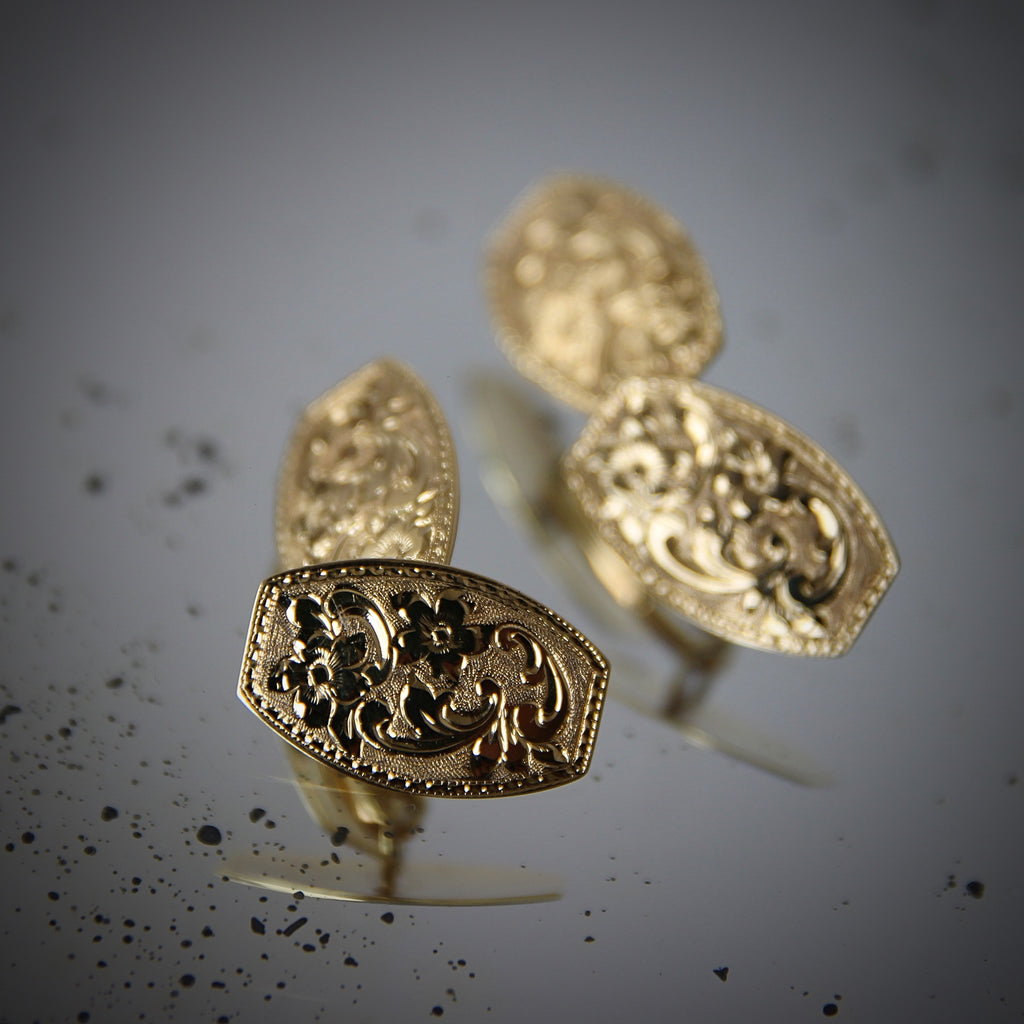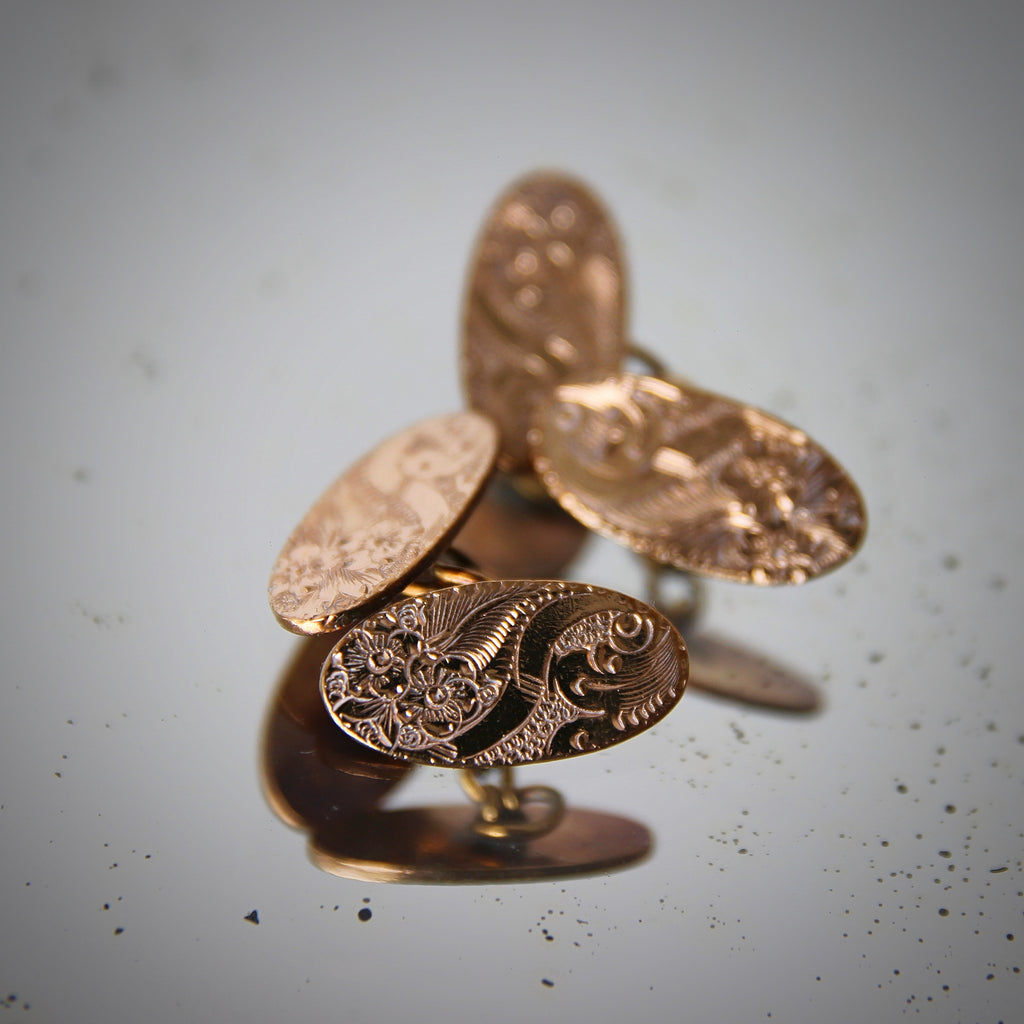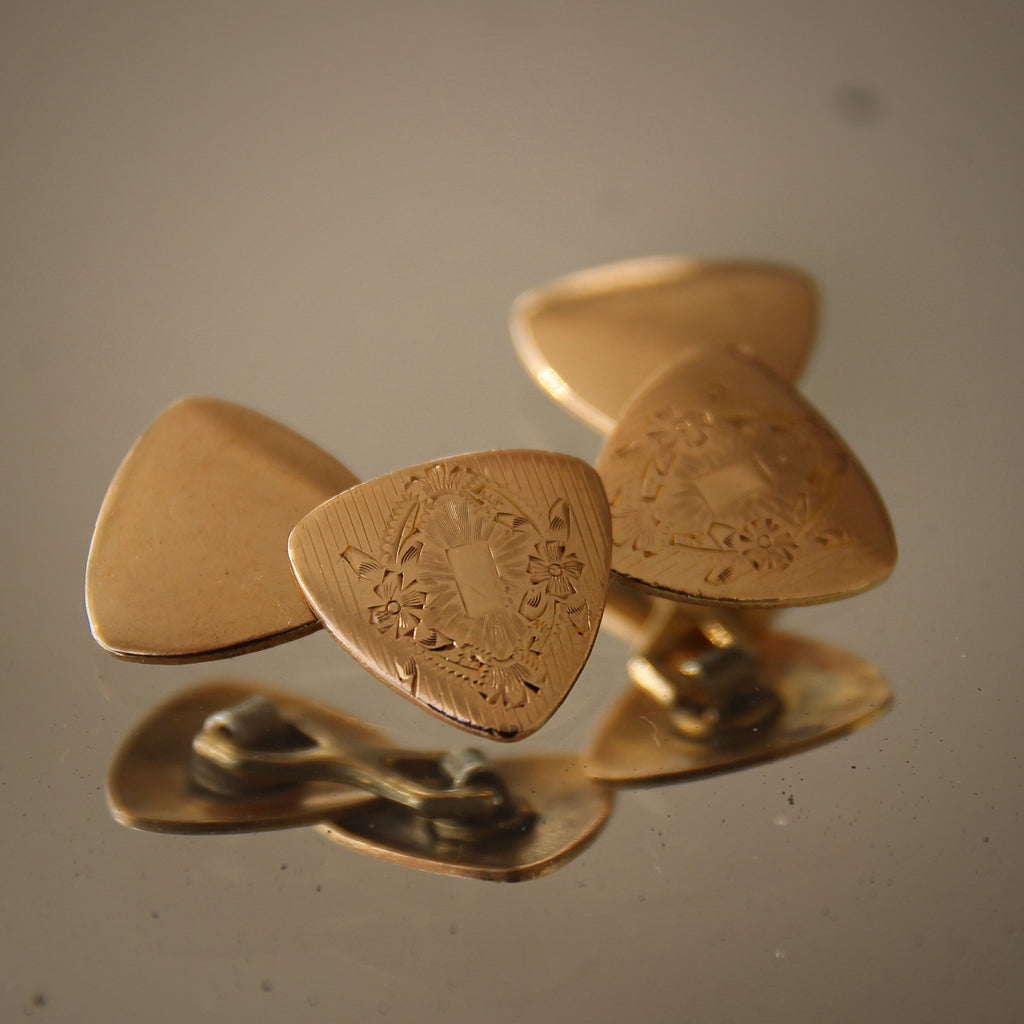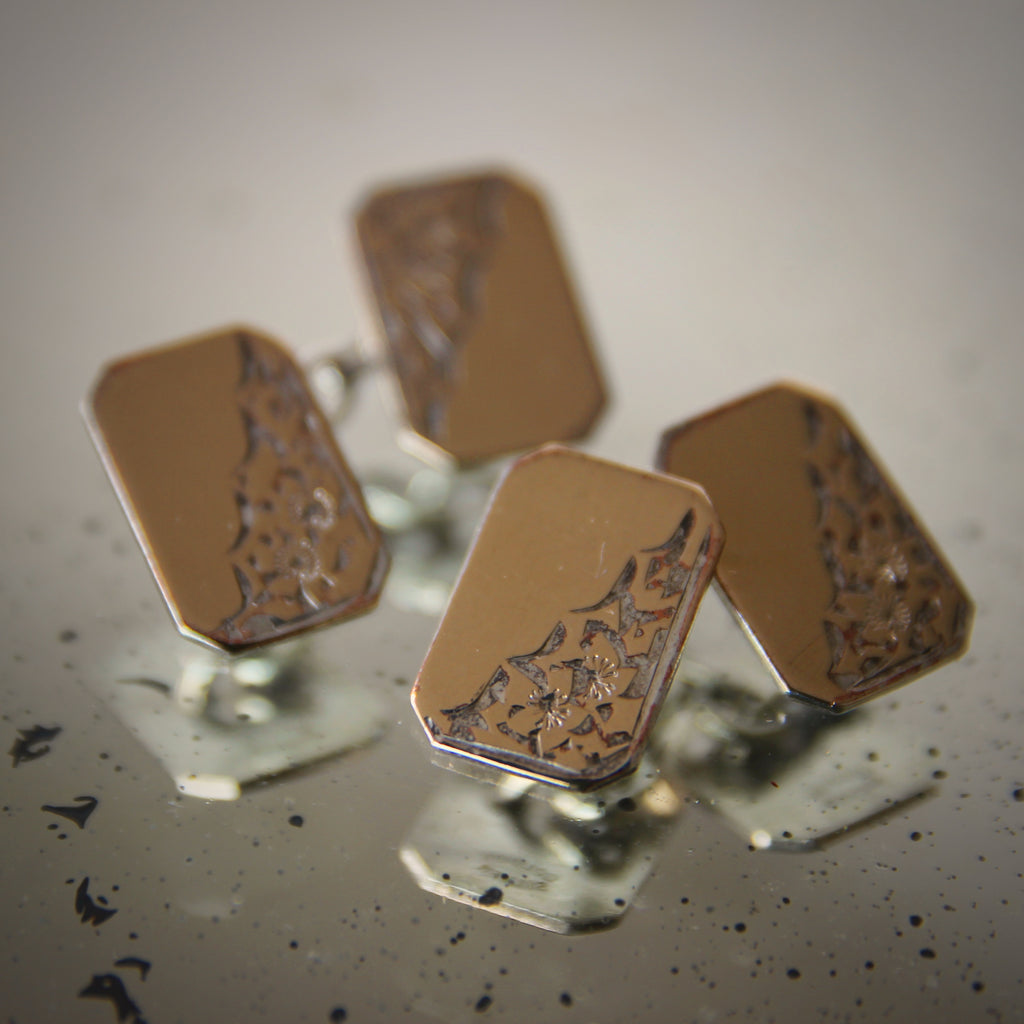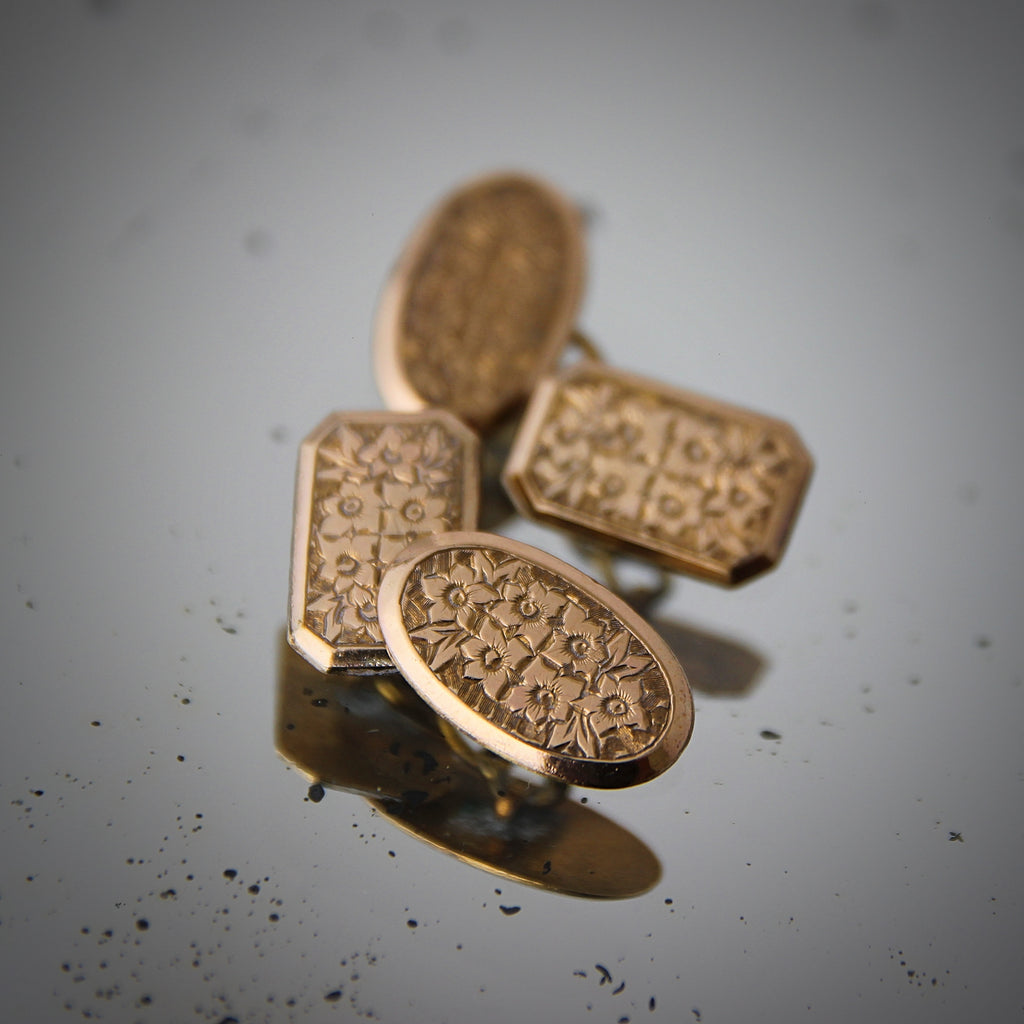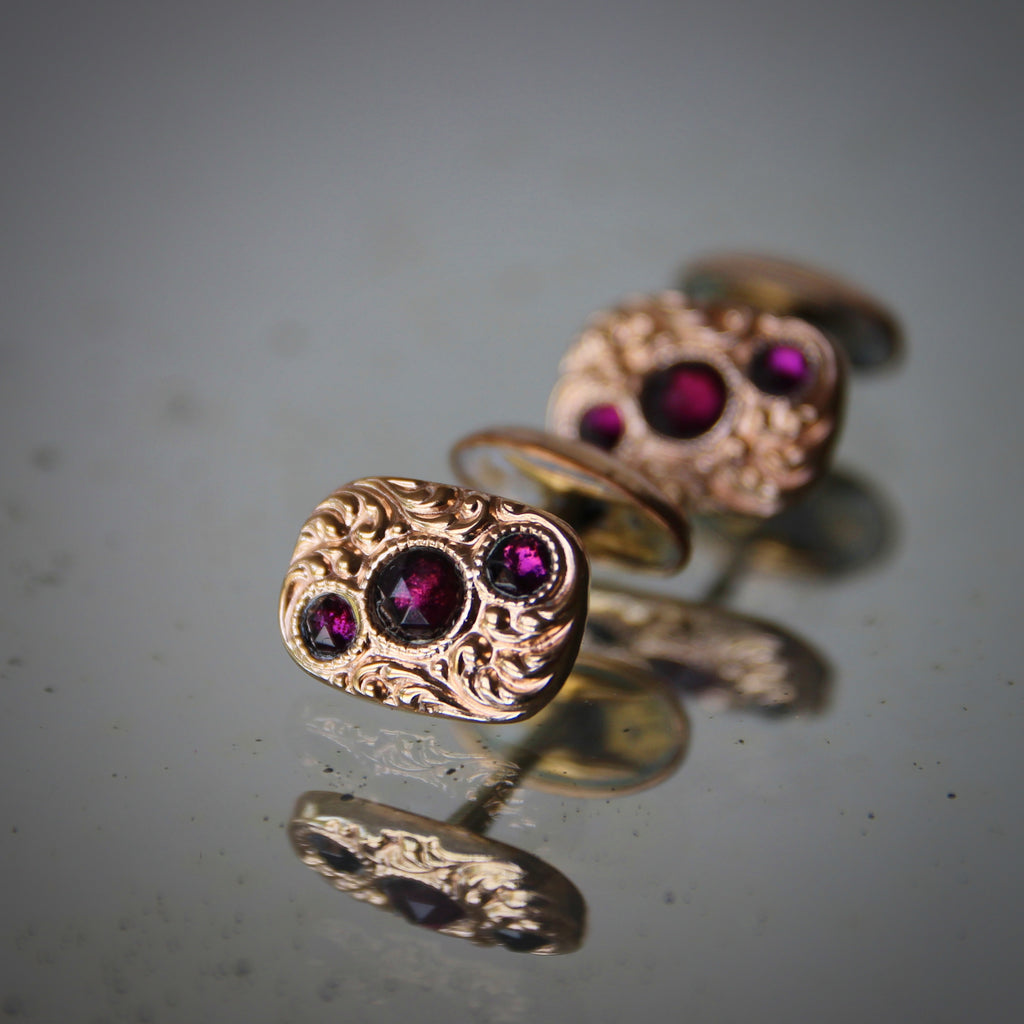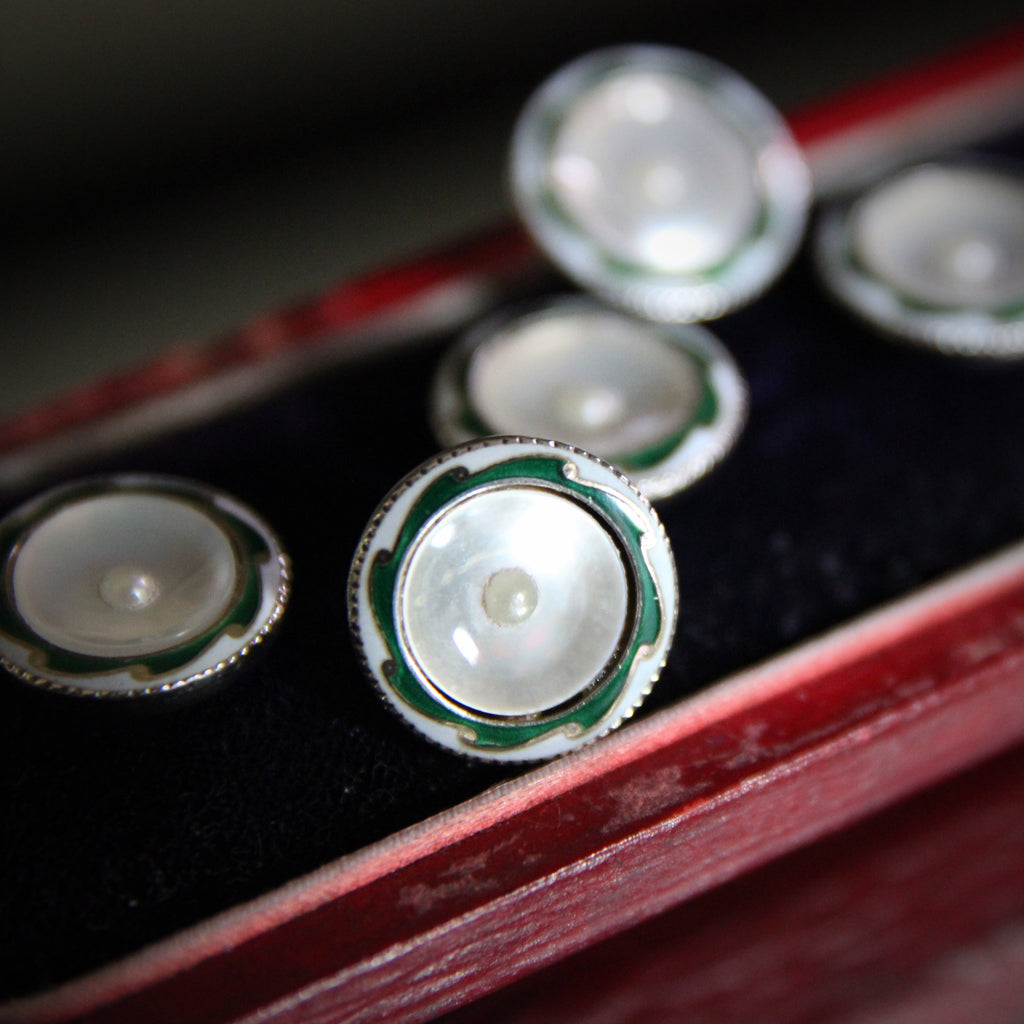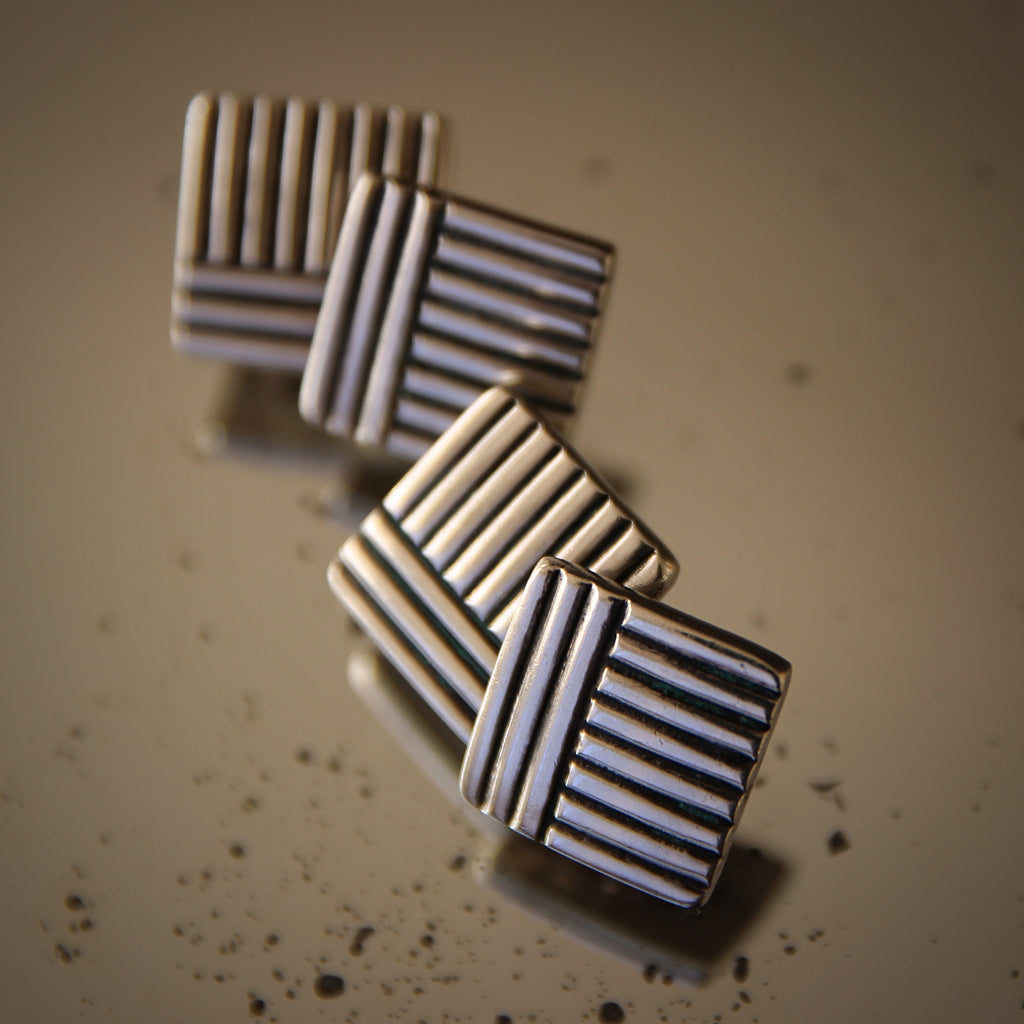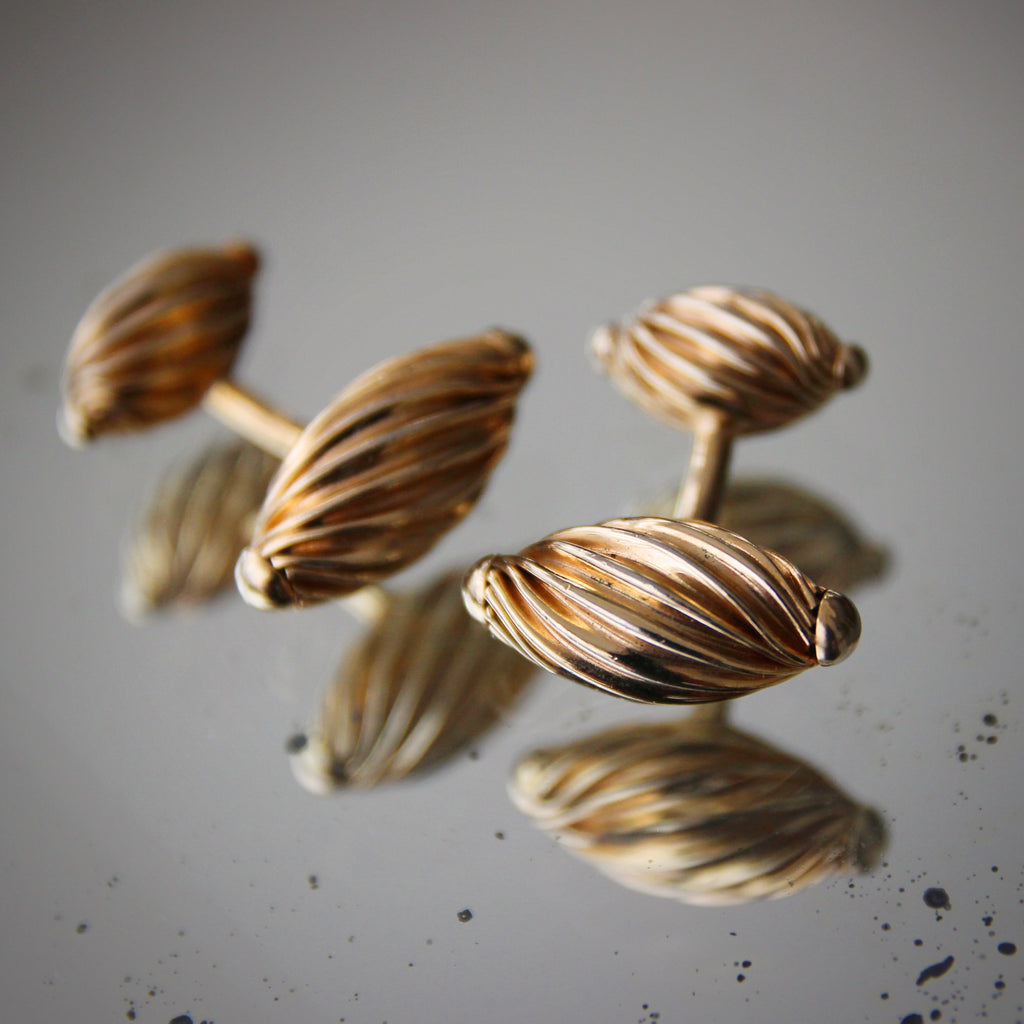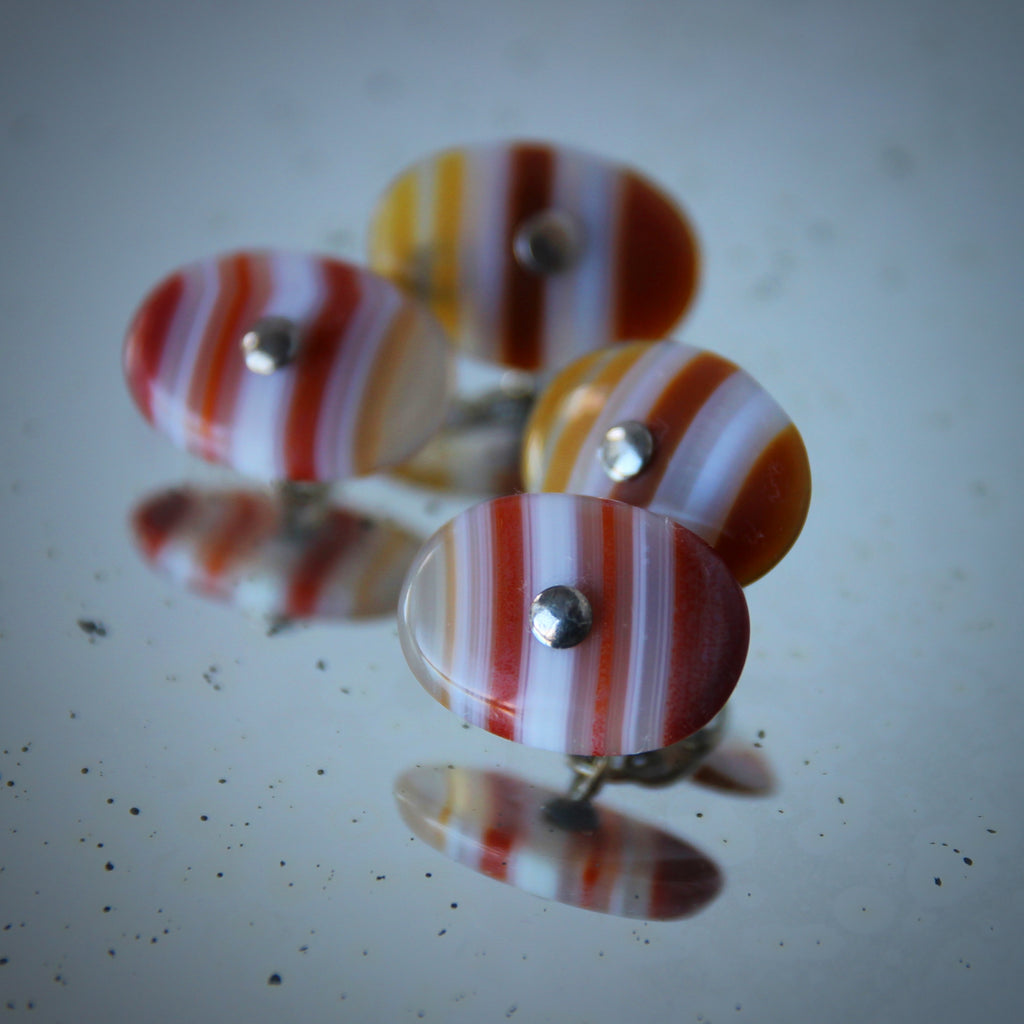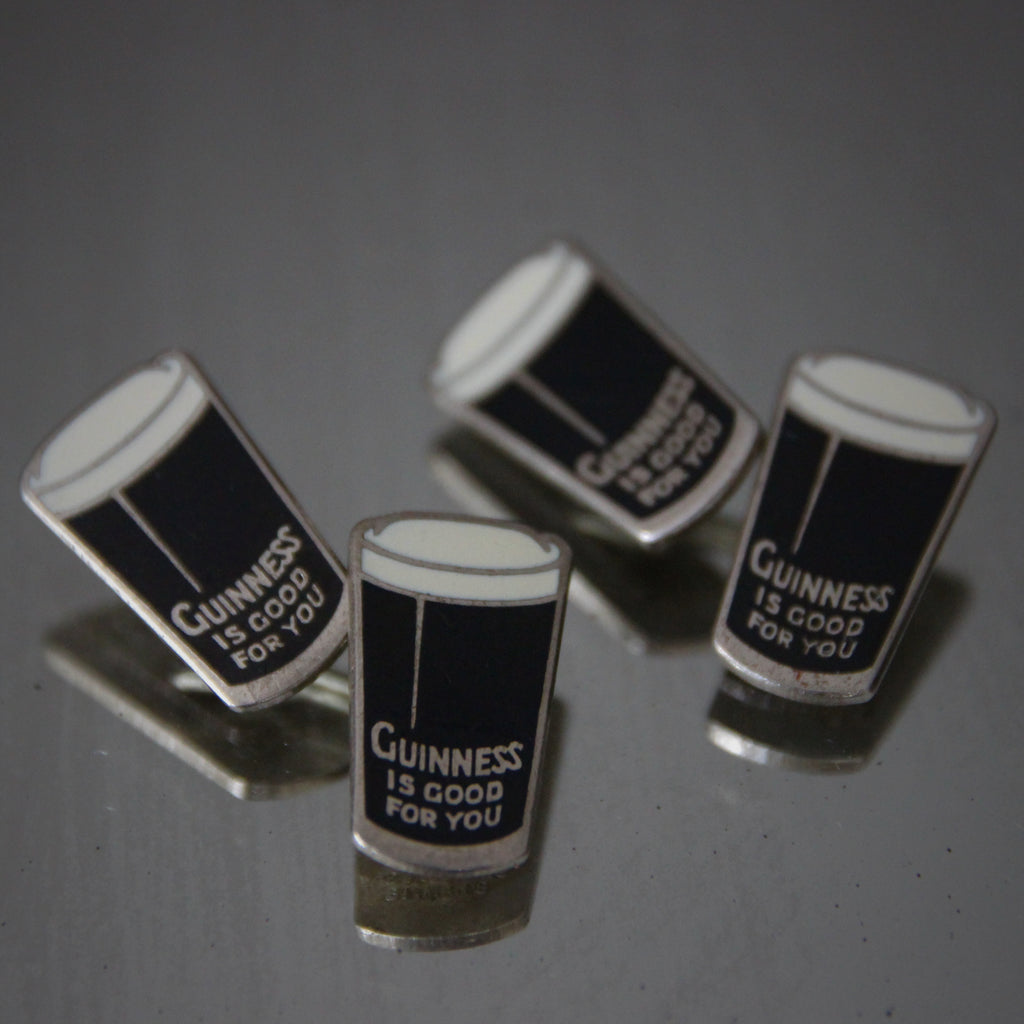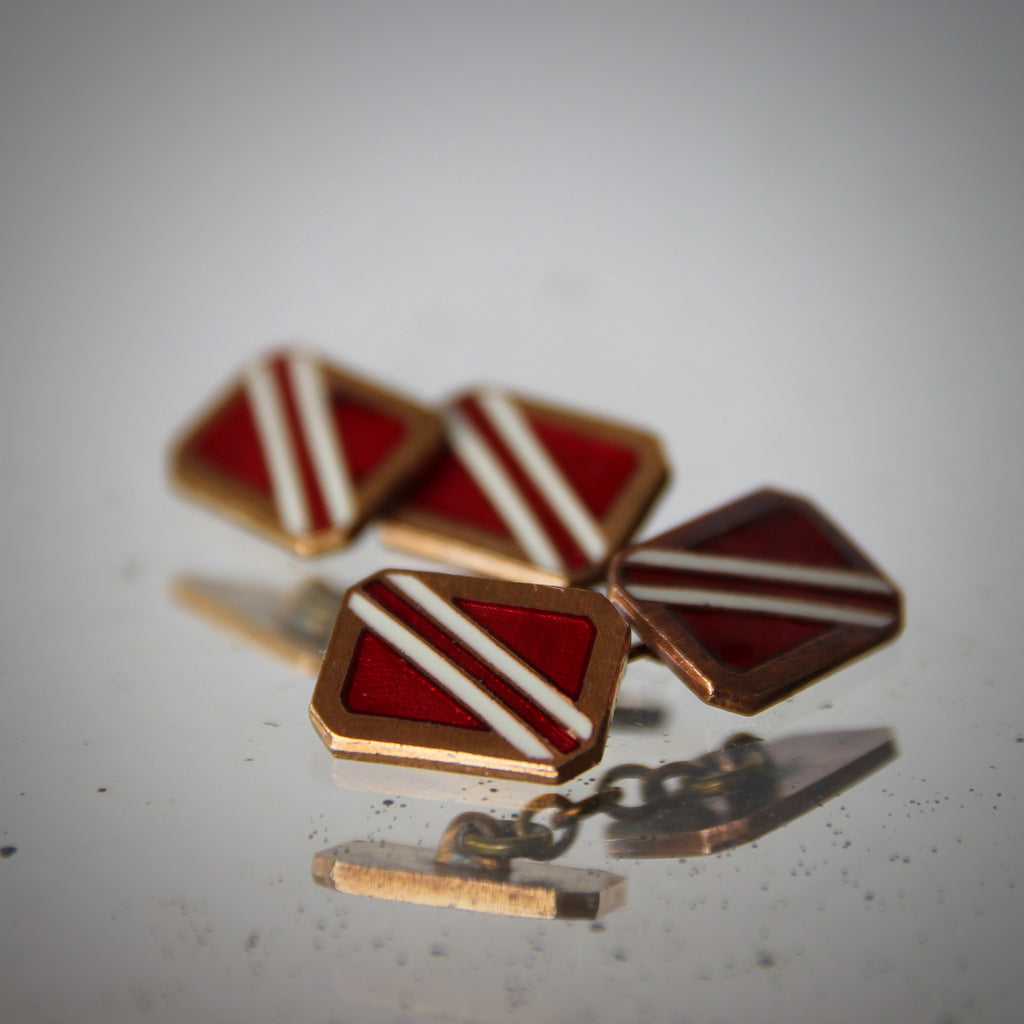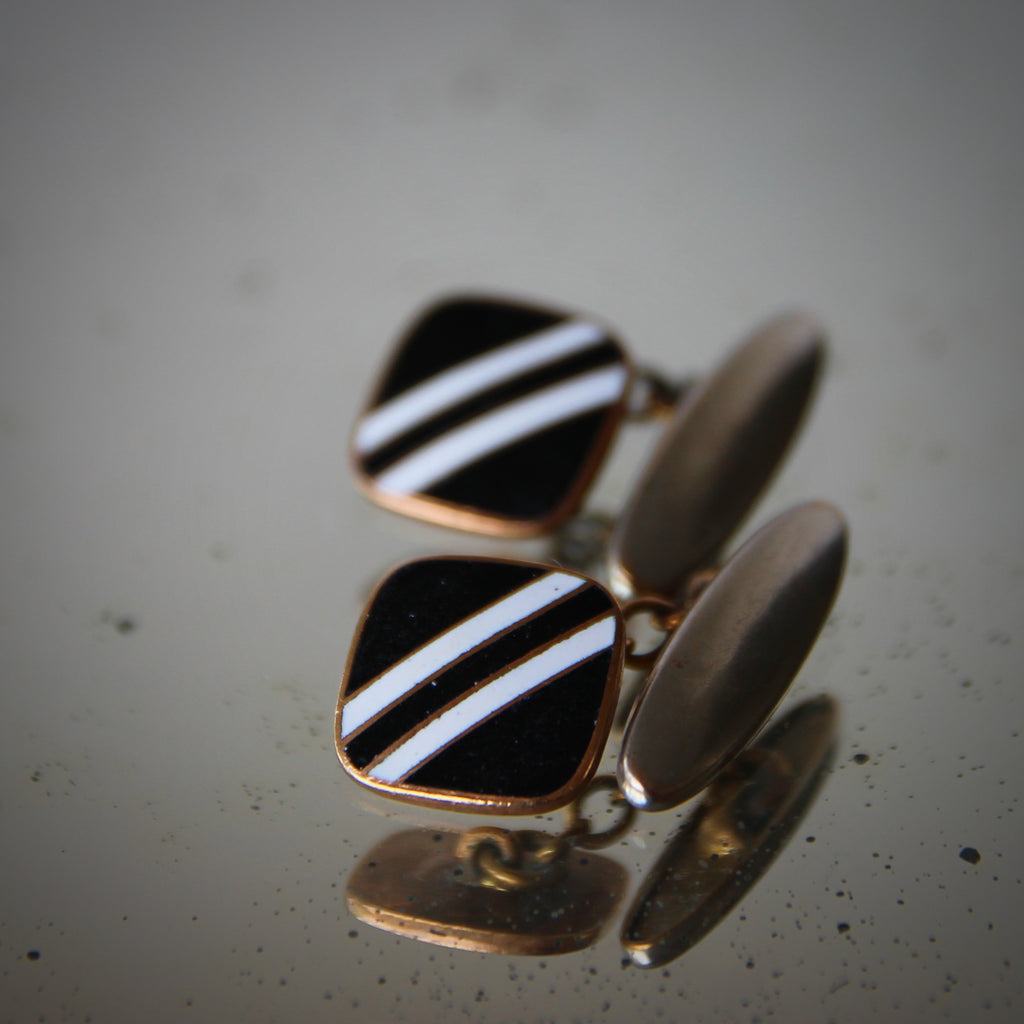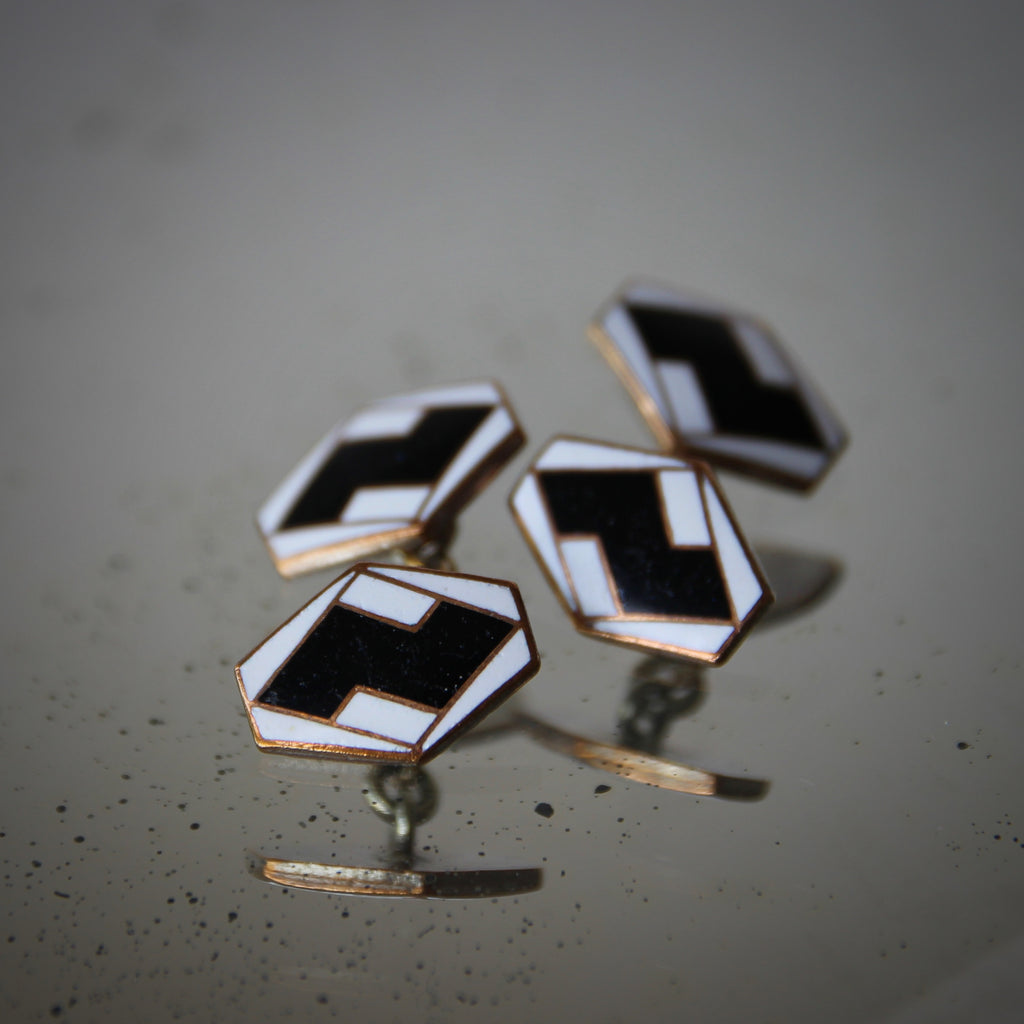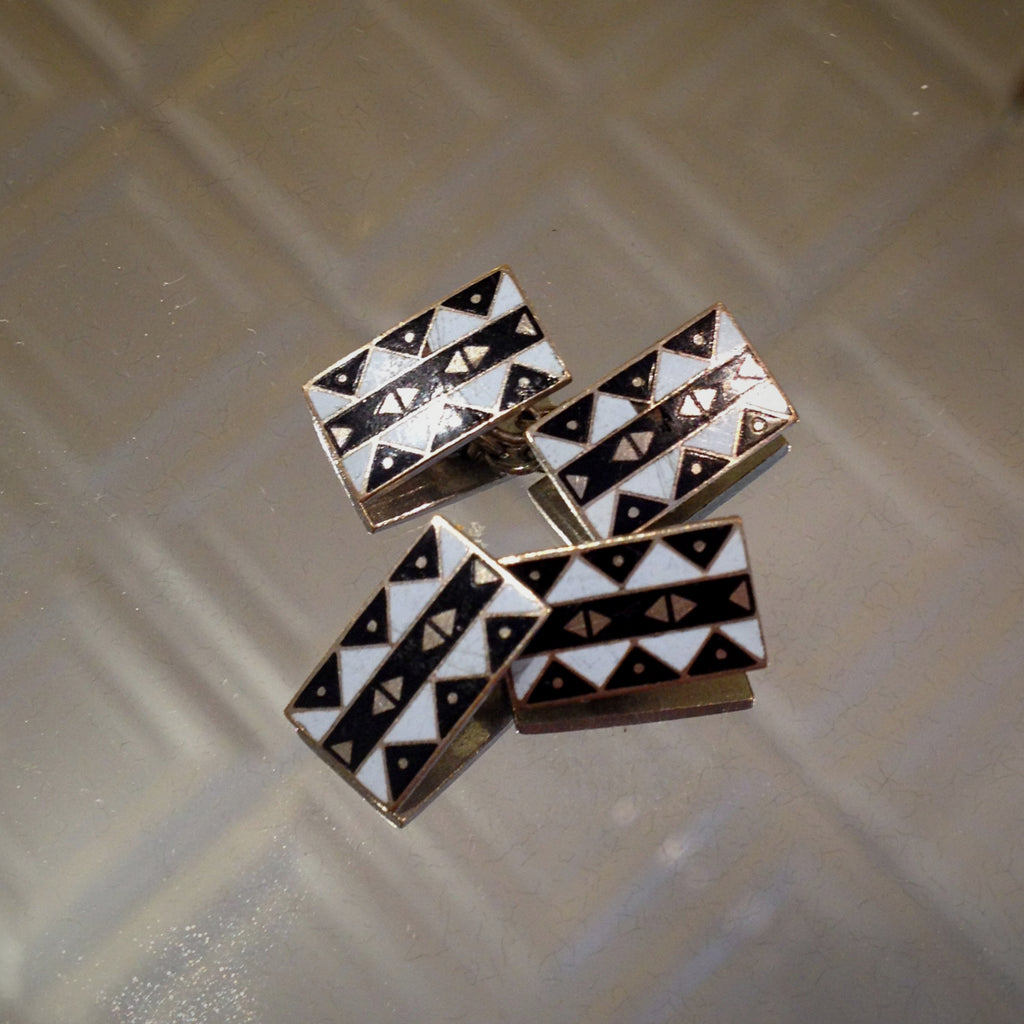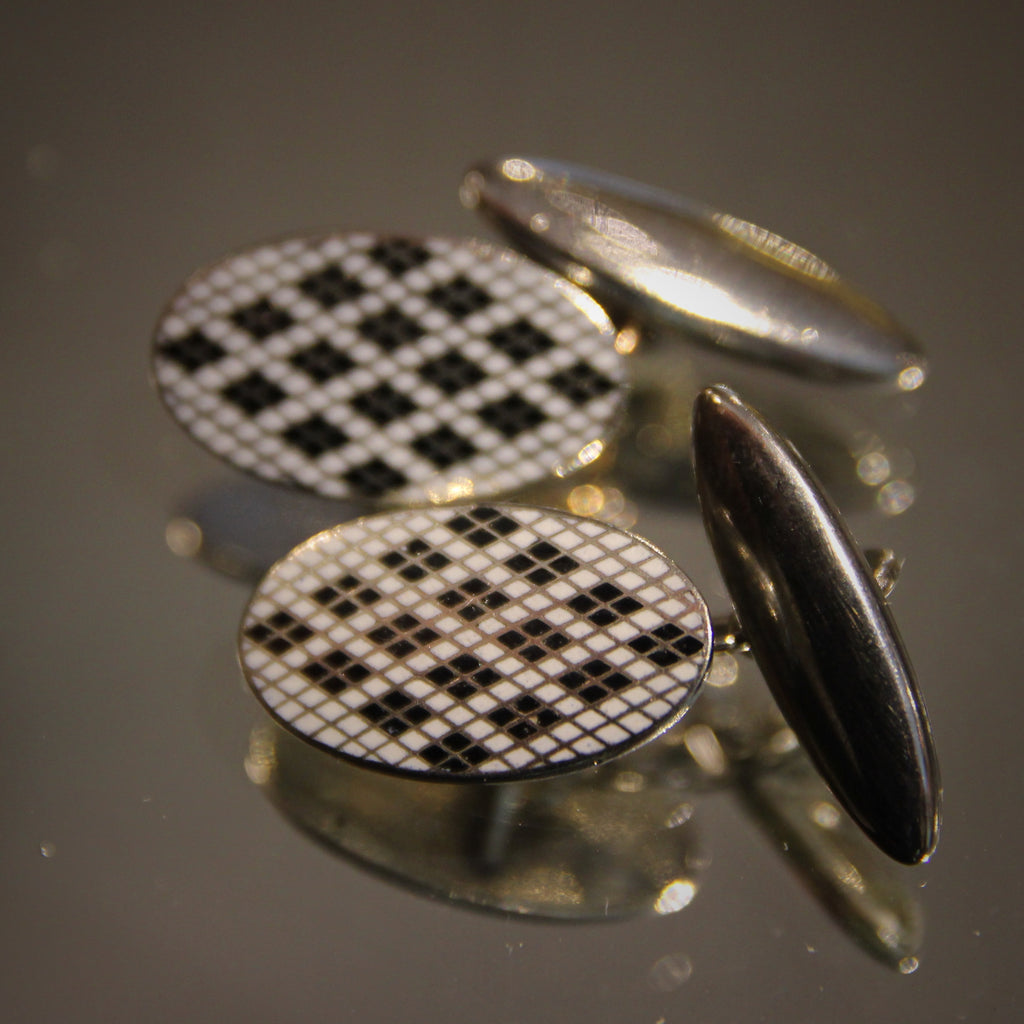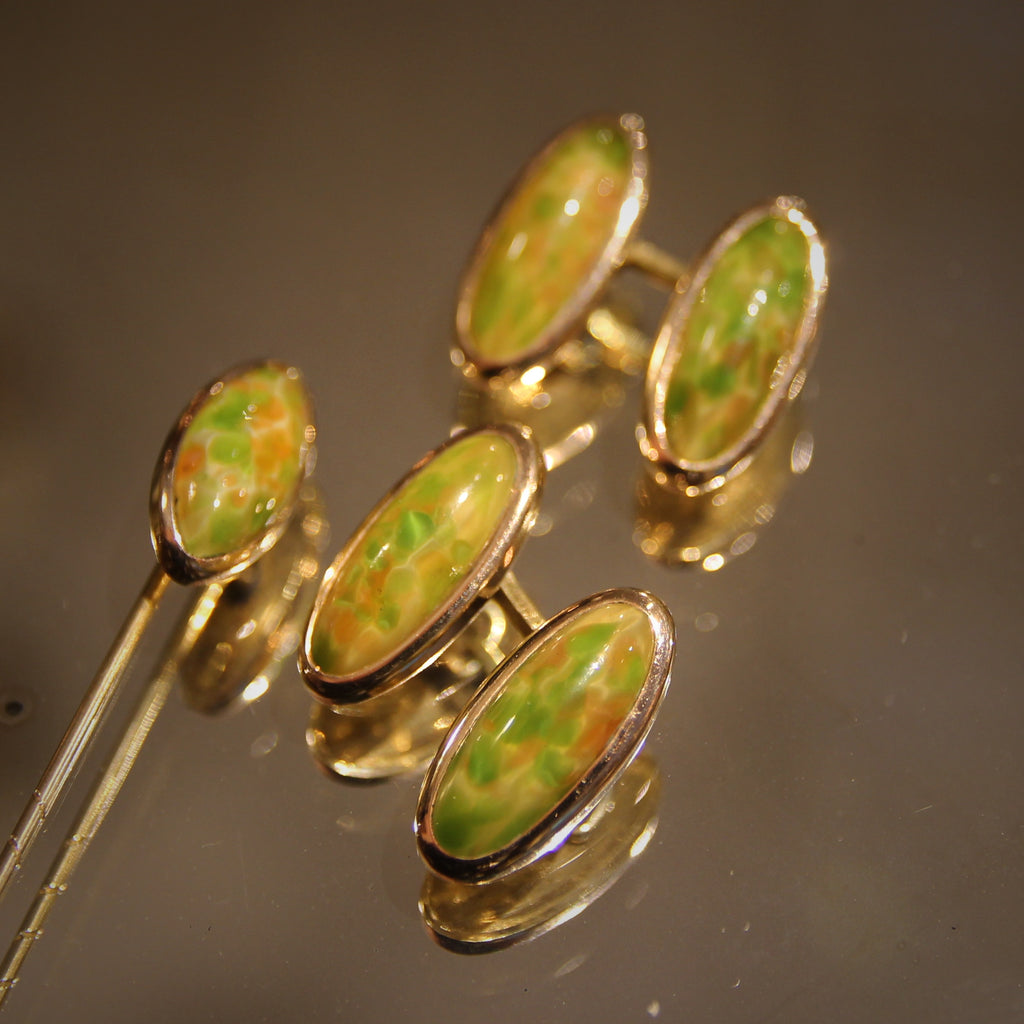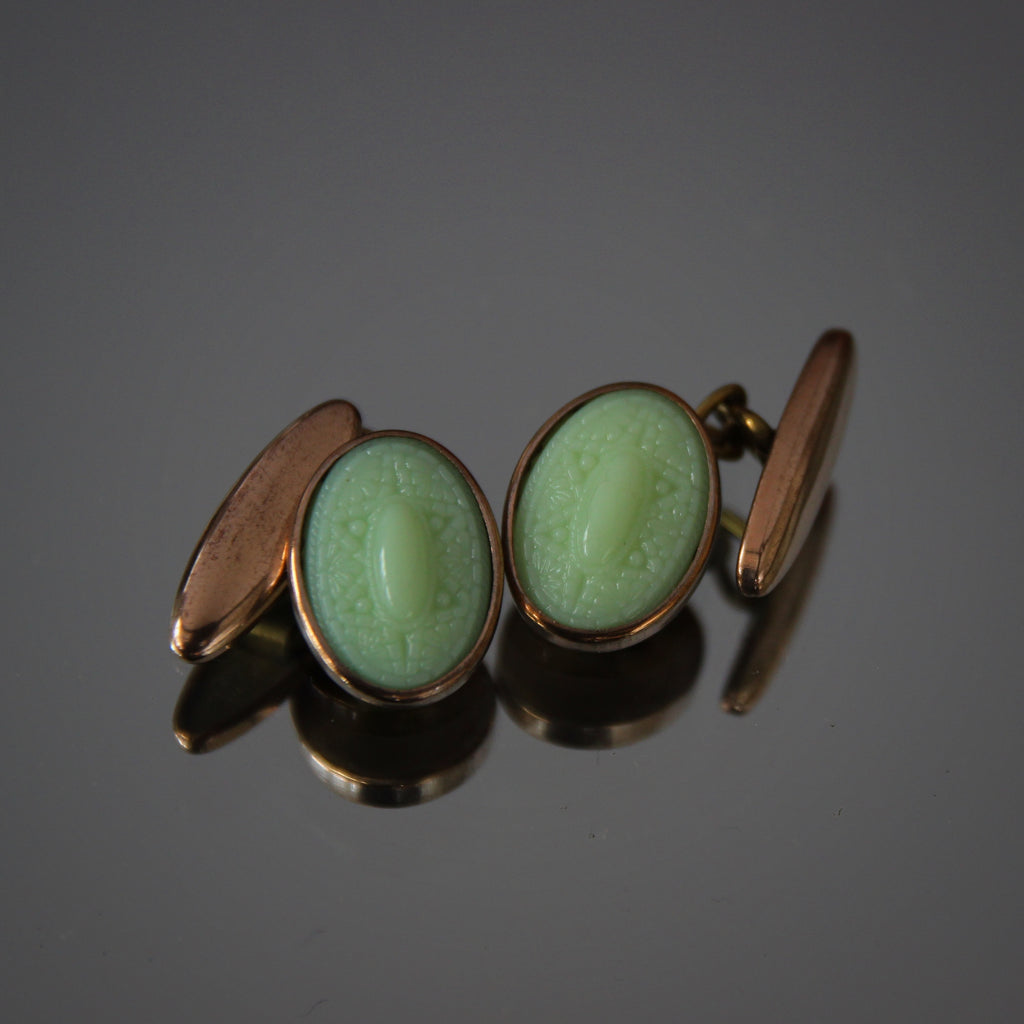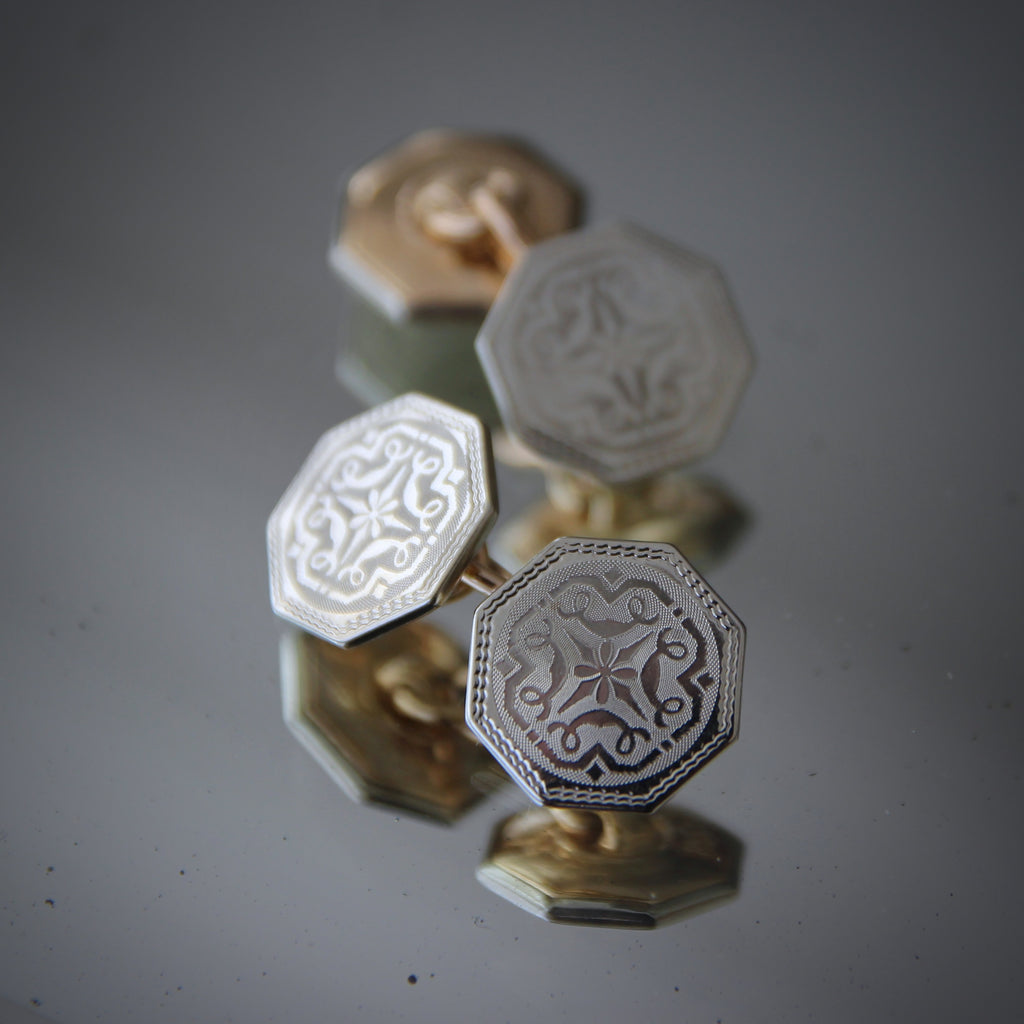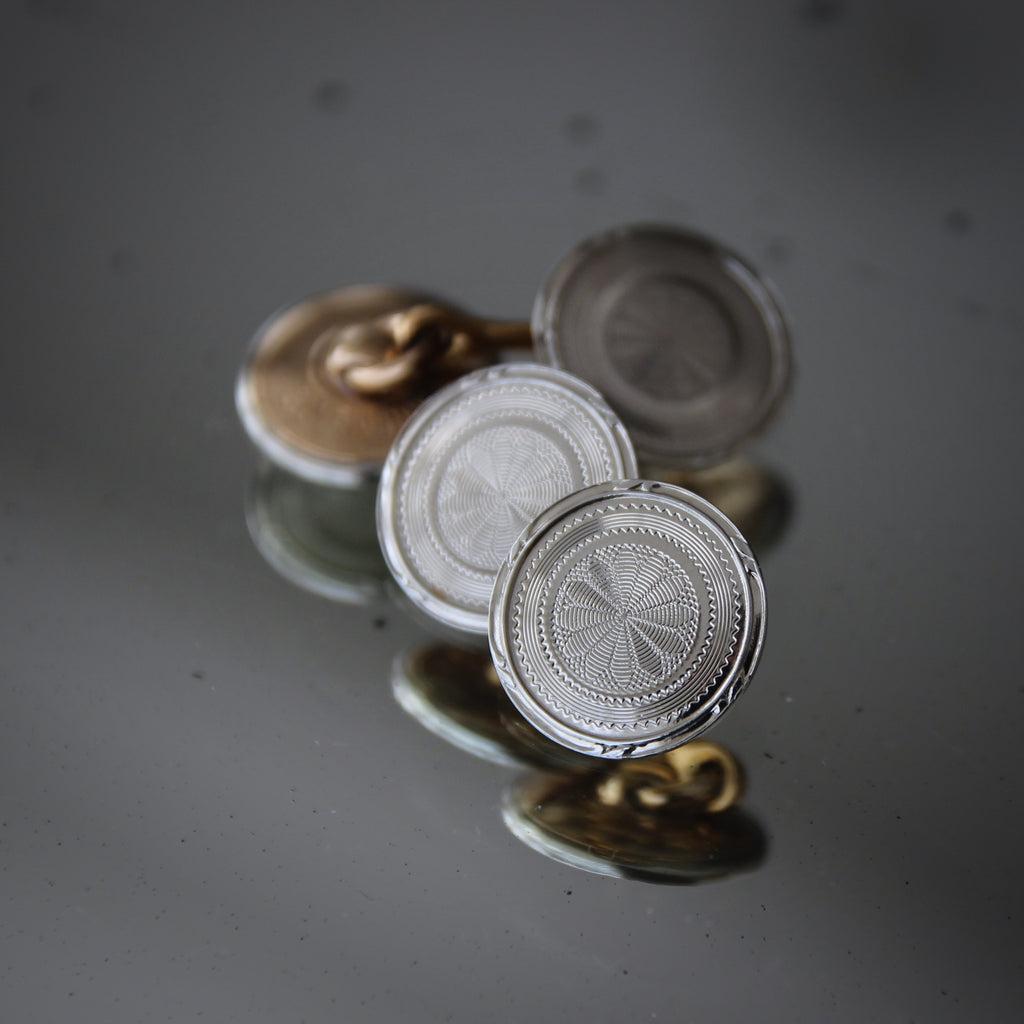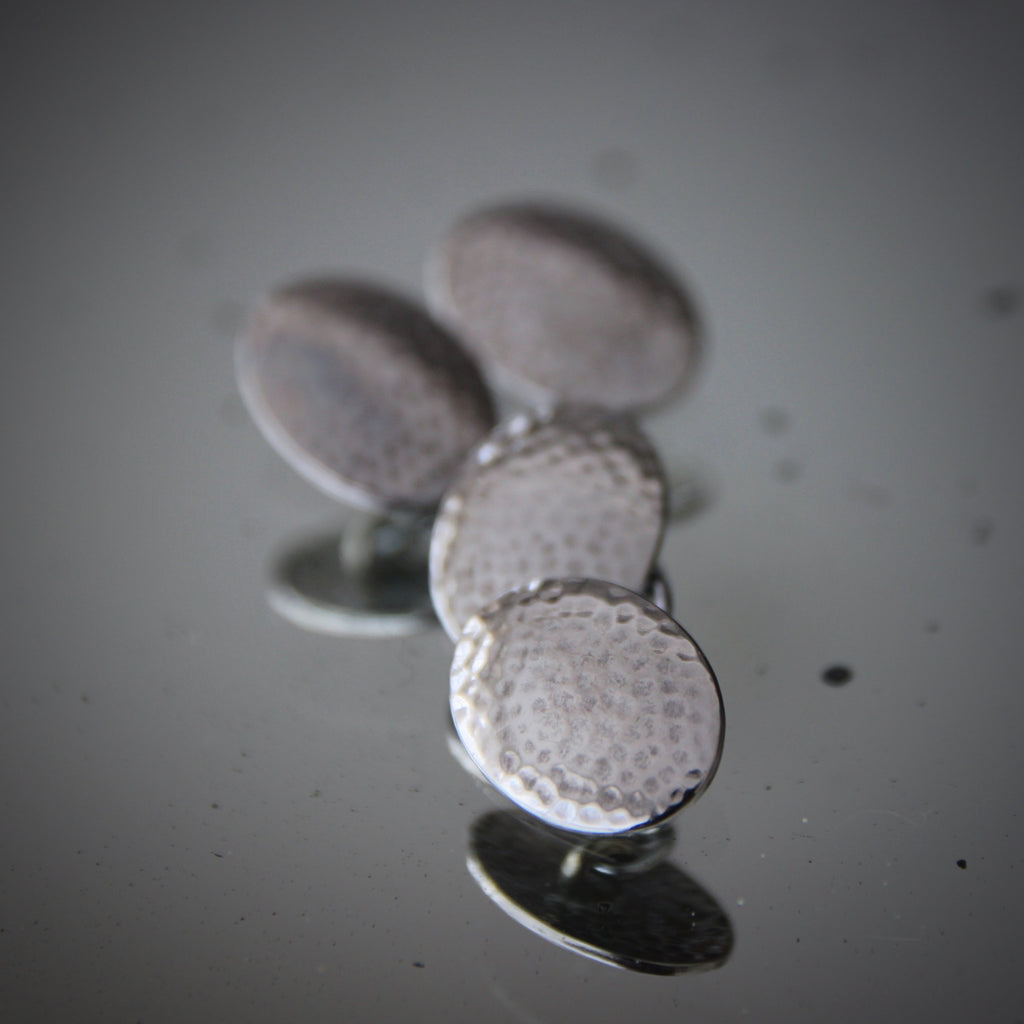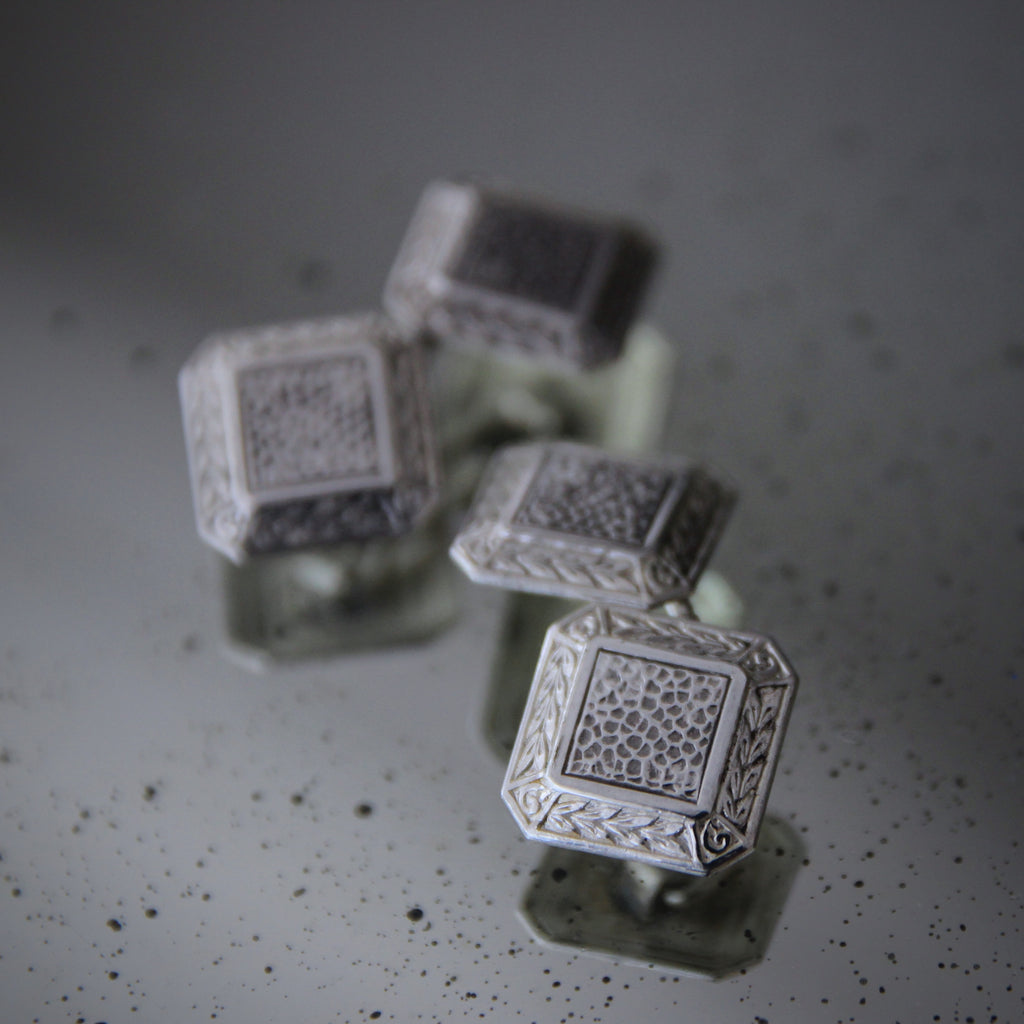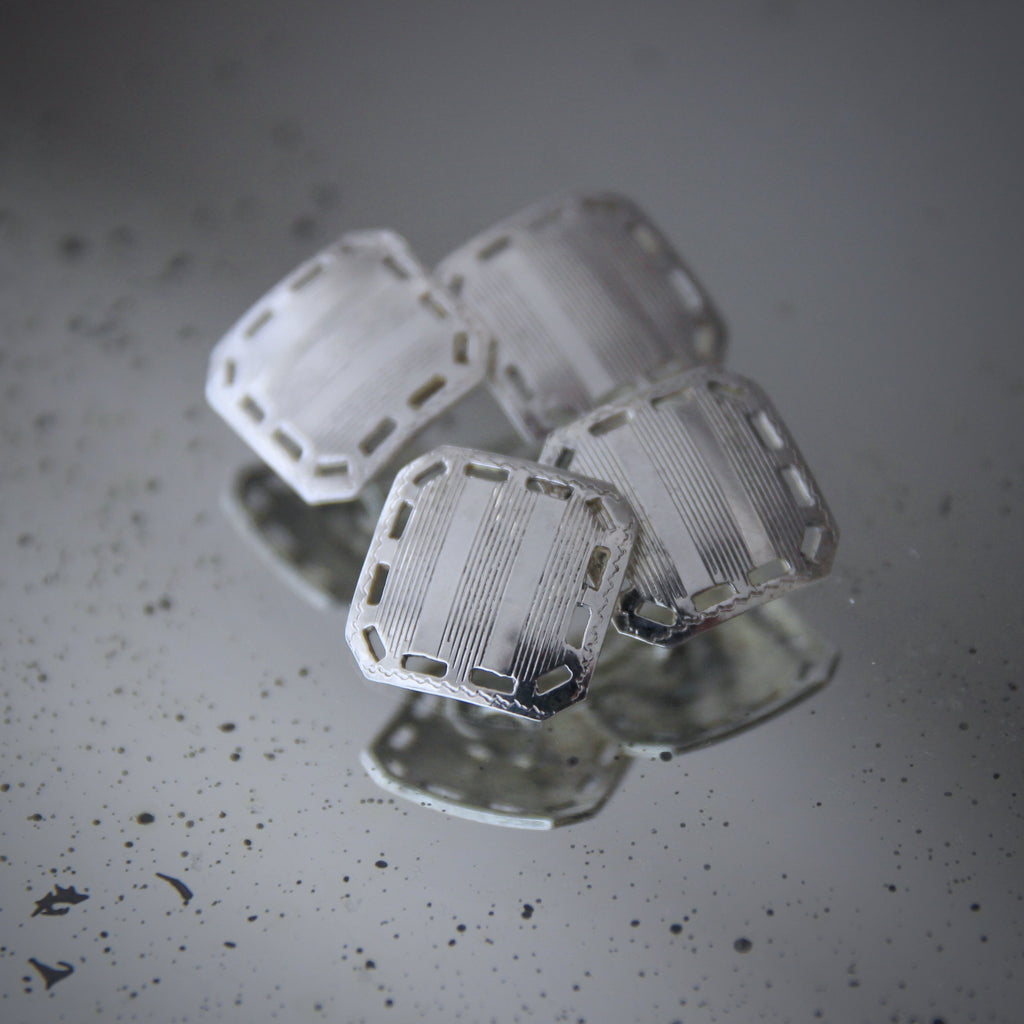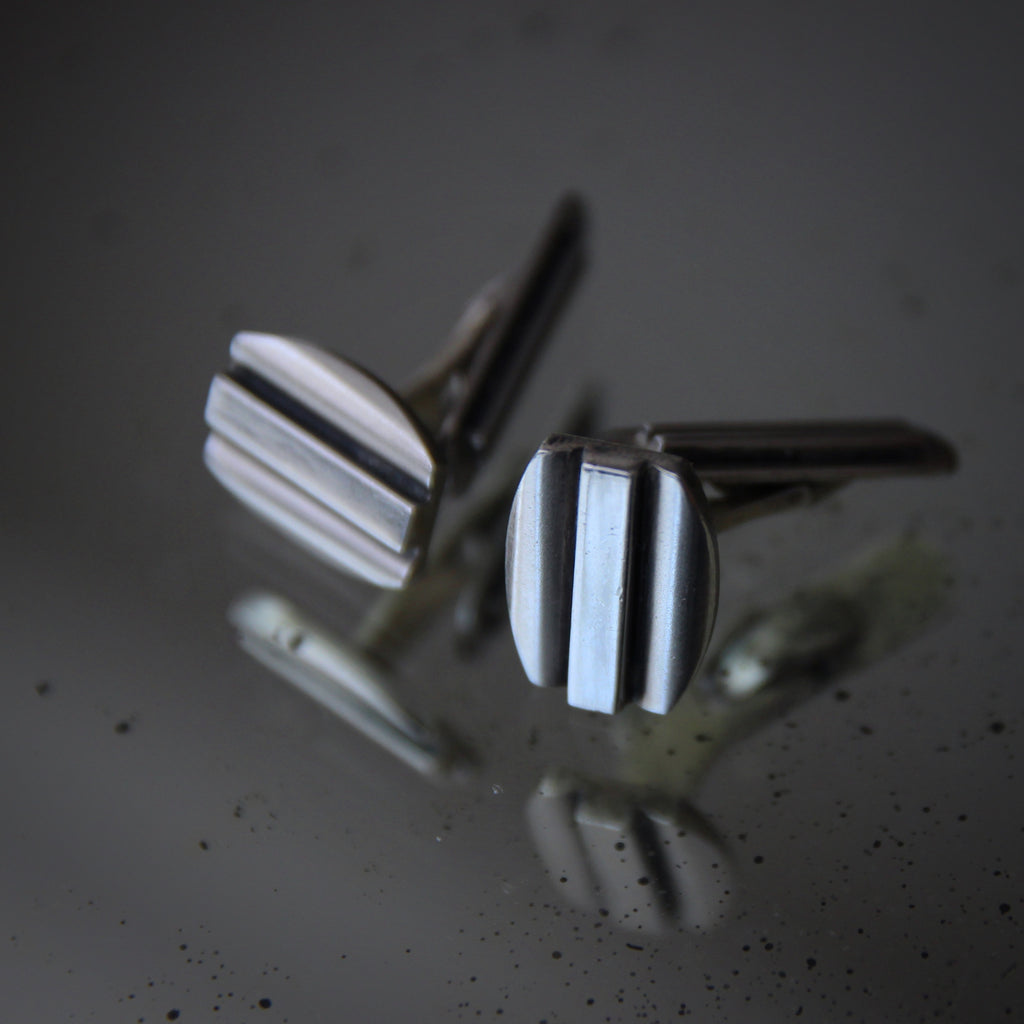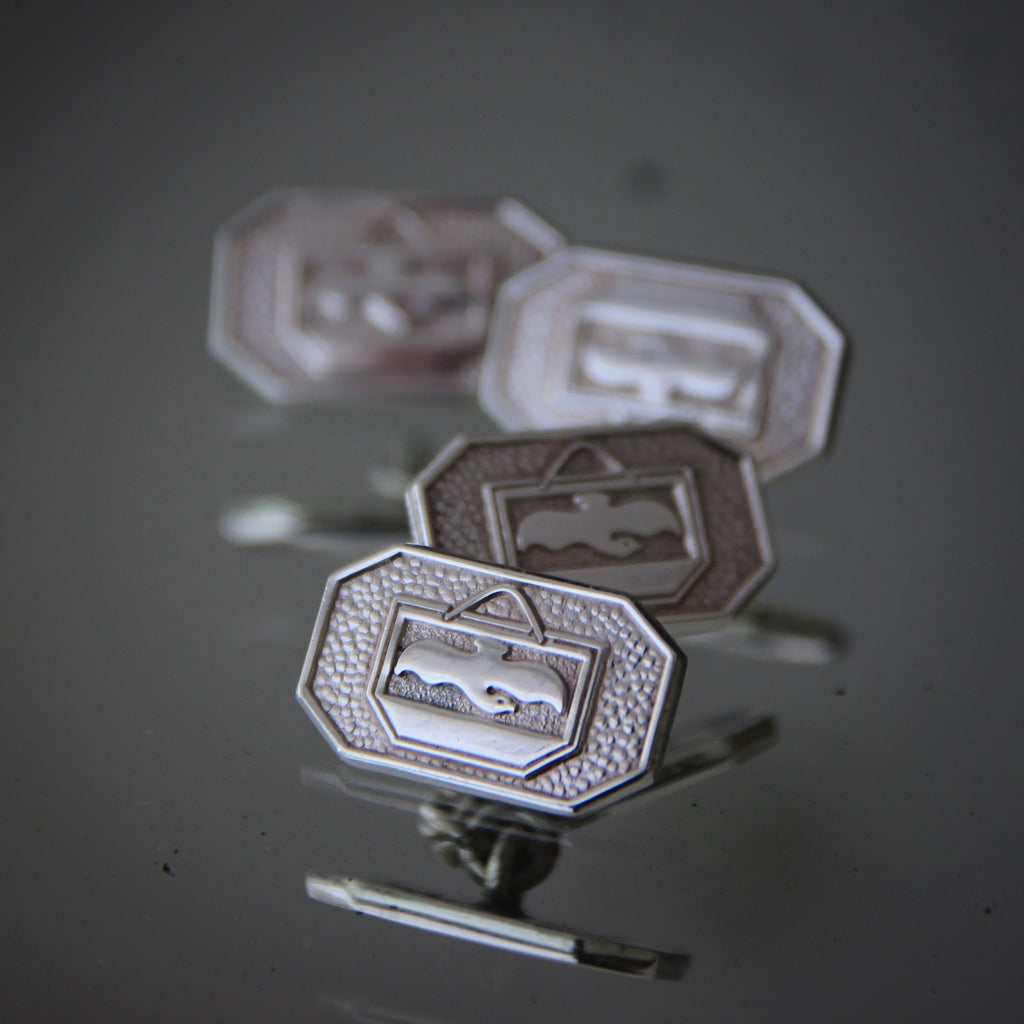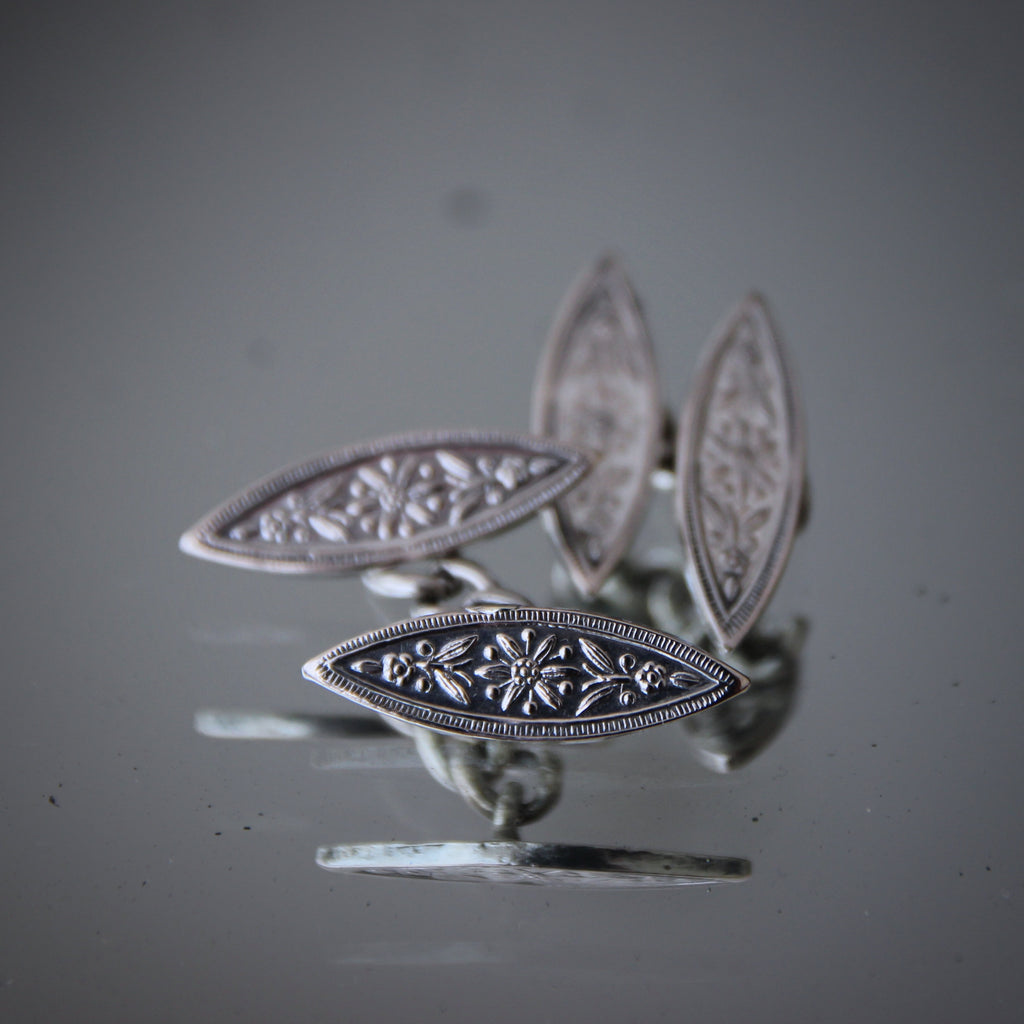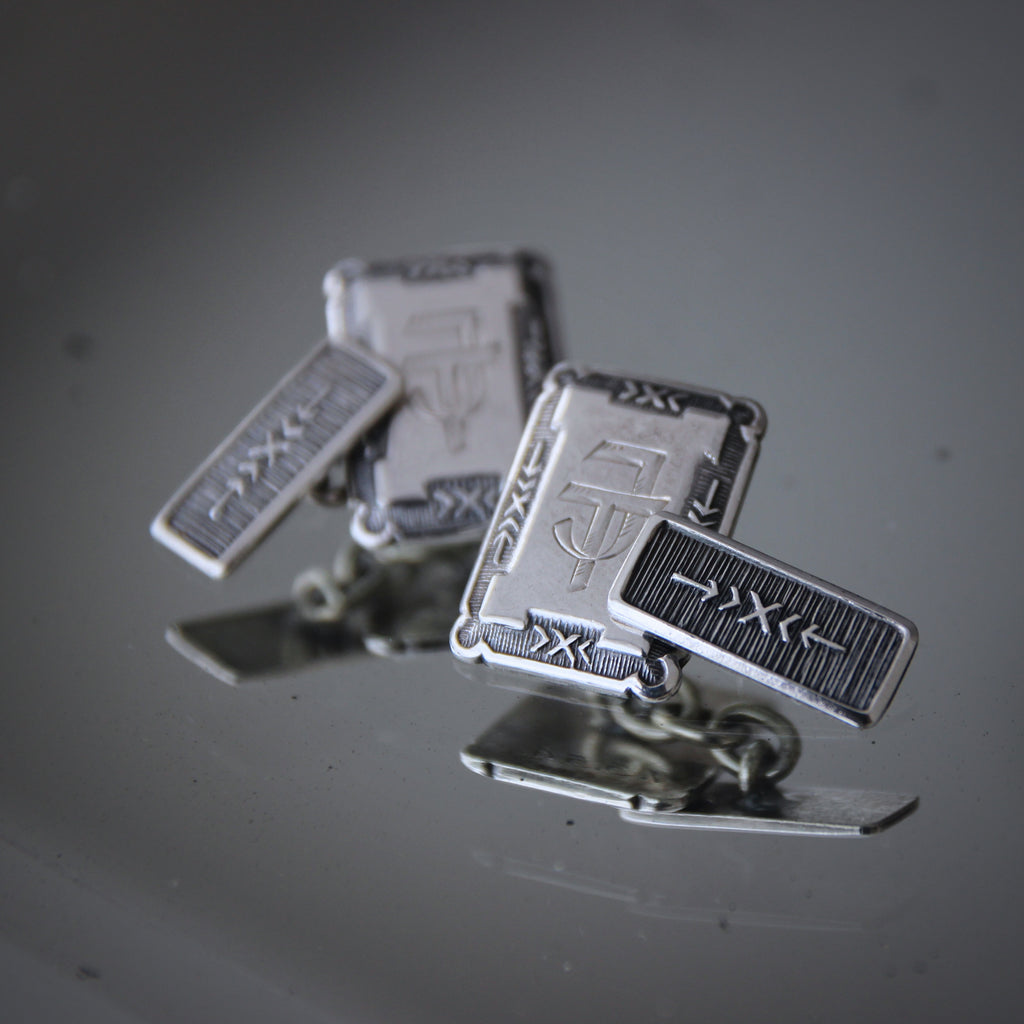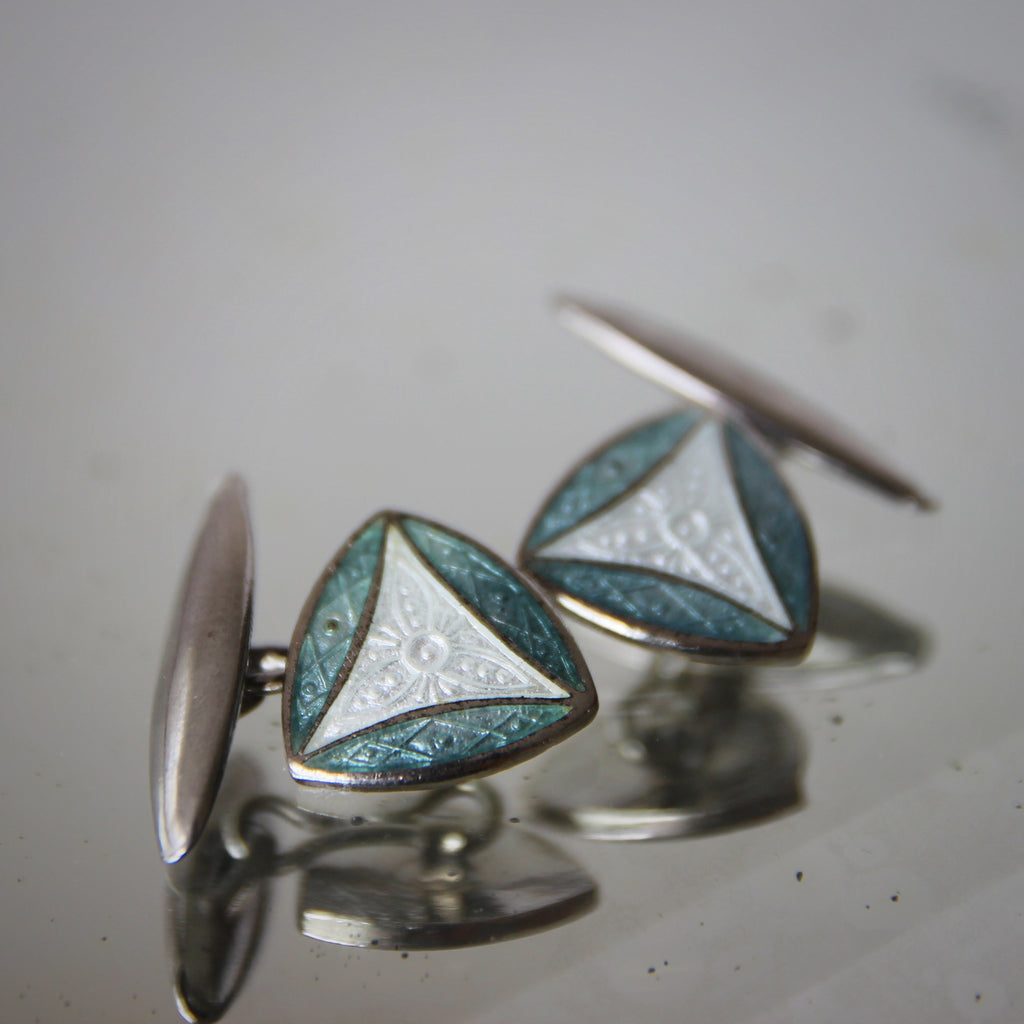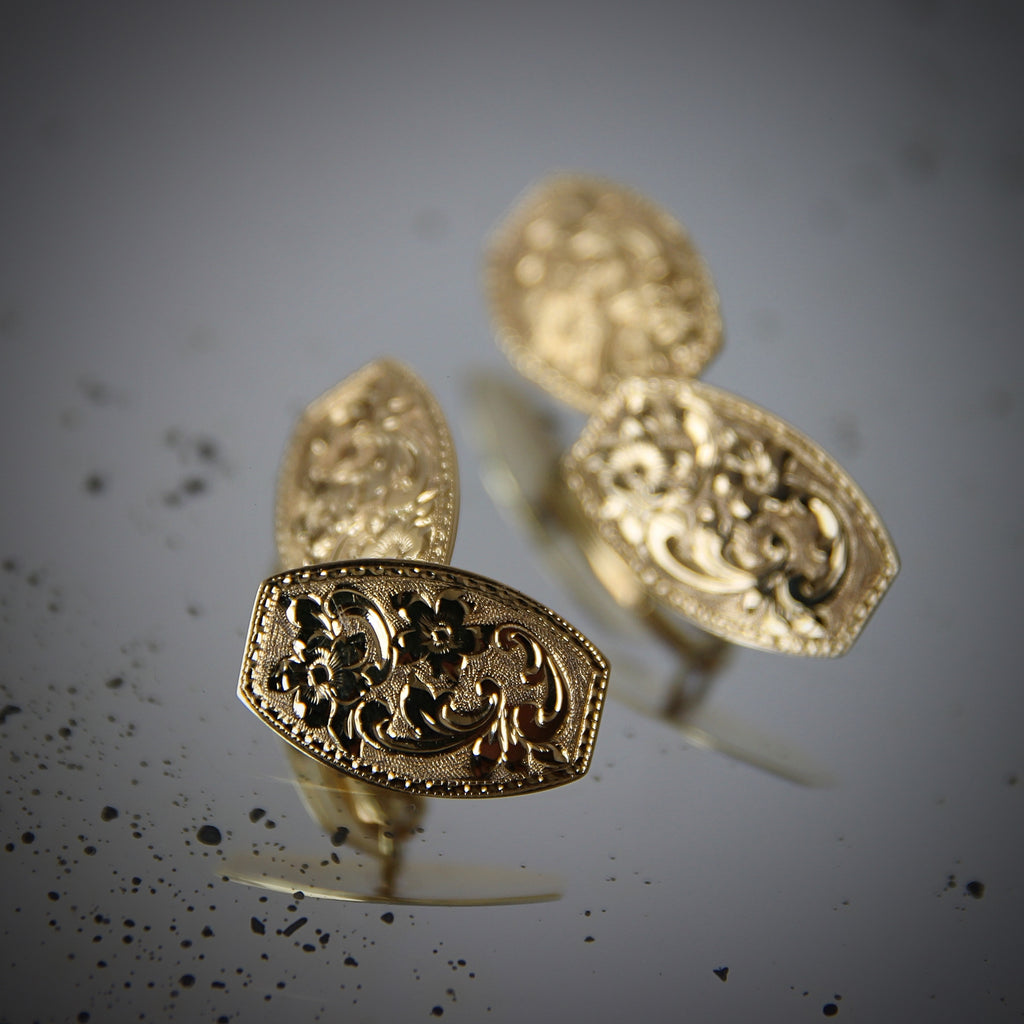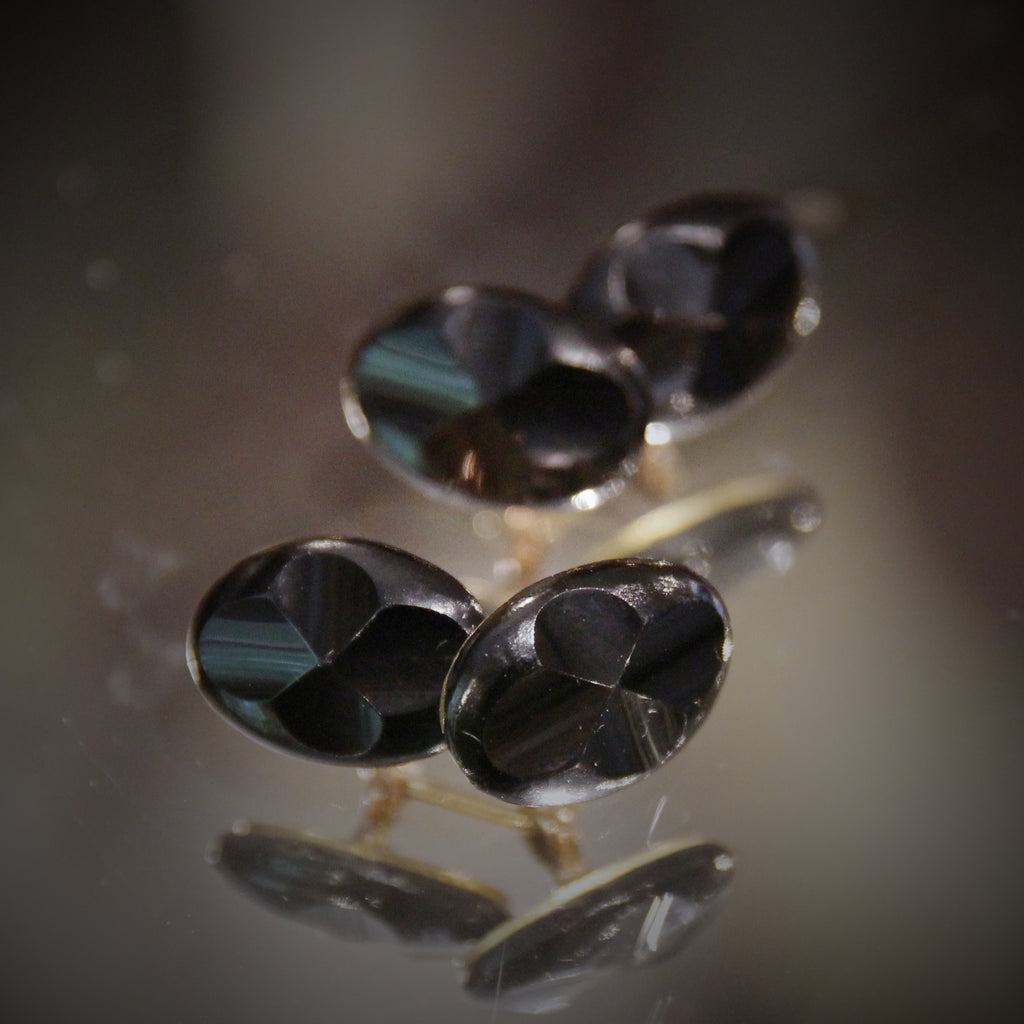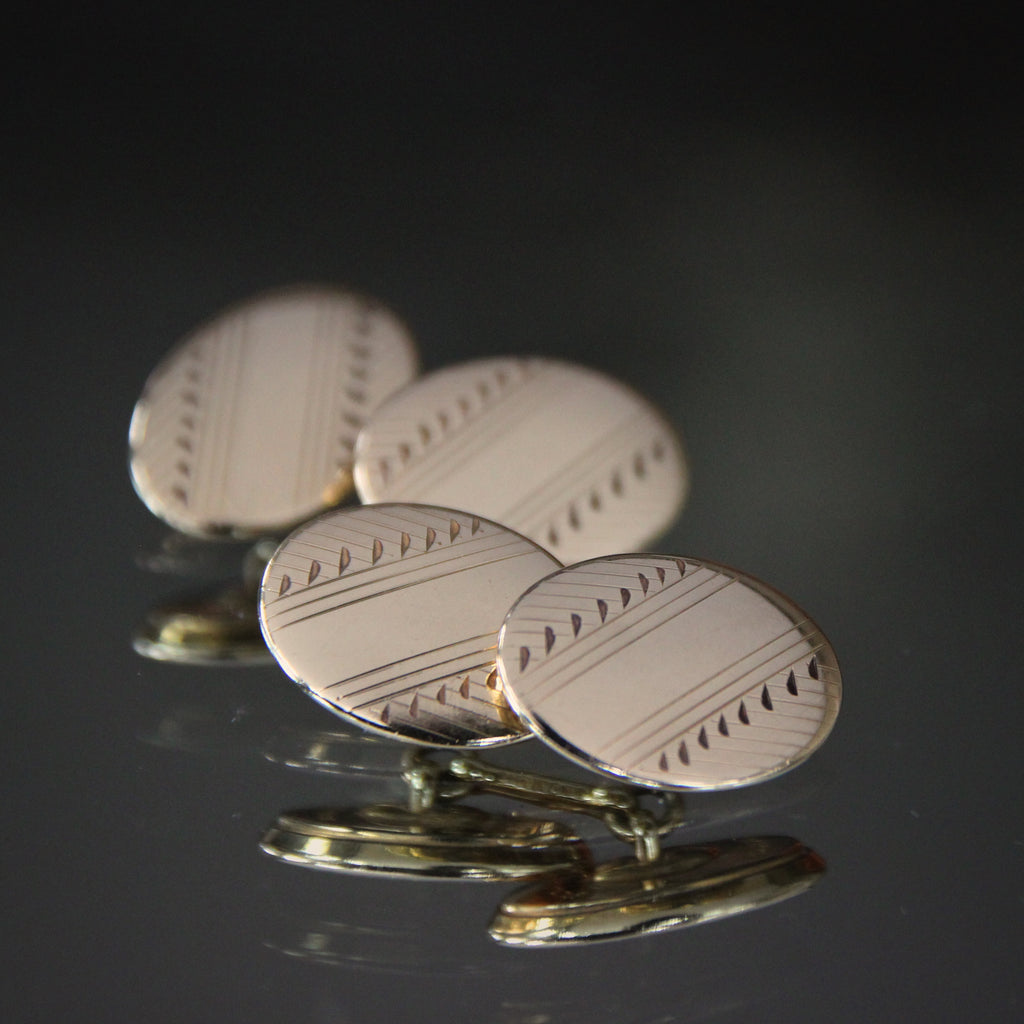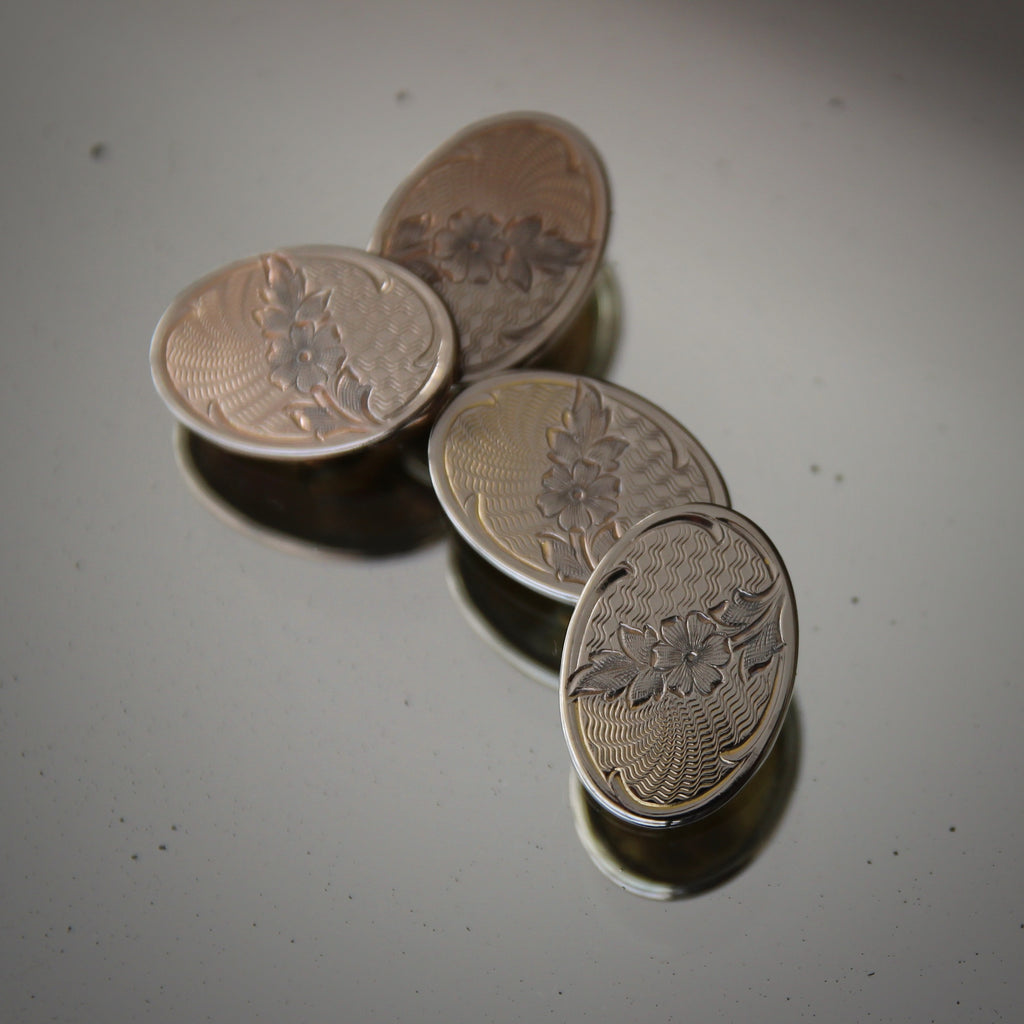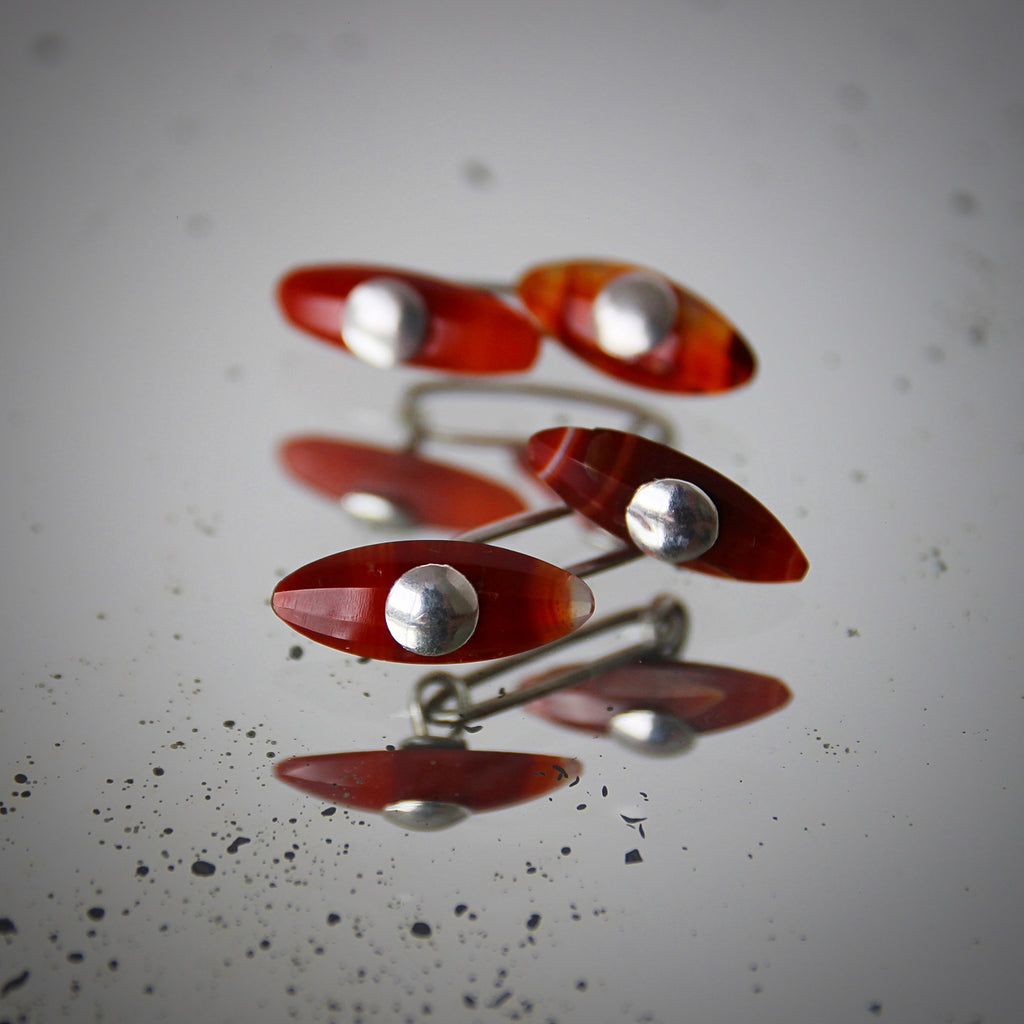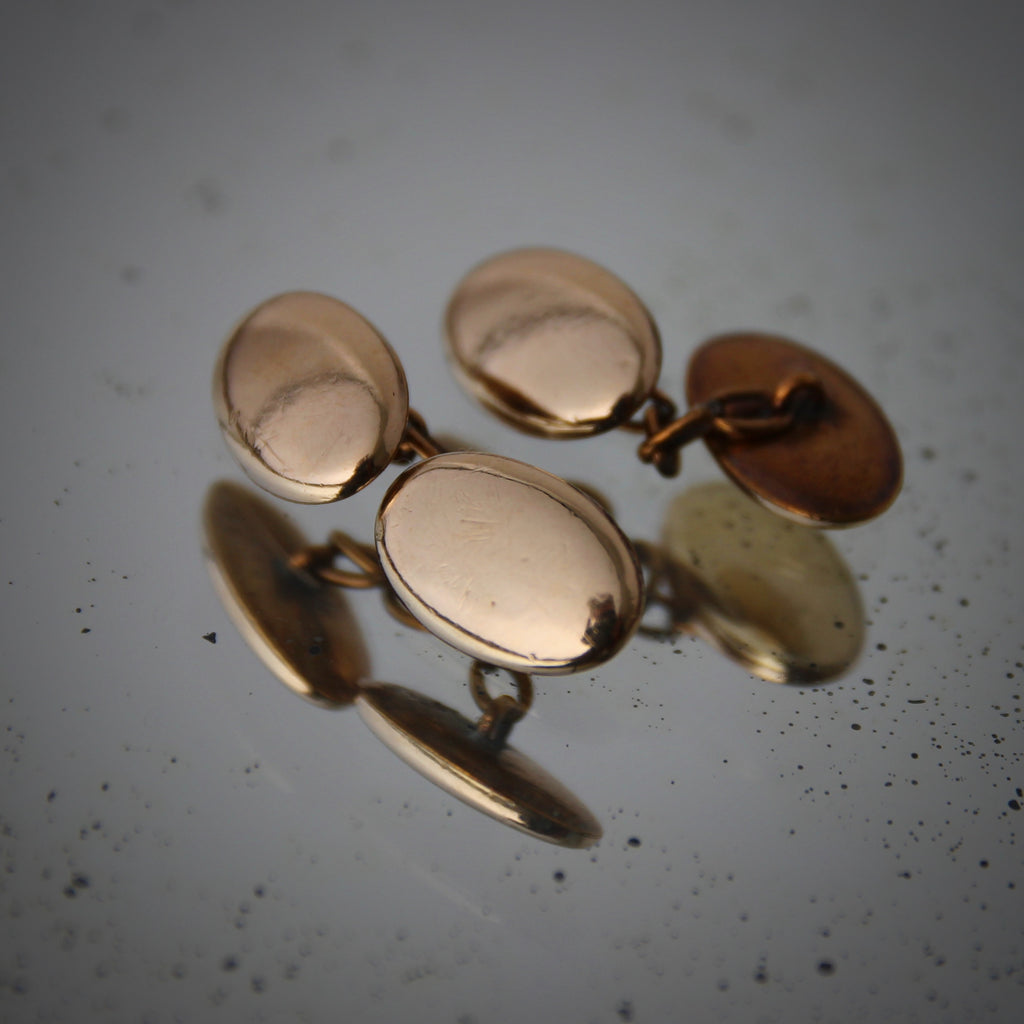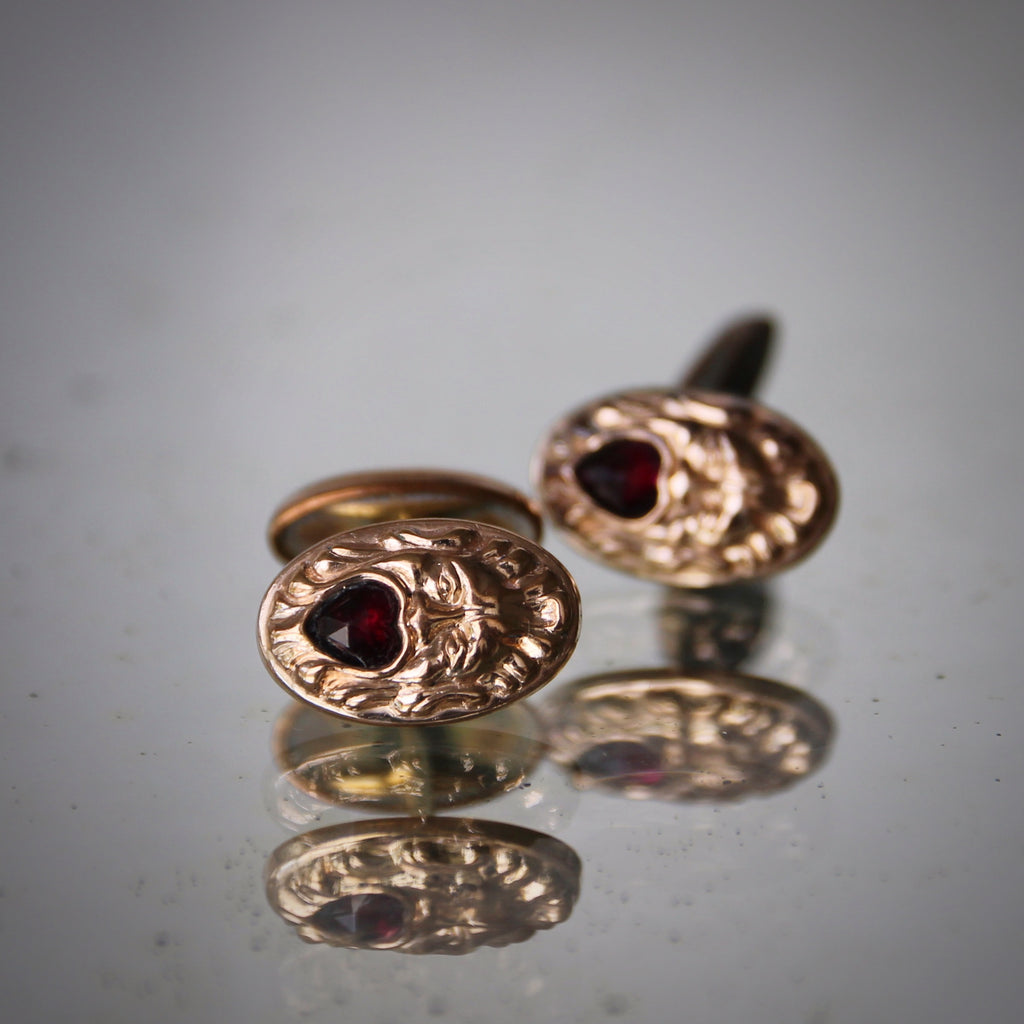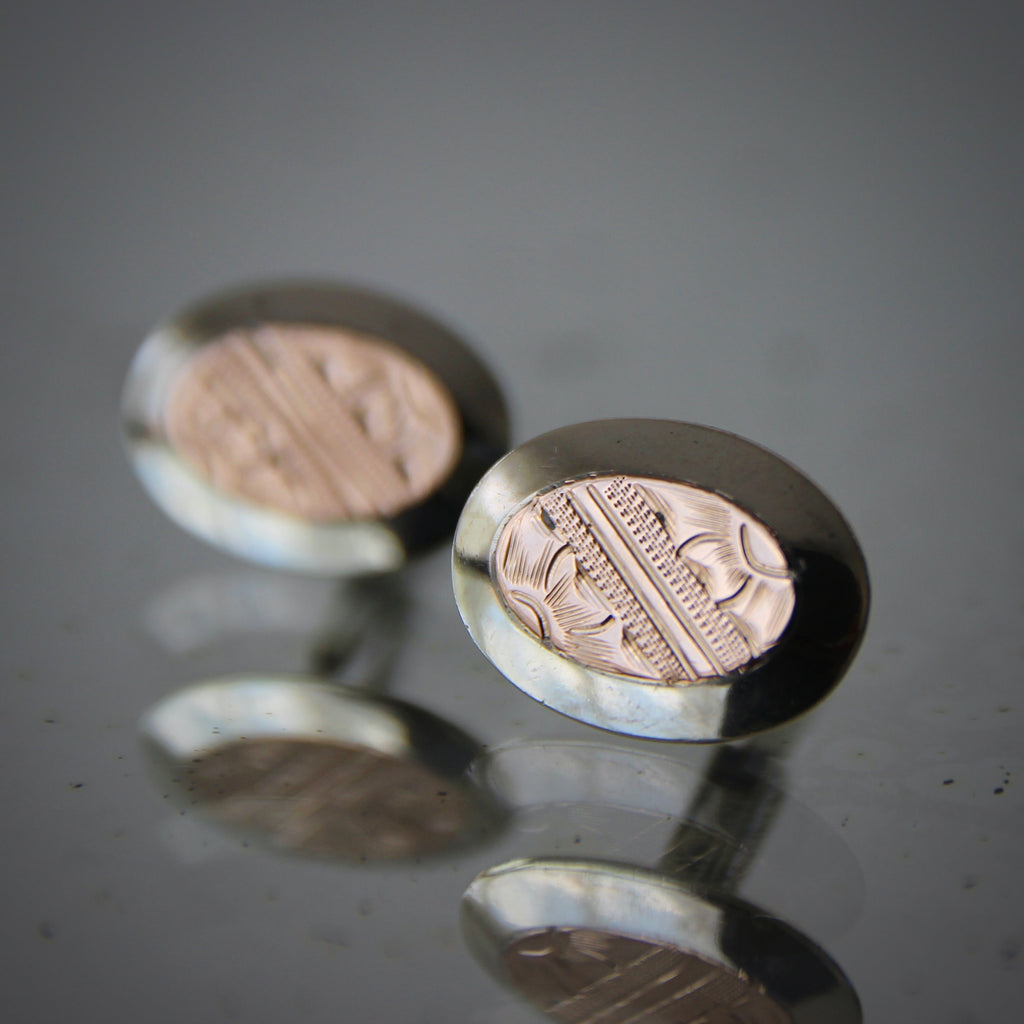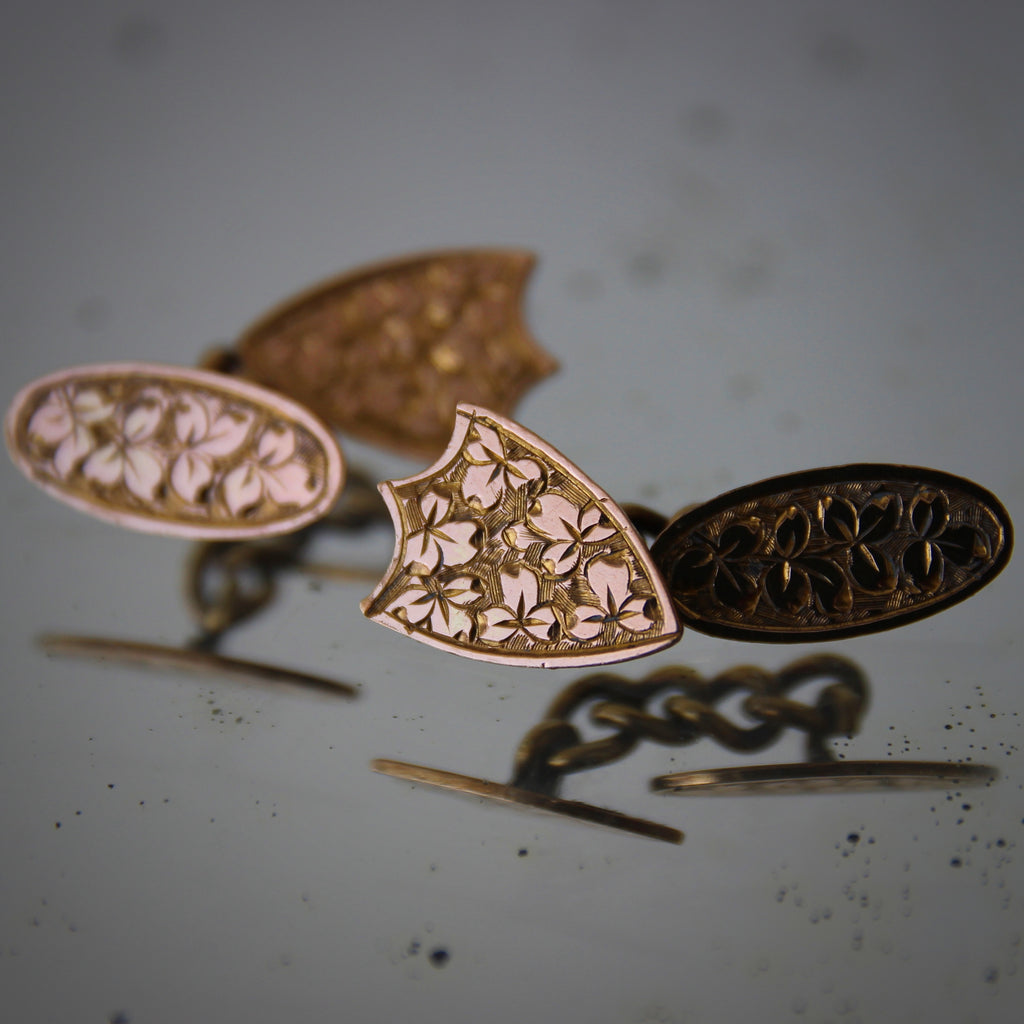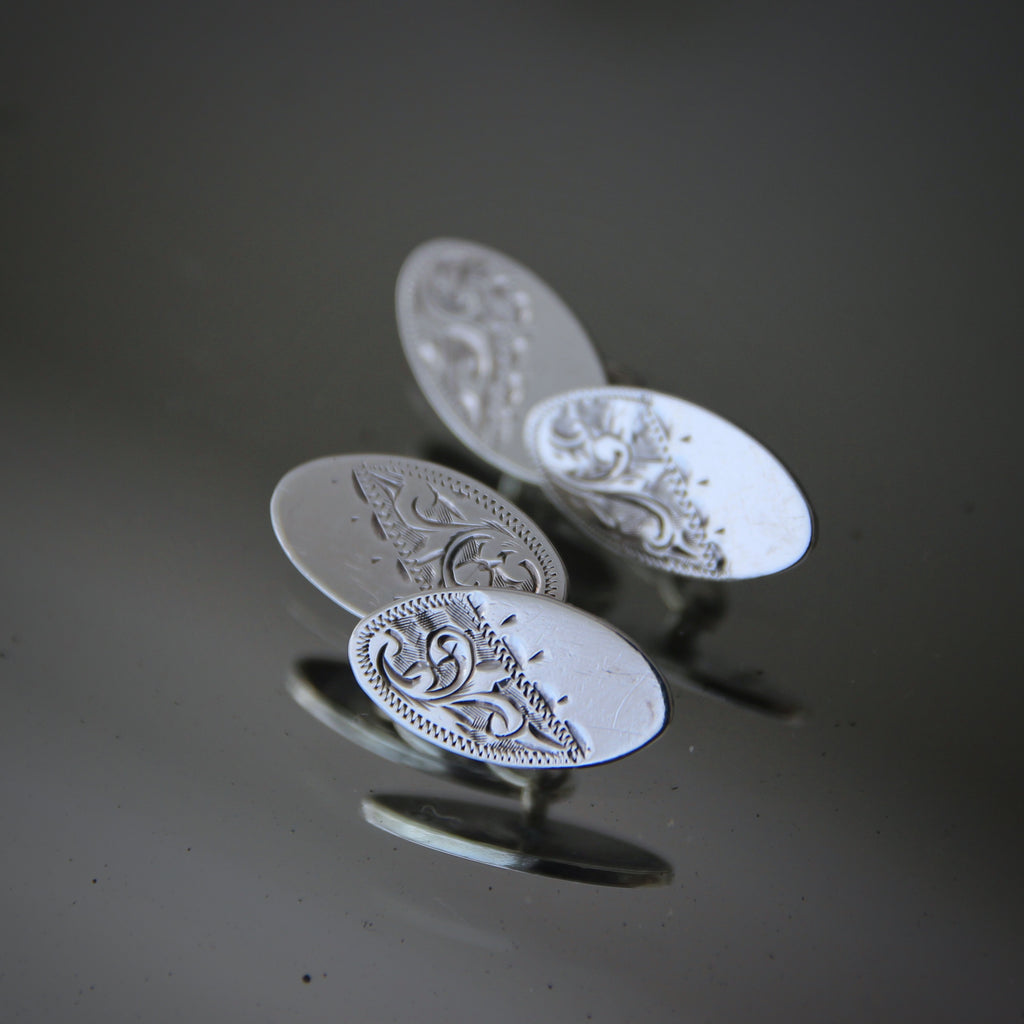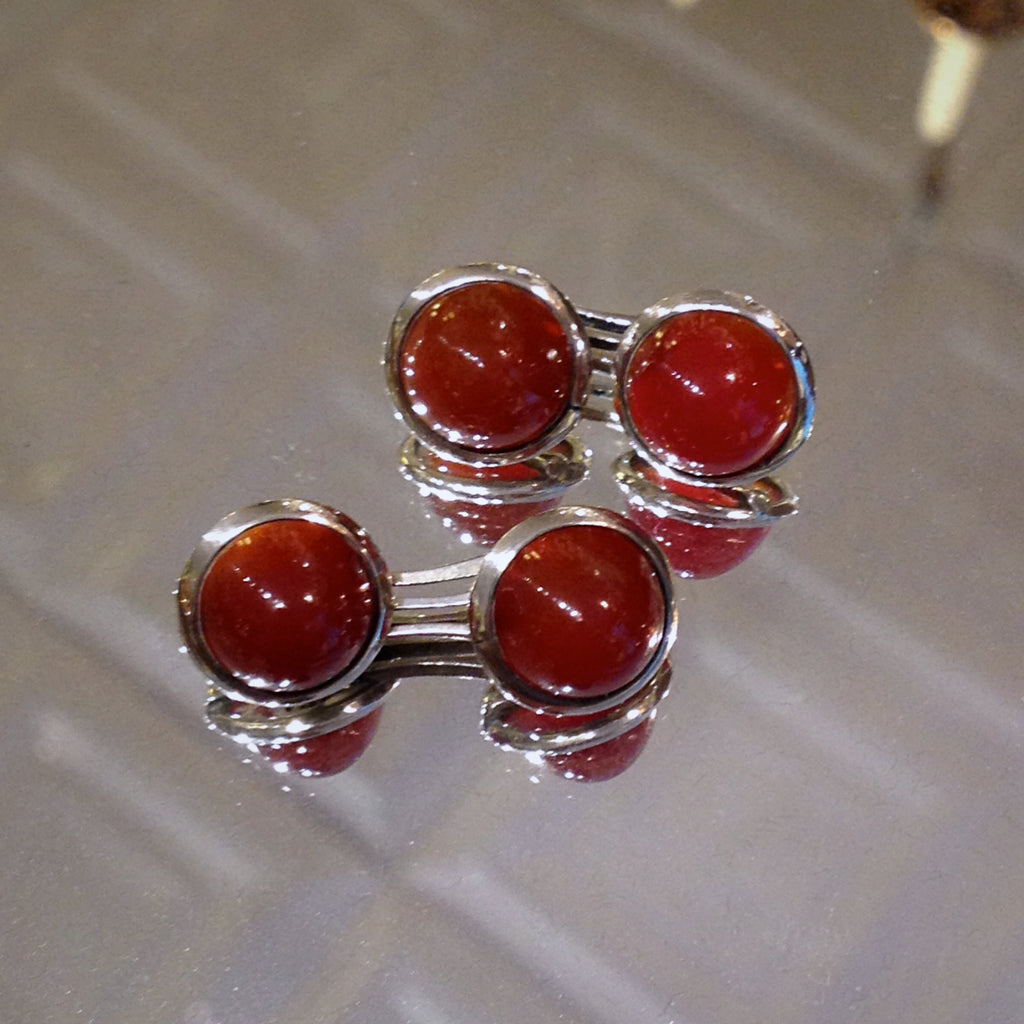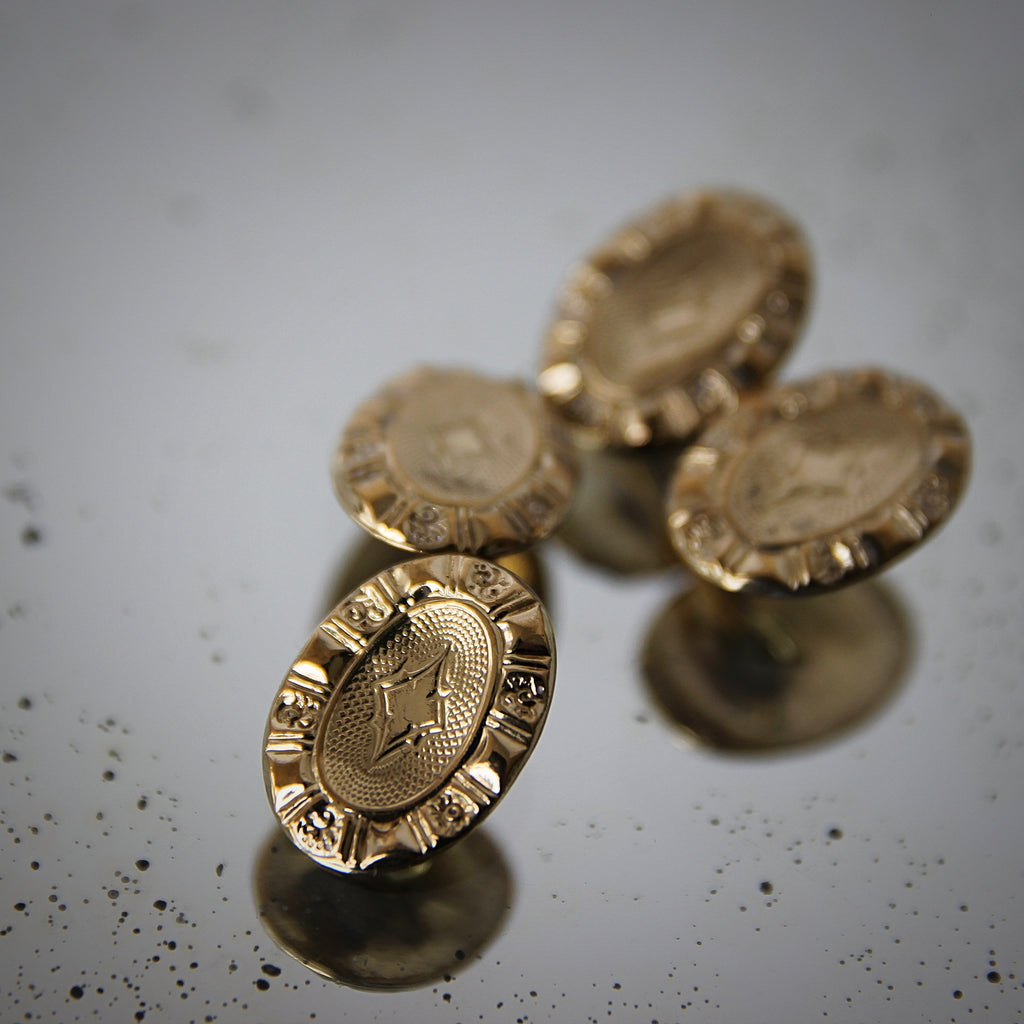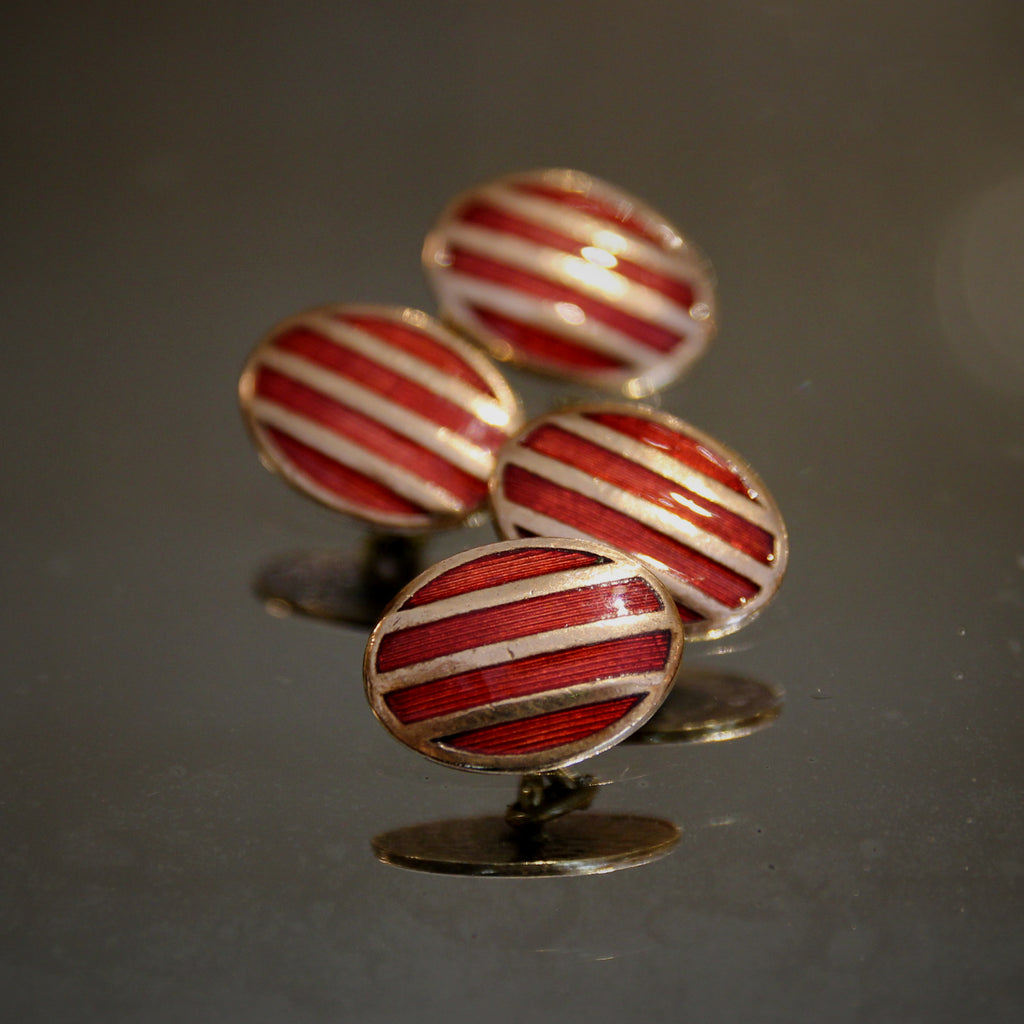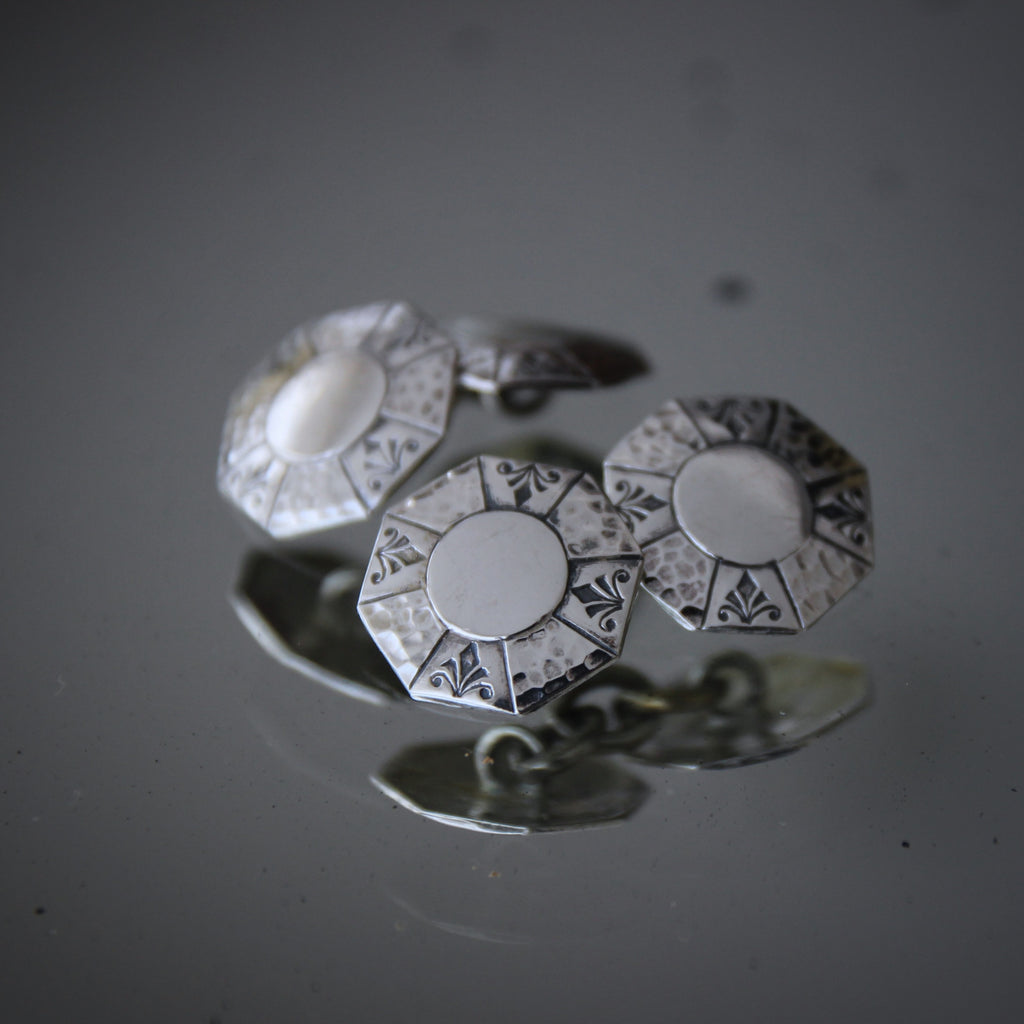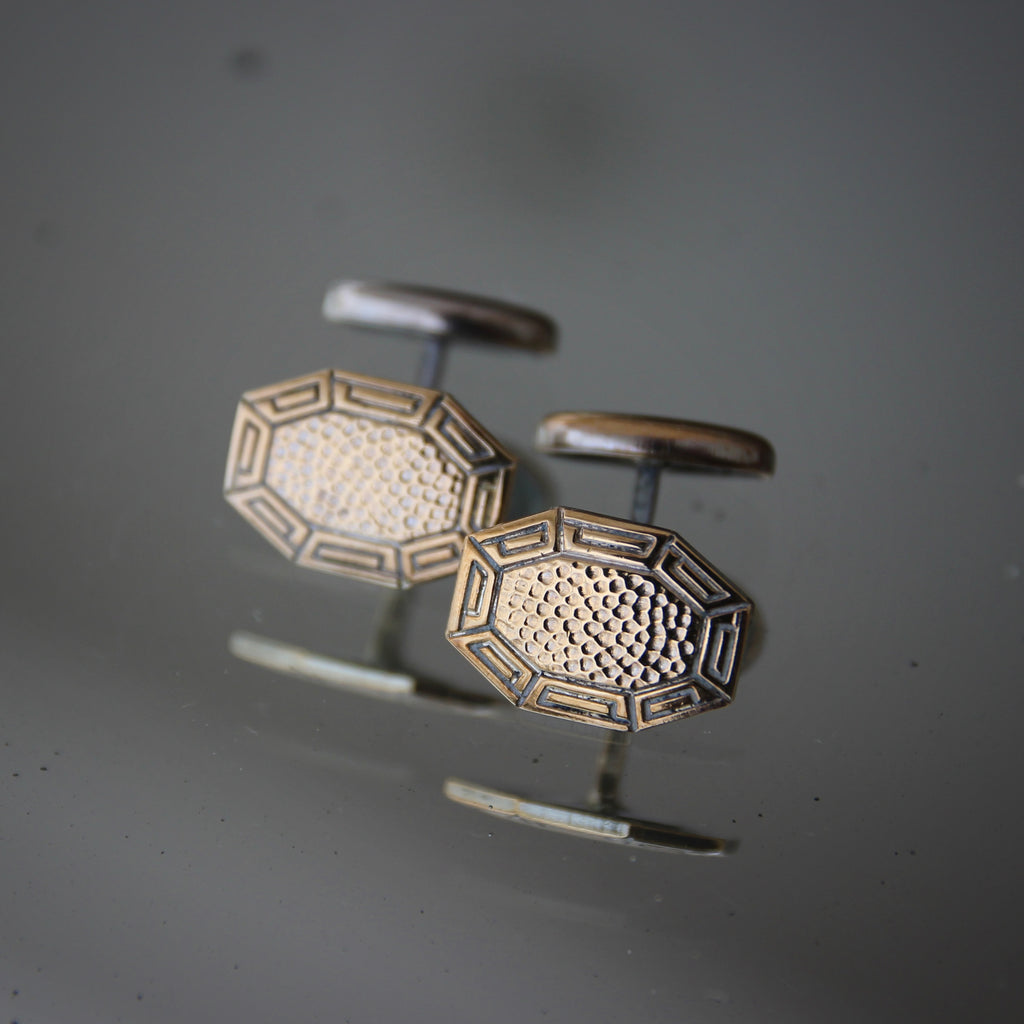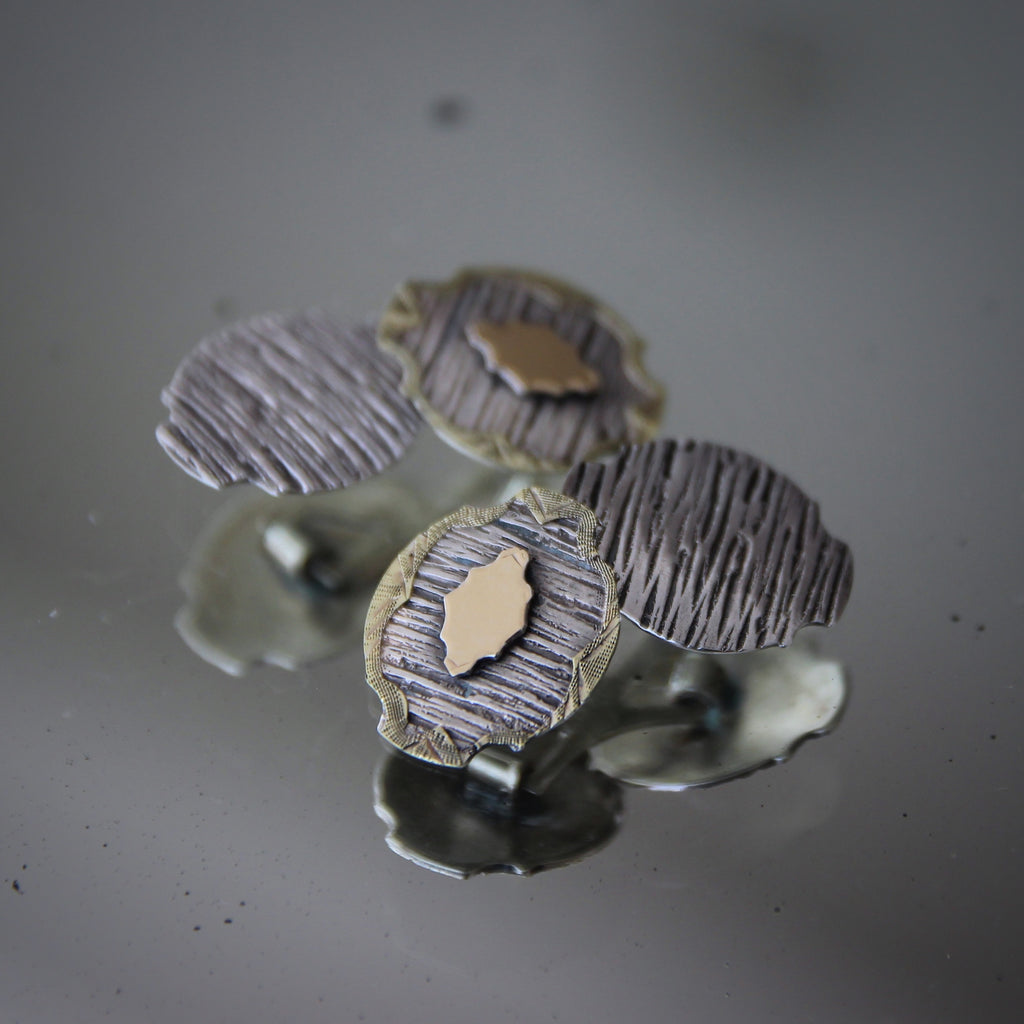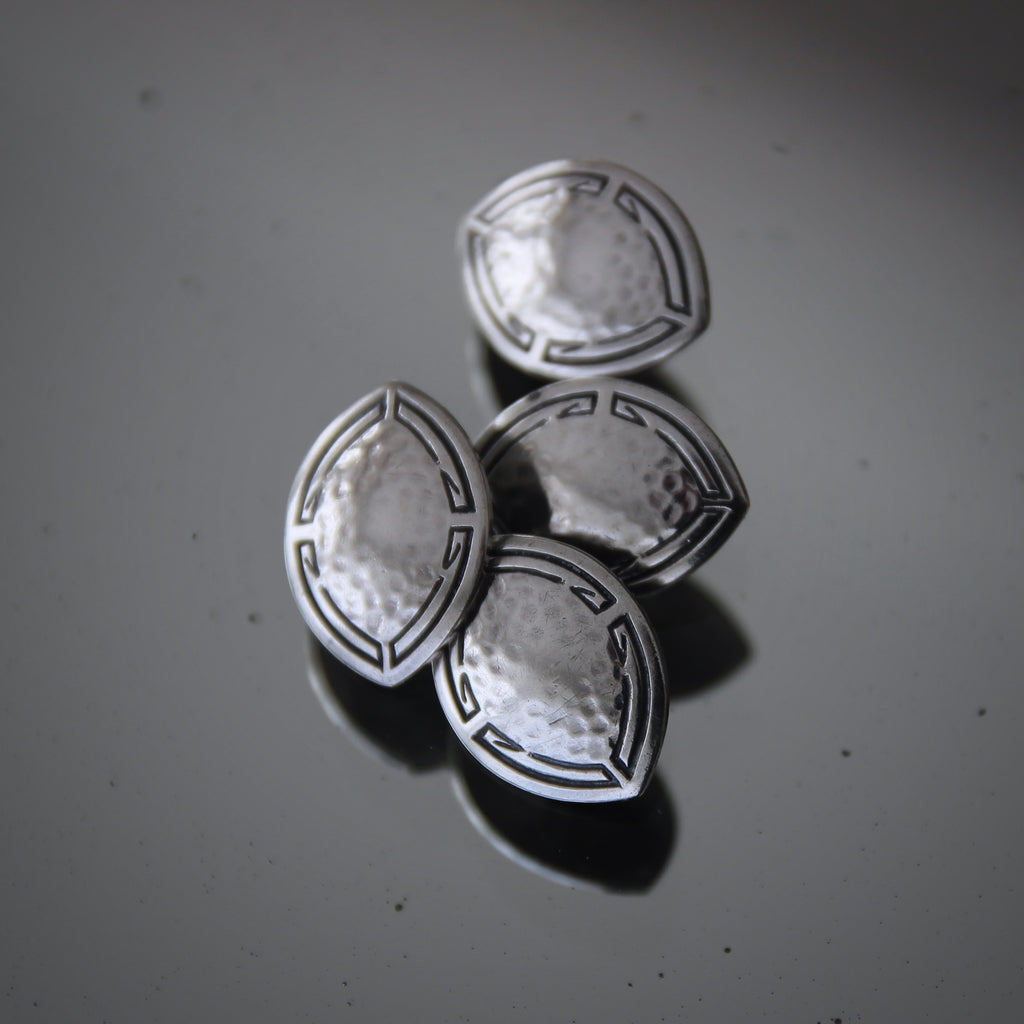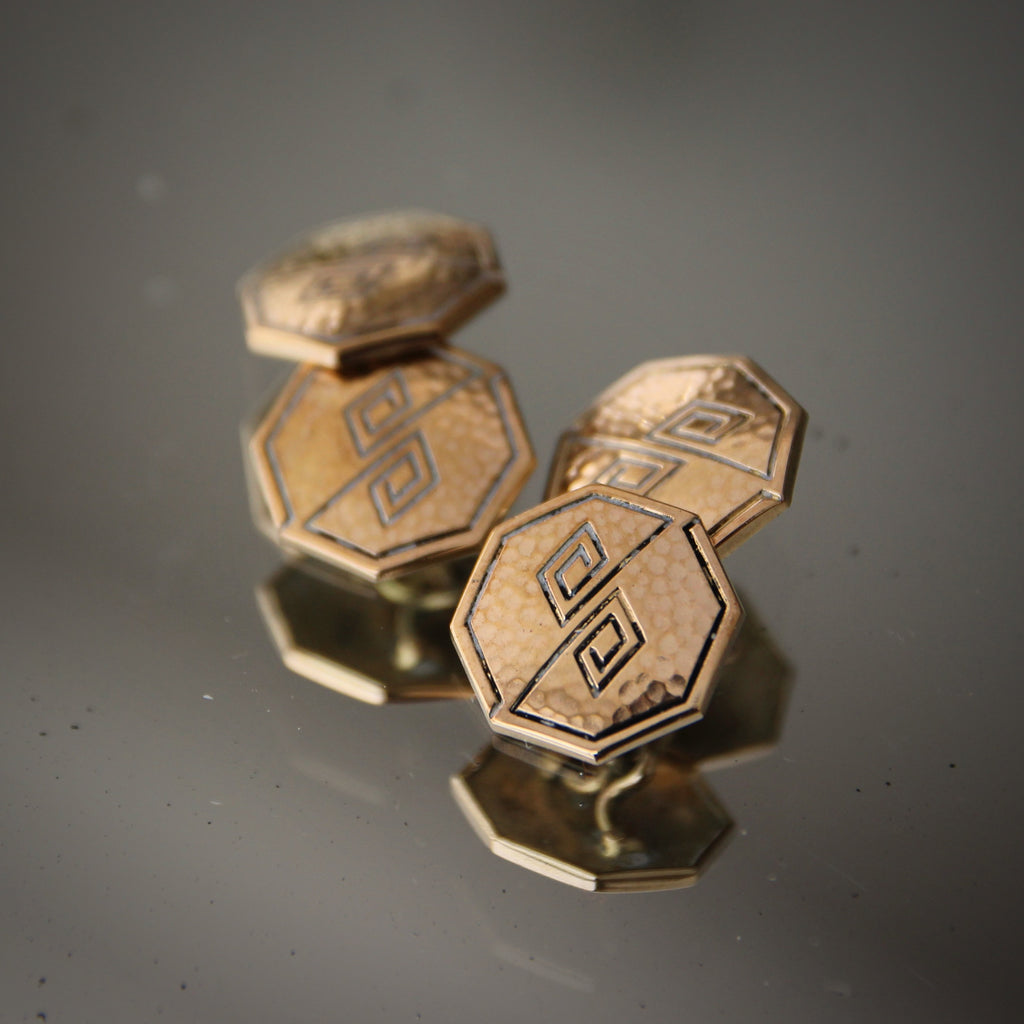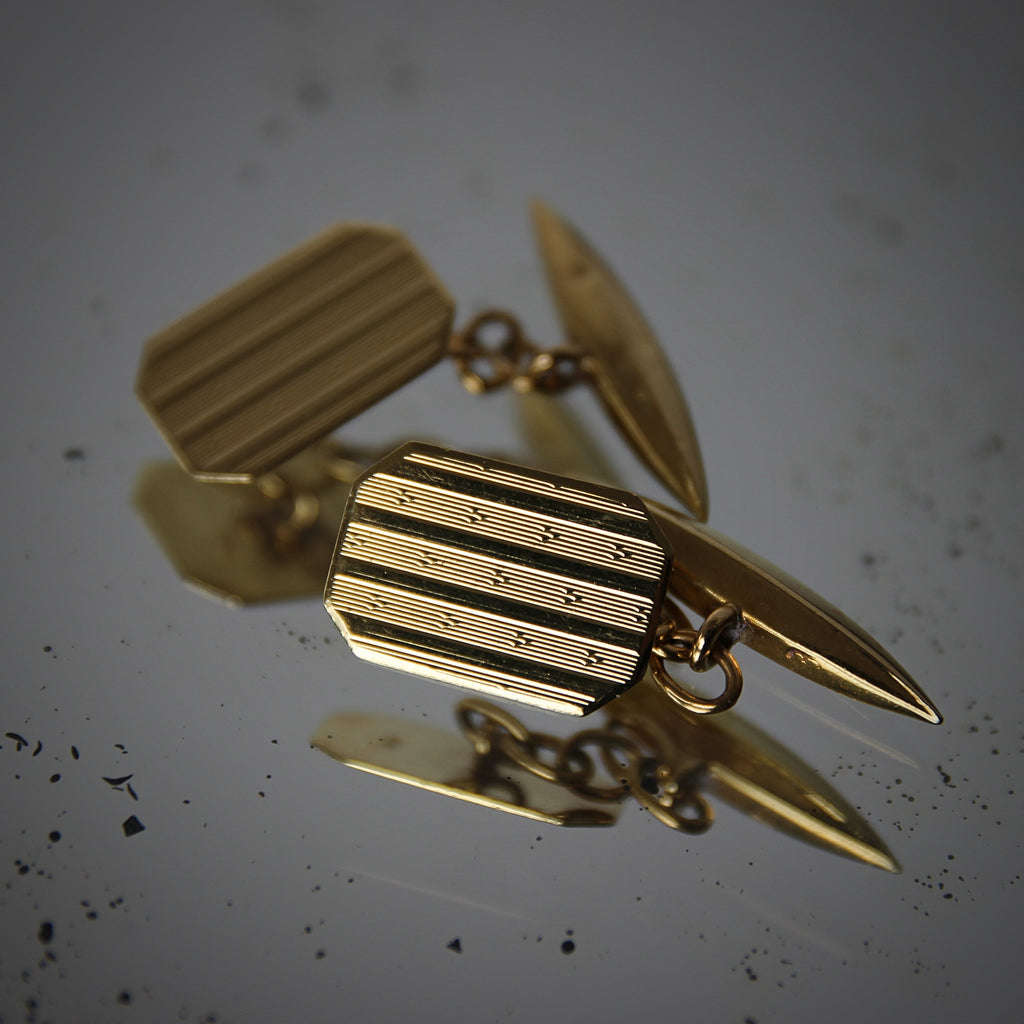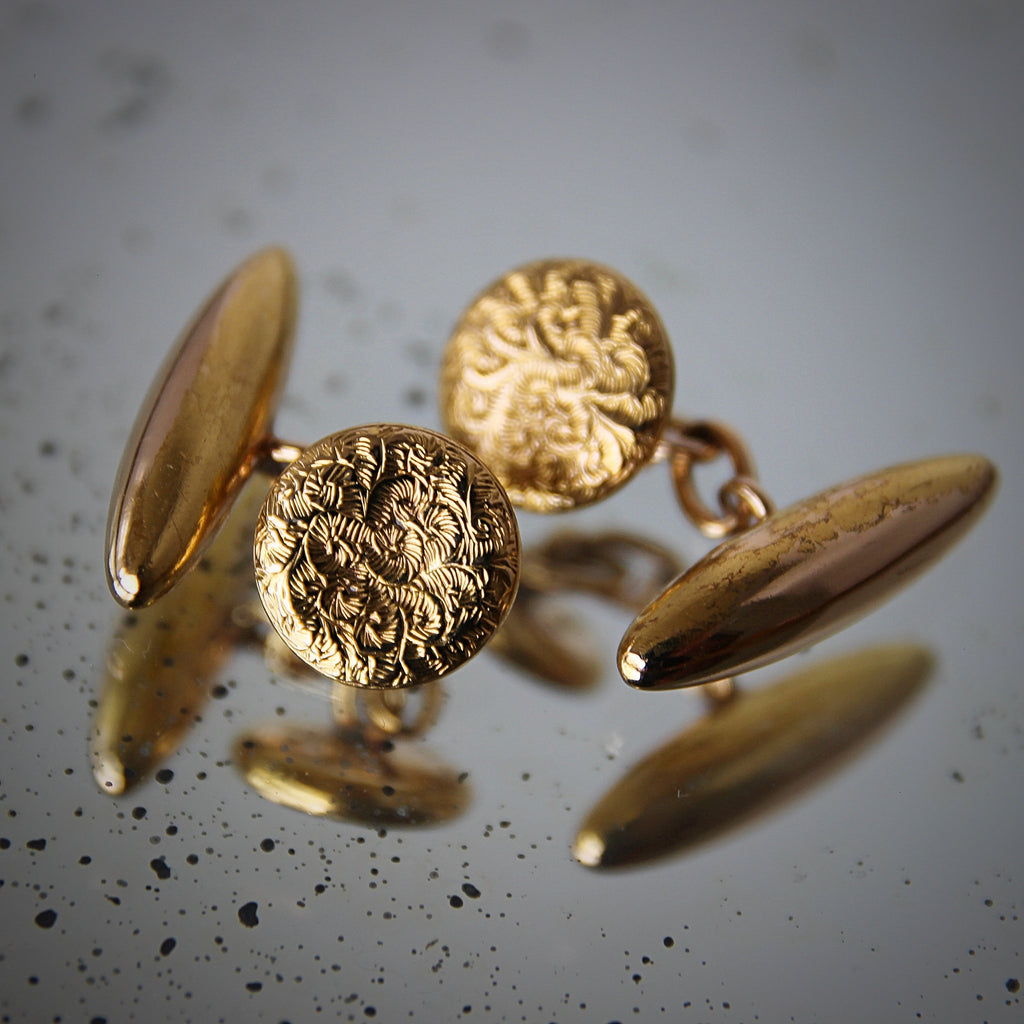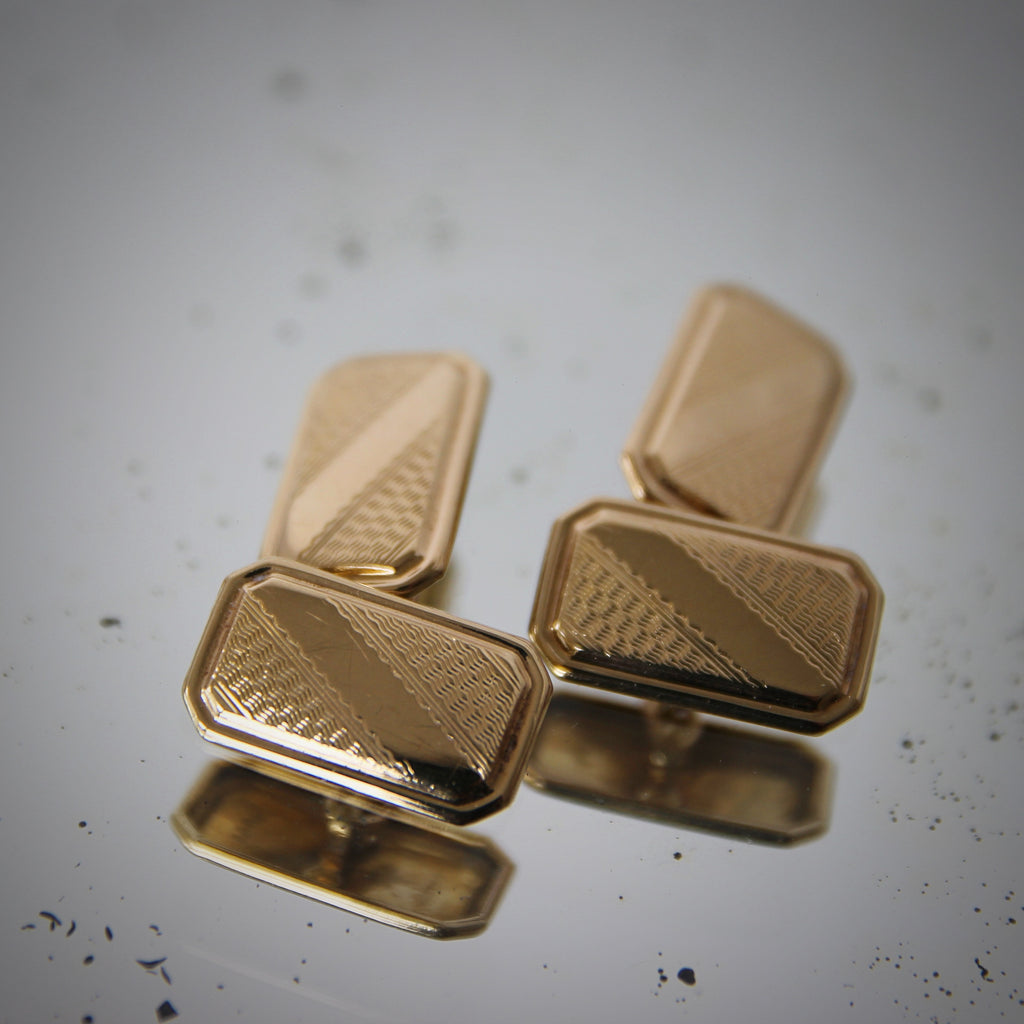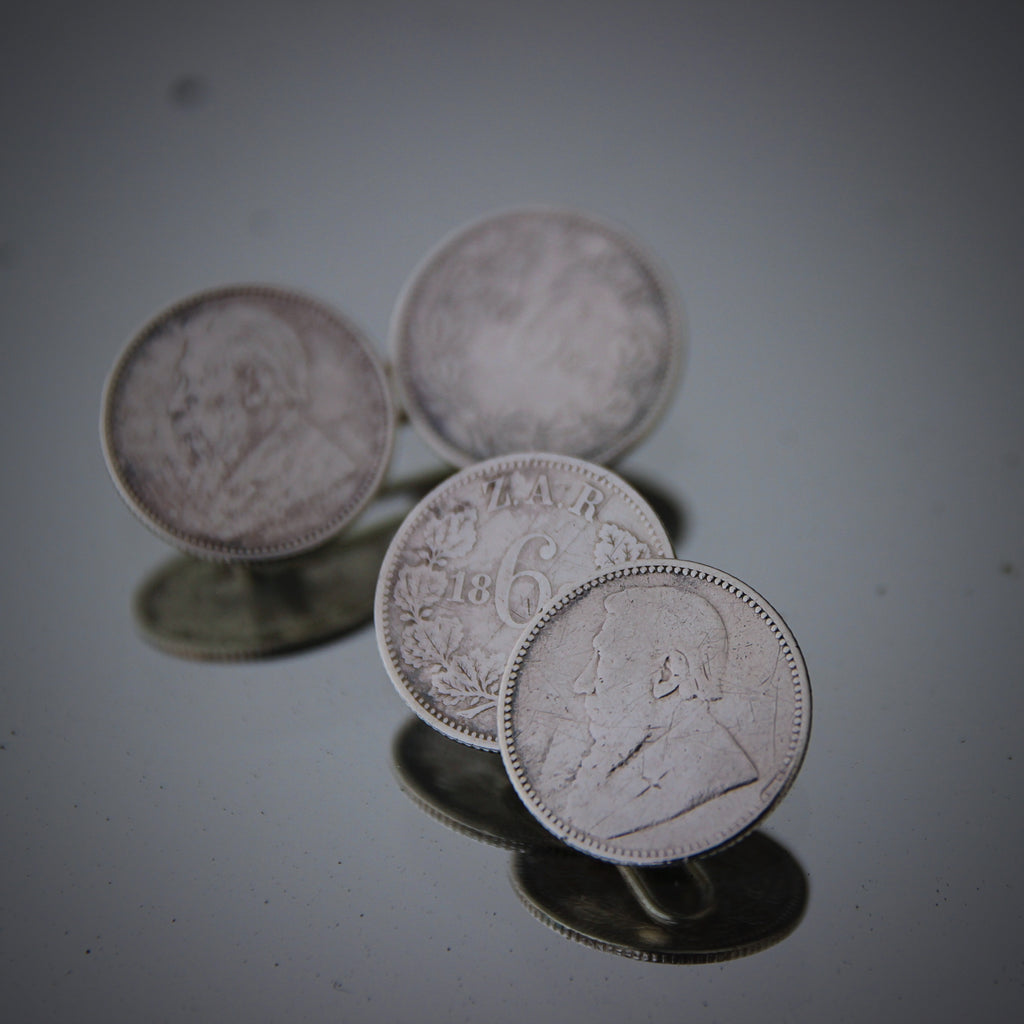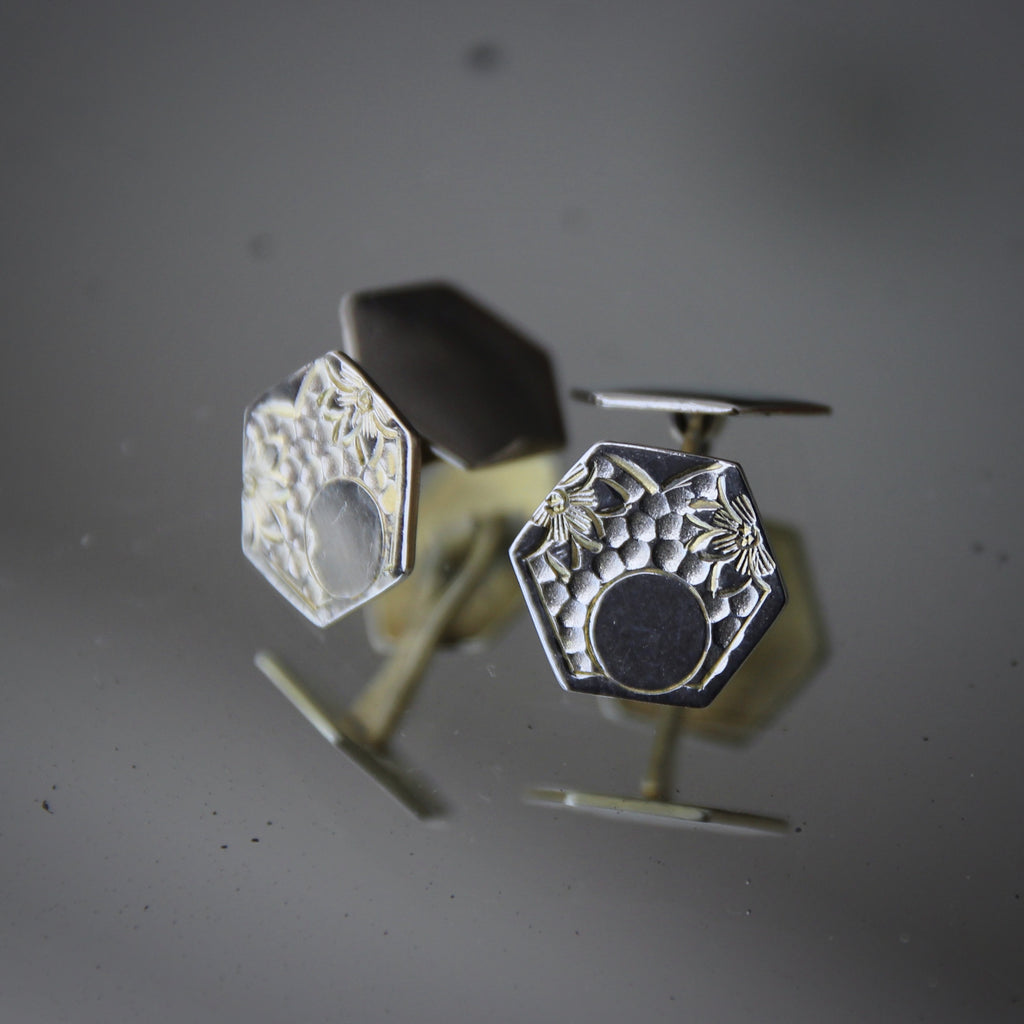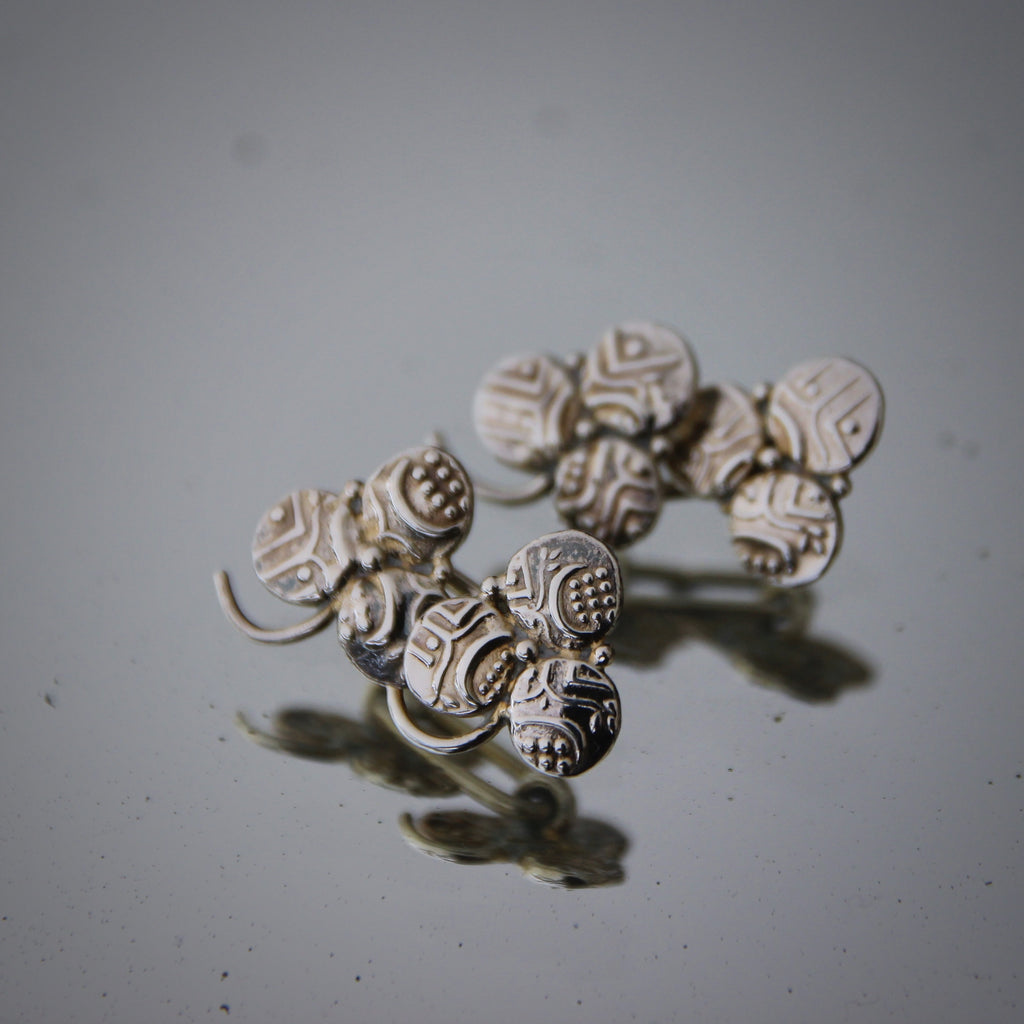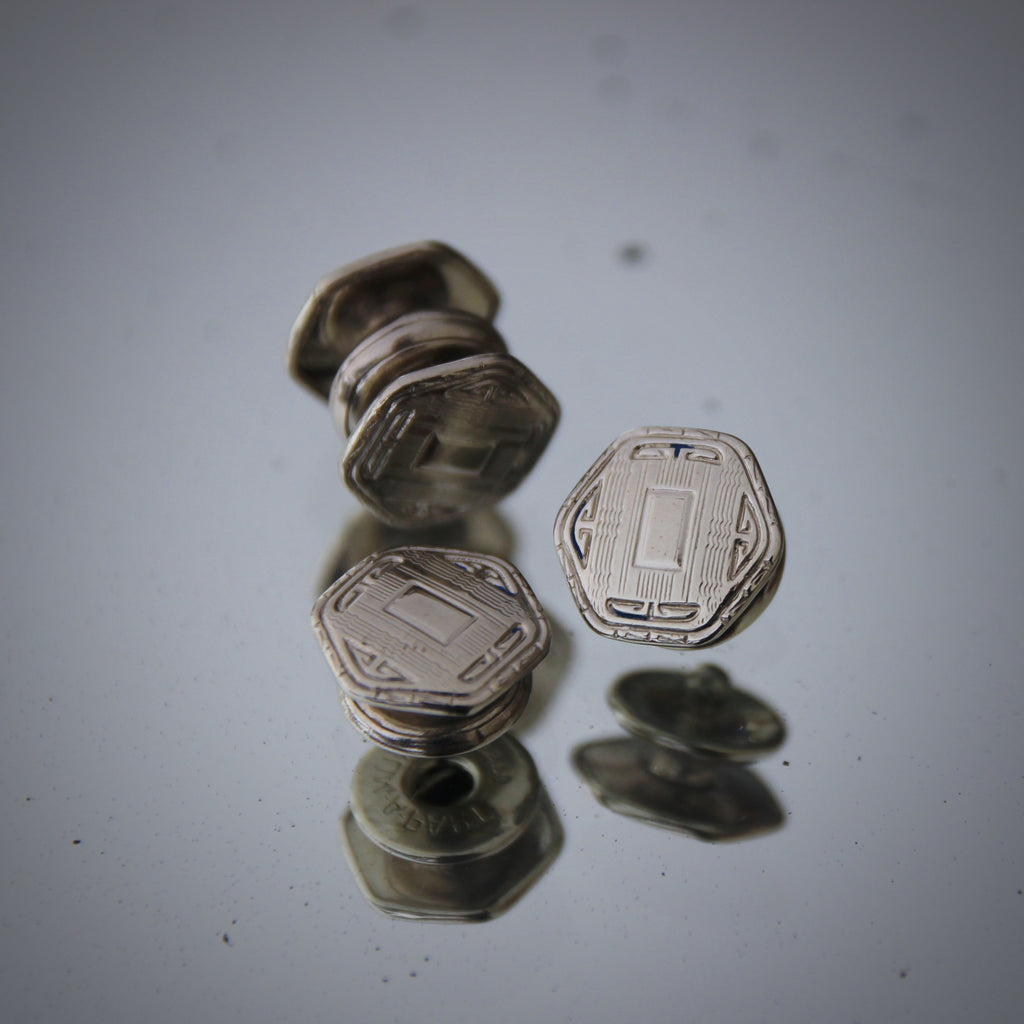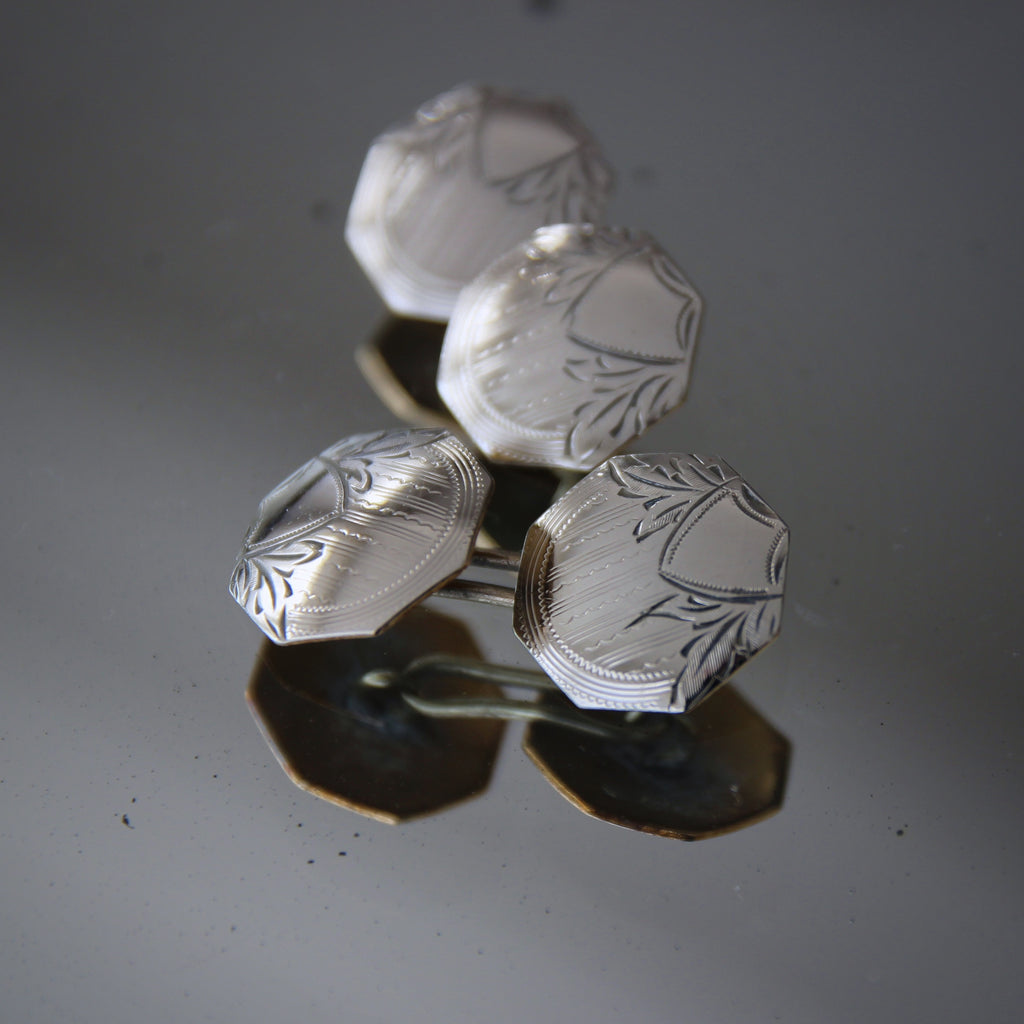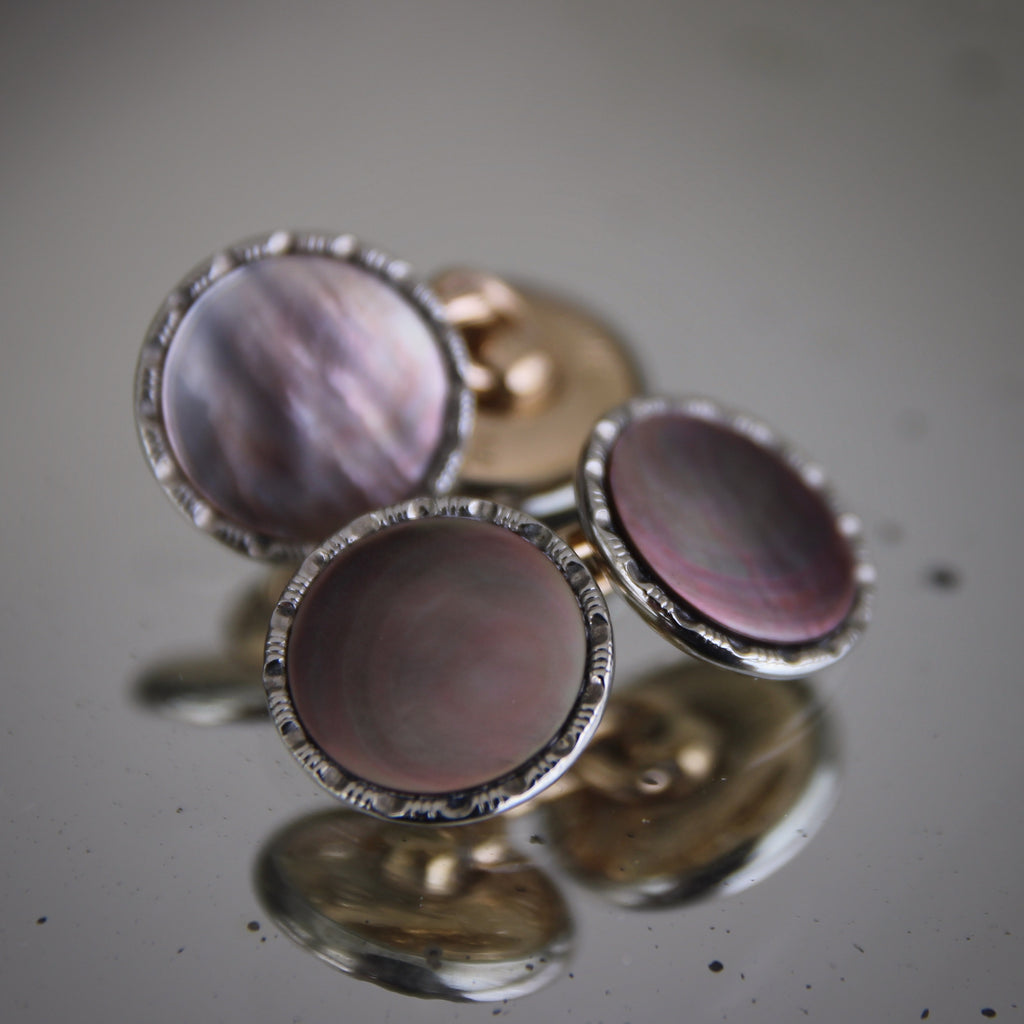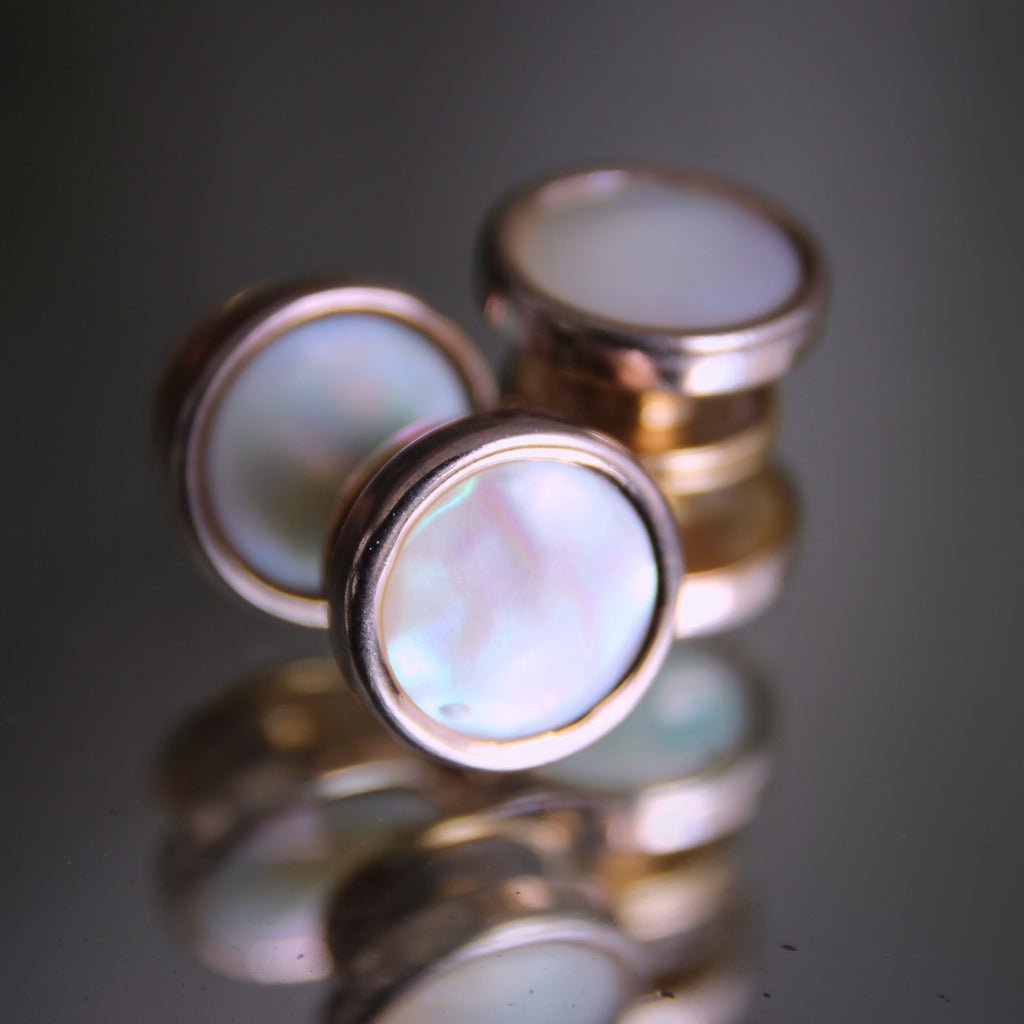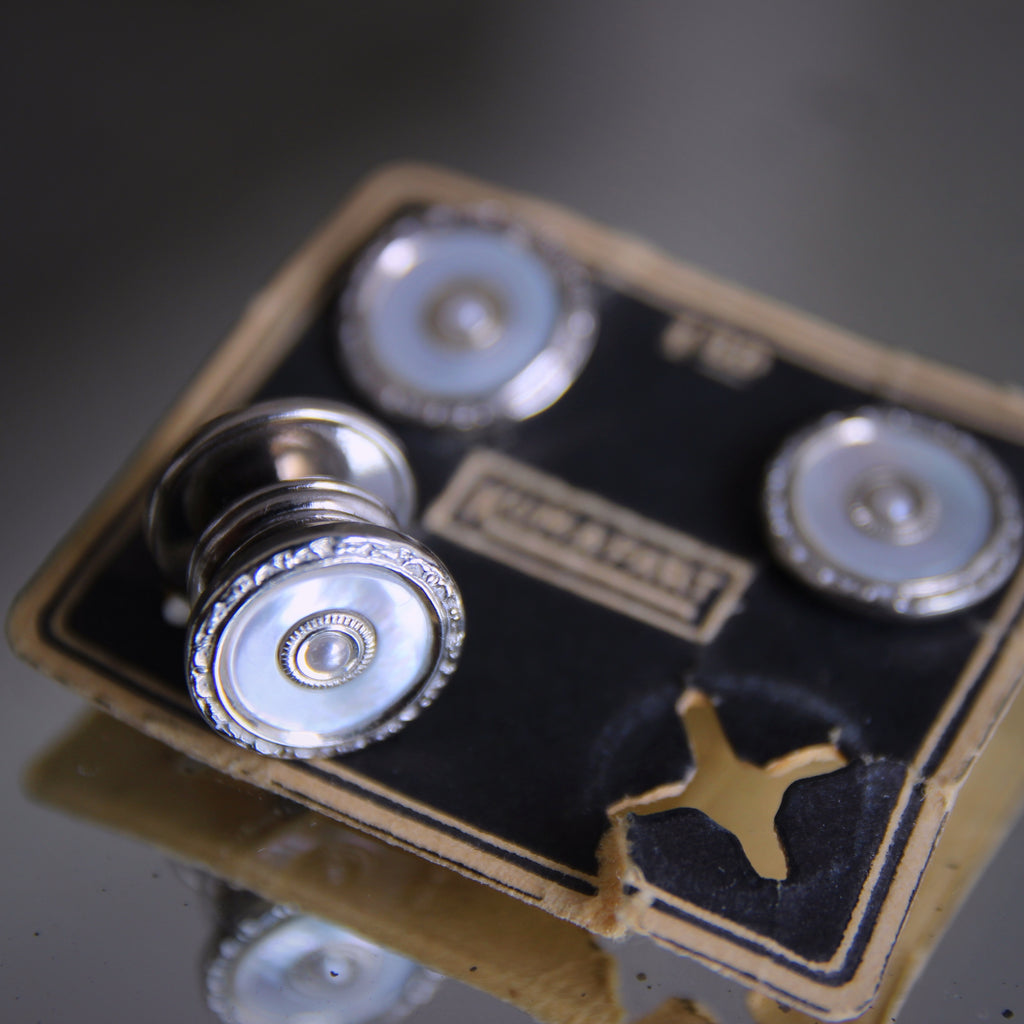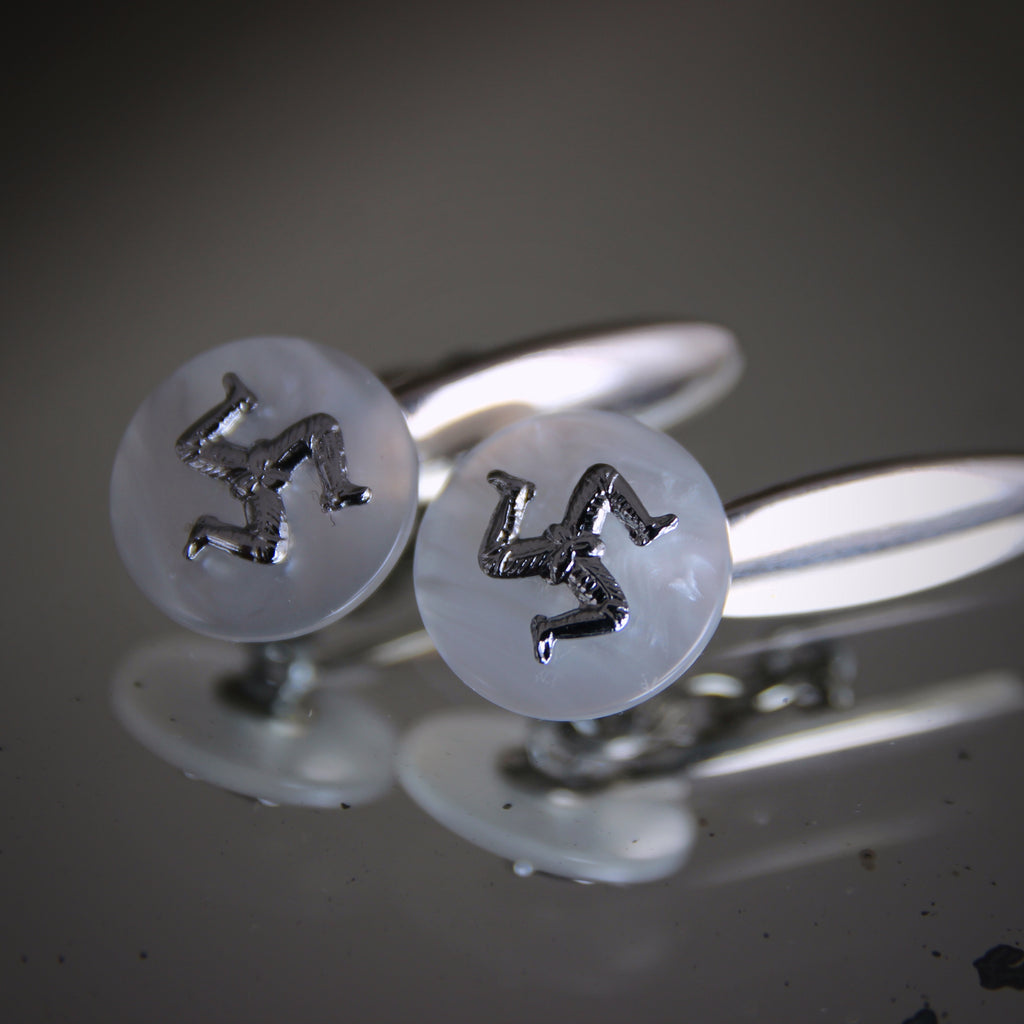JOURNAL — Cufflinks RSS
Today is the Fall Equinox—the day in which daylight and nighttime are of (approximately) equal length. The Autumn season begins today at 2:19 pm and each day's darkness will become increasingly longer until 21 December (the Winter Solstice). The Earth spins on an axis which "wobbles" slowly—back-and-forth—first tipping the Northern Hemisphere closer to the Sun and then tipping the Southern Hemisphere closer to the Sun. This annual tipping creates the seasonal light and temperature differences in each part of the world. Today, the axis is angled (more-or-less) straight up-and-down. The Northern and Southern Hemispheres both have "equal day and night." Starting tomorrow, the daylight will get longer in the Southern Hemisphere while it becomes shorter in the North. On-and-on the...
August's Sardonyx - IV
Here we show something made a few decades later—in the Art Deco Thirties. Stripes of root beer, caramel and white create a delicious pair of English sardonyx cufflinks. They look good enough to eat! And would look great on many a dress shirt (especially light blue).
August's Sardonyx - II
Jolly stripes of red, white and honey sardonyx give these Edwardian Scottish cufflinks the look of candy lozenges. The colored portions are "sard" while the white stripes are made of "onyx." Put them together and you have "sardonyx."
The cufflinks are attached with a silver chain between them. Note that the components are arranged so that you may choose whether the "outward" faces have a little more or a little less of the amber striping (depending upon your mood or the color of your shirt).
Golden Links - IX
Let's wrap-up our parade of gold cufflinks with this handsome English Art Deco pair by Deakin & Francis. Deakin & Francis was founded by Benjamin Woolfield in 1786. It was located at 15-17 Regent Place, in the Jewelry Quarter of Birmingham. Initially, the firm served as a jewelry-maker for other upscale jewelers—making items for the other brands, marked with those other brands' names. Over time, the firm began to expand its own line of branded jewelry and, today, still manufactures and sells its own products. This makes them England's oldest surviving "manufacturing jeweler." They have a flagship store in the Piccadilly Arcade in London. The company still manufactures at its original location, which has been expanded and modernized several times...
Golden Links - VIII
The Art Nouveau movement in Austria was called Secessionism. It included painting, sculpture, architecture, fashion, jewelry, graphic design and the decorative arts. Vienna was not only the capital city of the Secessionist movement, it was the first city of the entire Austro-Hungarian Empire—which gave the city (and the Secessionist art movement) great reach.
The 14 karat gold cufflinks, shown above, were made in Austria around the Turn-of-the-Twentieth-Century. Yellow gold lozenges are hand-engraved with scrolling botanical elements—leaves and blossoms.
Golden Links - VII
This week we are sharing some of our favorite gold and gold-content cufflinks—handsome and tasteful accessories for the well-tailored man. The tightly-woven "basketweave" pattern on these English Art Deco cufflinks is so tiny that the weaving looks more like a texture than sculpture—creating a "no pattern pattern." They are made of 9 karat gold—a value which is pretty low. What these cufflinks don't possess in intrinsic (material) value, they make-up for in strength and durability. 24 karat (that is, pure) gold is very soft; lower karat values ensure that the metal is durable and will hold-up to use (especially on the end of a moving wrist). Click on the photo above to learn more about these handsome cufflinks. More...
Golden Links - VI
North Attleboro, Massachusetts, was an important player in the late Nineteenth and early Twentieth Centuries of the American jewelry manufacturing industry. (Nearby Providence, Rhode Island was another locus of the trade.) Like we see in England, light manufacturing was often concentrated in industrial cities, a bit removed from the populated, urban hubs. The factory space in a Birmingham or North Attleboro was much less costly than in London or New York. In 1873, Robert Fitz Simmons founded the RF Simmons Company—along with his two business partners, Joseph Lyman Sweet and Edgar L. Hixon. Each man contributed $2,500. The company's initial production comprised assorted gold-filled chains: necklaces, bracelets, watch chains and eyeglass chains. Within a decade-and-a-half, Simmons had 200...
Golden Links - V
The 10 karat gold fronts of these English Art Deco cufflinks are etched with a "honeycomb-effect" graphic. Picture them pressed against a crisp, baby blue shirt cuff—laid over a handsome, sun-tanned wrist. Summer's on its way!
Golden Links - IV
Over the years, we haven't stocked too many Arts & Crafts cufflinks in the shop. They seem to be difficult to find. This pair, made of hand-hammered 10 karat gold, are embellished with a crisply-drawn "meandering" graphic. The juxtaposition of rustic planishing, contrasted with tidy etching, creates an interesting confluence of attitudes.
Golden Links - III
This week we are sharing some of our Golden Links, currently found in the LEO Design on-line shop.
From the late English Art Deco period comes this handsome pair of 9 karat gold cufflinks. They are hallmarked Birmingham, 1949. A clean "slash" travels diagonally across the machine-turned basketweave-engraved faces. They are handsome, sophisticated and crisply-elegant.
Golden Links - II
The Aesthetic Movement of the late Nineteenth Century had a big influence on the fine and the decorative arts of the Victorian Age. Shown here, a pair of gold-content cufflinks, hand-engraved with a partitioned, botanical design, surrounded with a silver bezel. It is not uncommon to find Nineteenth Century jewelry which was never marked as to metal content. Thus, we are uncertain of the karat grade of this gold. The "toggle" fastener on the back of the cufflinks was also common in the Nineteenth Century.
Golden Links - I
For the next several days, we'll be sharing some of our handsome gold (or gold-content) cufflinks—most of them embellished with elegant and stylish engraving. Such golden links will always be a stylish and elegant accessory for any well-tailored man. Shown here, a pair of English Art Deco cufflinks hallmarked Birmingham, 1929. They were made by Owen Powell, a jeweler in the Birmingham "Jewelry Quarter" in the Twenties and Thirties. These 9 karat gold links were "machine-turned," that is, etched with the tight, precise and repetitive pattern seen here. Lathes had been used for turning wood or stone since the Ancient Mycenaeans in 1300 BC. In the Eighteenth Century, with the advent of the Industrial Age, the lathe was adapted for...
Spring Green - VII
In the wake of Saint Patrick's Day, we are celebrating some of LEO Design's handsome green offerings, like the pair of Art Deco cufflinks, shown above. While these cufflinks resemble a pair we shared earlier this week, they are different in one small detail. On this pair, the enamel is celadon-colored (not Spring green). Celadon ceramics glazes were invented by the Chinese in the Tenth Century. The name refers to a light green or grayish-green color, often with a lightly crackled surface effect. Celadon—which can range from pale green to a deeper grey-green—is reminiscent of jade, a continuously-popular stone in Asian cultures. And, while these glazes can be applied to many different types of clays (including stoneware and earthenware), it...
Spring Green - V
In these days after Saint Patrick's Day, we're sharing some of our favorite green items—all currently on offer on the LEO Design website.
Shown here, a handsome pair of Art Deco cufflinks. The triangular form is aerodynamically modern and the fan-form graphic, which adorns the faces, gives energy and movement to the design. But, what I like best, is the crisp combination of Kelly green and bright white enameling—fresh, bold and clean. This pair of cufflinks will be perfect for Spring and, certainly, throughout the Summer.
Spring Green - II
I love all shades of green. And it is the lightest shade—like a brand new Spring leaf, just-unfurled—which might be my favorite. It is so delicate and vulnerable, and yet promising. This pale hue marks the earliest signs of Spring resurrection after a long and dreary Winter. Shown above, a handsome pair of Art Deco sterling silver cufflinks, made in the Thirties. The refreshing Spring green enamel rests upon a machine-turned guilloché surface. "Machine turning" is a manner of engraving metal (with a rotating machine, like a lathe) in order to impart a precise, geometric design upon the metal. Jewelry, like these cufflinks, are often machine-turned. So are the printing plates for valuable paper certificates—like currency, stocks or diplomas—which helps prevent...
The Show Must Go On!
Day two. I switched-out yesterday's leather boots for sneakers. And I packed my sweatshirt and sweatpants to change for the 4:00 pm pack-up. Alas, the weather—which had been snowing and slushy all weekend—has turned worse. It's sleeting—horizontally. Loading my station wagon will not be a fun thing.
But I learned a lot and enjoyed the experience. I'll probably come back next year.
Shown above, a pair of English Art Deco sterling silver cufflinks from the Twenties or Thirties. Bold stripes of lime green and white enameling lie-over a textural "waffled" guilloche. They are sporty, fresh, and perfect for the Spring and Summer. (Picture them against a tanned wrist!)
Feeling Blue - VI
Feeling blue? Perhaps a joyful "blue rainbow" will perk-up your day?
These English Art Deco cufflinks, made in London in the Thirties. are decorated with a two-tone blue rainbow. Or, perhaps, it's a smile? The enameling decorates (half of) the faces of these goldtone cufflinks.
Winter White - XII
Let's end our procession of Winter White offerings with this handsome set of six Edwardian English shirt buttons in their original presentation box. Recall that, earlier this week, we discussed the history of buttons—and how they were originally used as much to exhibit status, rank and wealth as they were used to fasten-closed a garment. This set of buttons is certainly luxe (though they retain a good measure of appropriate Edwardian restraint). A seed pearl is set within the center of the polished, mother-of-pearl faces. A "sprocketed" ring of green enameling encircles the bezel—perhaps it's a hint of the Springtime to come. The buttons' settings, as well as their fastening rings, are made of silver. A set of fancy buttons,...
Winter White - IX
Mother-of-Pearl has been a classic button material for centuries—whether those buttons were sewn-on or whether they consisted of a separate, unattached fastener. In the early days, buttons were primarily decorative—utilized to exhibit wealth, rank or status. In fact, the trend of using buttons to express affluence lead some Puritanical governments to impose a tax upon them—to discourage such conspicuous displays of riches. The material of buttons—which replaced ties and clasps—ran the gamut from the common to the exquisite, depending upon the pocketbook of the owner. Wood and bone were the most affordable materials. Pewter, horn and (later) brass were a little more expensive. And precious metals, fine enameling and gemstones were within reach of only the wealthiest. By the...
Winter White - VII
One of Winter's loveliest sights is a field of crisp, white snow, juxtaposed against a vibrant blue sky. These Art Deco cufflinks, from the Thirties, feature these two beautiful colorations. Guilloché is the French word to describe the delicate, engine-turned engraving found on metal—or the patterns printed on paper from such engraved metal plates. Engine-turning is the process of using a mechanical device. one version is called a rose machine, to deliver an intricate and precise pattern—often repetitive swirls, zig-zags or waves—upon the metal. The rose machine has a rotating lathe upon which the material to be engraved (in this case, a cufflink) is mounted at the end. This lathe rotates and rocks rhythmically (and precisely) while the cutting tool...
Winter White - II
The clean, white faces of these handsome Art Deco sterling cufflinks, are reminiscent of a field of pristine snow—with the gentle and precise "ripple" of guilloché work perceptible just beneath the enameled service. A "bezel" of Danish blue encircles the snowy field. These handsome cufflinks were made in the Twenties. As beautiful as they are now—during the Winter—imagine how striking they will be fastening a crisp shirt cuff, proximate to a summer-tanned wrist.
Farewell, Macbeth
On this day in 1057, King Macbeth of Scotland was killed at the Battle of Lumphanan. Macbeth, himself, had taken the throne in 1040, when his forces killed King Duncan I (who was attempting to invade Macbeth's northern territory). Upon Macbeth's death, his supporters immediately elevated Macbeth's stepson, Lulach. But Lulach was not long for the throne; he was a weak king and would soon be assassinated by his successor, Malcolm III (son of Duncan I, the king who had been killed by Macbeth). Macbeth (Macbethad mac Findláech) ruled during a period of Scottish history known as The Kingdom of Alba (900-1286 AD). This era ended when England's King Edward I, seized power. Macbeth was called "The Red King," due to...
Welcome, August!
Welcome, August, and your birth stone, the brilliant Peridot. Let's begin with the basics: how does one pronounce "Peridot"? In the dictionary, the first (that is, the preferred) pronunciation is "Peri-dot" with a "hard T." The second option is "peri-dough"—which I suspect is the more popular pronunciation amongst fancy jewelers (and others who are trying to sell the gemstone). Peridot is a clear, gemstone-quality variety of Olivine—which is one of the very few gemstones which is formed in the Earth's hot, crushing mantle (most gemstones form at a much shallower depth, in the Earth's Crust). The peridot radiates a brilliant green color—thanks to the presence of iron—and it presents within a fairly tight color range (on either side of lime green). It...
Let's Talk About Wednesday
In the Hebrew Scriptures, Wednesday is the fourth day of the week. Genesis tells us that God created the Sun, the Moon and the stars on this, the fourth day. The greater orb, The Sun, would rule The Day. The lesser orb, The Moon, would rule The Night. Similarly, most Muslims view Wednesday as the fourth day of the week (which begins on Sunday). In those countries which observe Friday as "the day of rest" (for example, Iran, Somalia or Djibouti), Wednesday is their fifth day. Most modern Christians consider Wednesday the third day. In German, Wednesday is called Mittwoch (that is, "Mid-Week"). Finns say Keskiviikko or "Middle-of-the-Week."
Spring Beauties - III
This week we're sharing some of our favorite Springtime cufflinks—like the smart and handsome pair shown above. Bold stripes of lime green and bright white enameling add fresh Springtime energy to this pair of English Art Deco sterling silver cufflinks. They're sporty, clean, and perfect for Spring and Summer.
Spring Beauties - II
Cornflower blue—with its blush of purple—has always been a favorite color of mine. As it was for Dutch Master Johannes Vermeer. The cornflower is the national flower of Estonia. And the "Cornflower Blue Sapphire" is the most valuable of all sapphires.
This pair of Art Deco enameled cufflinks juxtaposes most-satisfying cornflower with the crisp contrast of bright white. Perfect for Spring—and into the Summer, as well.
Spring Beauties - I
Spring, glorious Spring! New growth. Fleeting flowers. Getting dirty with Winter clean-up, early weeding and fresh plantings.
One of the most beautiful parts of Spring—aside from the longer and warmer days—is the soft Springtime colors. So, this week, we will be sharing some of our nicest "Spring Beauties": cufflinks which capture the soft beauty of the season.
Shown above, a pair of sterling silver Art Deco cufflinks with soft celadon green enameling. Swirls of machine-turned guilloché provide subtle, radiant energy.
Hello, Spring!
Spring is here! Today at 11:05 pm is the Vernal Equinox, that day when the Earth's axis is perfectly-aligned with the Sun, such that day and night (on that day) are approximately equal. Equinox means "equal night." Going forward, the days increasingly will be longer than the nights—until the Summer Solstice (20 June), the longest day of the year, after which date the days will begin to shorten.
Speaking of Spring, these bright and cheerful cufflinks are certain to bring a touch of hopefulness to your shirt cuff. They are made of sterling silver and topped with white and lime green enameling
The Wearin' of the Green
Happy Saint Paddy's Day!
As famous—and popular—as Saint Patrick is, his life is heavily shrouded in mystery. He is believed to have lived in the Fifth Century (possibly, some sources say, the Fourth Century) and was born in Roman-occupied Ravenglass (along the Western coast of Central England). According to his autobiographical Confessio, he was enslaved at the age of sixteen and taken to Ireland where he worked six years as an animal herder. After escaping, he undertook a difficult and dangerous journey, finally reuniting with his family in Britain. He later became a priest and returned to Ireland.
Three Weeks 'til Spring
Can it really be? Spring is three short weeks away! Spring normally arrives on the 20th or 21st of March. However, this year, because it's a Leap Year, Spring springs one day earlier than normal: 19 March. The first day of Spring is also the Vernal (or Spring) Equinox. Equinox means "equal night." The Equinox is the date when the Earth's axis is aligned such that the Sun hovers right over the Equator. On the Equinox, night and day are (nearly) the same length. And, going forward, the days will be longer than the nights. The cufflinks shown here, made in England in the Twenties, are decorated with sunny enameled stripes: lemon and lime. Though they may be worn any...
Welcome, February!
February is here. And she brings with her the amethyst, birthstone of the month.
Until the Nineteenth Century, amethysts were rare and very expensive. They were considered one of the five "Cardinal Gemstones"—alongside diamonds, rubies, emeralds and sapphires. Initially, deep purple amethysts—the color of royalty—had only been discovered in Russia and Austria. Medieval monarchs loved amethysts. To this day, Anglican and some Roman Catholic bishops wear an amethyst in their episcopal rings.
According to Ancient Greek mythology, Dionysus—the god of wine—was in-pursuit of a beautiful virgin, Amethystos. Her prayers to remain chaste were answered: before he could catch her, she turned into a beautiful white stone. In his grief, Dionysus poured wine over the stone, turning it violet—the first amethyst.
Cipher Monday
Despite my chosen profession as a merchant, I think that there are far too many "selling holidays" on the American calendar. So, today, instead of celebrating "Cyber Monday," let's celebrate "Cipher Monday." A "cipher" has (at least) four varying definitions. First, it can be a monogram—an artful construction of interwoven letters—such as one used by royalty or aristocrats. Second, it can be a secret code used to translate a message so that it remains unreadable (except to those who can "decipher" it). Third, a cipher can be the diamond-shaped impression used on British antique ceramics or metal goods to indicate the piece's patent information. And, fourth, a "cipher" is a person of no importance or consequence. The Victorian sterling silver...
Basic Black
This handsome "dress set"—cufflinks, shirt studs, buttons—was crafted in the Art Deco Thirties, with an eye on the Modernism to come. They were made by the jewelry-maker Larter (Newark, NJ), founded at the conclusion of the Civil War in 1865. Soft squares of black mother-of-pearl are set into rolled-gold mountings for a nice, finished look. One of the nice things about black mother-of-pearl is its versatility—its ability to complement nearly any color shirting or suiting fabric. The soft, natural iridescence of the shell material reveals a subtle rainbow of colors: blues, grey, reds, pinks, purples, greens, golds. This flexibility makes it a useful accessory, especially for the man who doesn't (yet) have a broad collection of cufflink color options. These cufflinks go...
Crisp and Clean
Show-off the last of your Summer tan against the clean, white enameling of these Art Deco sterling silver cufflinks from the Twenties. Machine-turned guilloché work rests below the bright white enameling. A bold ring of Danish blue enameling encircles the white. Clean and classic, these handsome cufflinks will work regardless of the season.
April Showers - Part Eleven
A stylized, engraved flower radiates from the faces of these gold-plated cufflinks, made around the Turn-of-the-Twentieth-Century. To get such precise and clean engraving, jewelers used a "lathe" to create what was called "machine turning." The piece of jewelry, in this case a cufflink, was mounted to a precise (and deliberate) rotating arm. There was also a sharp, cutting tool (to provide the engraving) which usually could only move back and forth in a line. The combination of rotation (of the cufflink) and the skillful manipulation of the cutting tool (for engraving) created the etched pattern, called guilloché.
April Showers - Part Six
While decorative buttons and clasps have been used for centuries, the modern sewn-on button (with a buttonhole, as we know it today) is a fairly new development. It became common with the advent of ready-to-wear fashion, at the Turn-of-the-Twentieth-Century. Before that, most men's shirts would be pulled-over the head and, if fastened, would be closed with string, ribbon or fabric ties. In the Nineteenth Century, cufflinks and shirt studs replaced ties to close or fasten men's dress shirts. In the Twentieth Century, spurred-on by World War I, sewn-on buttons (convenient and quick) became more popular—and, eventually, ubiquitous. In the Edwardian Era, when the cufflinks shown above were made, most men's shirts still required links to fasten-closed the cuffs. At that time, every...
The Wearin' of the Green
It's a great day for the Irish! Make the day even better with this pair of handsome—and festive—Art Deco enameled cufflinks. Kelly green and white enamel lies over etched guilloché work, providing a crisp and tasteful pop of graphic boldness. And the "soft" triangular form of the cufflinks' faces give them an extraordinary, modern look.
Golden Spring - V
Let's end our parade of "golden spring" cufflinks with this pair of Turn-of-the-Century Austrian Secessionist 14 karat gold beauties. Crisply-engraved "lozenges" are finished with background stippling and tooled edging.
Golden Spring - IV
These Edwardian English cufflinks reach-back to a more Victorian look. A curling serpentine separates two halves of the engraved oval cufflinks: flowers on one side, scrolling botanicals on the other side.
Golden Spring - III
"Soft triangles" are always a fresh (and uncommon) look in cufflinks. Made around 1910, one side has a shield-form botanical design and the other side remains blank—suitable for monograming.
Golden Spring - II
These Edwardian English cufflinks—etched gold-on-silver—have a decidedly Modernist look. With half of the faces engraved with stylized botanicals, a bold graphic effect is achieved.
Golden Spring - I
Though Winter will be with us for another 18 days, blessed hours of occasional warmth have been delighting us from time to time. These "golden days" of early spring—and the first blooming daffodils—signal the most wonderfully promising of days. For the next few days, we'll be sharing a collection of cufflinks which celebrate the early spring: golden links, decorated with floral and botanical engraving. Shown here, a pair of Edwardian English cufflinks, circa 1910. Two differently-shaped faces, one an oval and one a clipped rectangle, provide two ways of wearing the links. And one may find that the oval face is much easier to slip through a quartet of French cuff buttonholes. Tightly-packed clusters of engraved flowers provide a graphic bed which dissolves into...
February is Here
February is here—and she brings with her the Amethyst, February's birthstone.
Until the Nineteenth Century, amethysts were rare and very expensive. They were considered one of the five "Cardinal Gemstones"—alongside diamonds, rubies, emeralds and sapphires. Initially, deep purple amethysts—the color of royalty—had only been discovered in Russia and Austria. Medieval monarchs loved amethysts. To this day, Anglican and some Roman Catholic bishops wear an amethyst in their episcopal rings.
According to Ancient Greek mythology, Dionysus—the god of wine—was in-pursuit of a beautiful virgin, Amethystos. Her prayers to remain chaste were answered: before he could catch her, she turned into a beautiful white stone. In his grief, Dionysus poured wine over the stone, turning it violet—the first amethyst.
A Different Edwardian Era
For all the Sturm und Drang of Henry VIII's reign (six wives, two of whom he beheaded), at least he could die in the knowledge that a son survived him—at least for a while (six and a half years). His nine year old son (born of Jane Seymour, who died twelve days after giving birth to the boy) became King Edward VI (reigning 1547-1553). Being so young, Edward's entire reign was "guided" by a Regency Council. Nevertheless, the Boy King had strong opinions, principally that England should drive a stake through the heart of the Catholic Church. He abolished clerical celibacy, banned Latin services, and even tried to leave his crown to his reliably-Protestant cousin (once removed) Lady Jane Grey (rather than either of his...
Transition
A "school" of design—like the Aesthetic, the Arts & Crafts, or the Art Deco Movements—do not begin and end on one specific day. In fact, sometimes these movements are not even named until well after the period is underway (or finished). The term "Art Deco" was not used in print until 1966, when the first museum retrospective of the Art Deco Movement was held in Paris. Prior to the late Sixties, the Art Deco aesthetic was commonly referred to as "Moderne."
Schools of design begin organically—sometimes slowly—always while an earlier period is currently en vogue. And there is no Central Organizing Committee which mandates what is going to be in-fashion (and on what date that will begin).
But is it Modern?
When did the Modern Age begin? I suppose it depends upon whom you ask—and the specific context of the modernity under analysis. Literature? Medicine? The Decorative Arts? Even within a narrowly-focused subject, you're likely to hear conflicting answers to this provocative question—and I will not attempt to answer that question here. But I will point-out an observation of early Modernism—and not exactly where you might expect it. The Victorian gold-filled cufflinks, shown above, were made in the Late Nineteenth Century, probably in America. This is a period usually considered pre-Modernist. A highly-sculpted golden "bead" with swirling ribs and tapered ends, sits at each end of a gently curved center bar. The back bead is, naturally, a bit smaller so that it will...
August's Here
Welcome, August, and your handsome birthstone, Sardonyx. Sardonyx is a striped variety of Chalcedony: bands of "Sard" (usually red, brown or yellow instead of black) alongside bands of white Onyx. From ancient times, sardonyx has been treated to enhance or change the color of the stone. Sardonyx has been highly-valued from ancient times. Cabochons, beads and amulets have been found dating back to the Bronze Age (3500 BC), notably at the Minoan Palace of Knossos, Crete. The Ancient Egyptians, three millennia before Christ, used the material for bowls and other small service items. And the Hebrew Bible mentions sardonyx (at a time when the stone was more precious than gold, silver or sapphires). Later, Roman warriors carried into battle precious...
Countdown to Father's Day - VII
For the Dad who savors his pint: a pair of enameled cufflinks for Guinness ("It's Good For You"). Though promoting the famously Irish brand, these cufflinks were made in England. Nevertheless, they still have that terrific, Thirties advertising look.
Countdown to Father's Day - III
For the stylish Dad: a pair of English Art Deco cufflinks with a decidedly nautical attitude. Red and white striped enameling complete a seaworthy flag of bold, graphic color.
In Black & White - IX
This week we've been exploring Handsome Gifts options in black and white. The English Art Deco cufflinks, shown above, were made in the 1930's. Indeed, they are enameled in black and white. But they also express other notable aspects of the British Art Deco movement including bold graphics, angular movement, and soft corners (which create a "sense of tension" as they wrestle to reform the angular original shape). The design and energy of this pair of cufflinks remind me of public transit signage from 1930s England: soft square shapes, high contrast coloration, bold graphics, simplicity of design and the use of hard-wearing enameling on metal. English Deco, to my eye, seems to feature the "softer side" of the movement—an opinion...
In Black & White - VI
The Jazz Age, that musical earthquake of the 1920's and 1930's, had a wide-ranging influence on the culture, image and attitude of the American nation. Indeed, Jazz affected the entire world. Jazz grew out of Black music, initially in the South. This origin triggered varied reactions to the musical style, from titillation, to fetishism, to wariness, to condemnation. Once White musicians began to pick-up or adapt (or copy) the genre, the music gained wider acceptance amongst White Americans. Jazz became very popular. Of course, this "jump" into the mainstream also changed the music dramatically.
In Black & White - IV
Stunning graphics are a legacy of the Art Deco movement—in America and worldwide. This pair of English Art Deco cufflinks boast handsome and energetic graphics on their enameled faces. Enameling involves artfully "laying" glass powder upon a surface (usually metal) and "baking" it to the point of melting the glass powder. The liquified glass spreads and fills the intended area—and eventually cools and solidifies back into a sheet of glass.
In Black & White - II
The Scottish Argyle pattern is a variety of "light plaid"—a series of solid colored squares or diamonds overlaid with diagonal lines. Sometimes the combination of elements creates an optical three-dimensional effect. The pattern has been worn in the Highlands of Scotland since the 1600's and is traditionally associated with Clan Campbell from Argyll, Western Scotland. Argyles became very fashionable after World War I. The Edinburgh knitwear company, Pringle of Scotland, popularized the pattern in England and America, using them on their fine hosiery and sweaters. The Duke of Windsor (who later became King Edward VIII) became associated with Argyles, increasing their popularity in the fashion of the Twenties and Thirties. He wore Argyle plaids while golfing, making the pattern...
More Spring Green
In the Art Nouveau and the Arts & Crafts movements, "preciousness" of material was not a key factor. Rather, beauty and craftsmanship reigned supreme. Simple materials, exquisitely fashioned, was the name of the game. Copper, brass and oak were valued like precious substances—once transformed by a hand of a skilled artisan.
The English Art Nouveau cufflinks and matching stickpin, shown above, are fashioned of interestingly-organic art glass cabochons. Though the material is not precious, per se, the appearance and style are sublime. This illustrates perfectly the priorities of Arts & Crafts collectors: beauty and craftsmanship.
Spring Green
There's a beautiful delicacy to the early green of Spring: tender, gentle and hopeful. With winter moving-on, my garden is beginning to re-leaf in this wonderful hue. It is truly a color of promise.
These English Art Nouveau cufflinks, made in the early Twentieth Century, feature "jadeite" (green artglass) "turtleback" cabochons. Their softly-pebbled texture and central "dorsal hump" are also reminiscent of shagreen—the cured skin of sharks and rays, so fashionable in the period. Their soft green color are the perfect accent for Spring or even the Summer. They will look great on the shirt cuff dressing a handsome, sun-tanned wrist.
Perpetually Shielded
Here's another pair of rolled-platinum cufflinks, made in the Teens or Twenties by Krementz of Newark, New Jersey. A "rolled-metal" involves bonding a top layer of a precious metal (with heat and pressure) to another layer of a less-expensive base metal. This allows the jewelry to have the appearance and weight of a more costly piece and it also makes the piece more durable (as base metals are typically stronger than high-content precious metals). Krementz was not the only jeweler to use "plied" metals to make its products. But they did use a thicker layer of the precious metal than did their competitors. And they confidently provided a "perpetual" guarantee—promising to replace any item, forever, which failed in quality or craftsmanship.
Understated Elegance
On this day in 1866, just months after the close of the American Civil War, George Krementz founded his jewelry manufacturing company in Newark, New Jersey. For the first 12 years, he made a "general range" of women's jewelry but strictly for wholesale trade to other jewelry makers, not under the Krementz brand name. In 1884, he received a patent for his new collar stud design (which would become the first men's item he would manufacture). Collar studs were used to attach starched collars to dress shirts, in the days before they were sewn together. Krementz's new design was of one-piece construction (no seams, thus stronger) and could be made quickly on the new machinery he developed. Shortly after receiving his...
Lean Times
England enjoyed powerhouse economic growth in the Nineteenth Century. But, after World War I (1914-1918), England fell into a slump which lasted throughout the 1920's. Things got even worse in the Thirties as the whole world suffered the Great Depression. Then came the War—a terrifying six years of danger, loss, debt and economic deprivation for England. Unlike in the United States, where the economy boomed after the War, the decade following World War II was still very poor for the British economy. England had lost many of its export markets, racked-up tremendous debt, and needed to re-build its destroyed infrastructure. It was not until the Mid-Fifties that England was powered-up and producing at an impressive clip.
To Clean or Not To Clean?
How much to polish antique metal is a matter of personal taste and local custom. As a rule, antiques dealers generally believe it is better to do less—and preserve the value of something—than to over-clean (or over restore) something and destroy its value. English antiques dealers tend to go a bit heavier on the polishing of antique metals than their American counterparts. For me, it depends on which metal is being considered and what the metallic object is. Copper, as long as the finish is nice and even, I will never polish. There is nothing more beautiful than a deep, rich, dark, nut brown copper finish—again, as long as it's even. The same is even more true of bronze....
A Link to Secessionism
Secessionism was the Arts & Crafts Movement variant of Vienna at the Turn-of-the-Twentieth-Century. Like its "sister movements" in other parts of the world, Secessionism marked the "movement away" from the prevailing design and aesthetic conventions which preceded it. It also utilized a distinctive vocabulary of design elements including natural and botanical motifs, the elevation of handcraft and the promotion of natural materials.
The cufflinks shown above are probably not Viennese (or even Austrian). They are most likely American. But they are certainly from the Secessionist period—and utilize a Secessionist-inspired scrolling motif.
Cufflinks Are Not Earrings
We've sold hundreds of pairs of cufflinks over the years. Eighty percent of the time, the purchaser is a man buying cufflinks for himself. The other twenty percent of the time, it's someone else (occasionally a woman) buying a gift for a man. When I'm selling a pair of cufflinks to a woman—which are intended to be a gift for a man—the customer will will nearly always remark, "My husband's very conservative in his dress." She will guide me to show her the more-understated options. My response is always, first, to show her the more conservative options. Then I will explain that cufflinks are not like earrings. Whereas earrings are highly-visible, centrally-placed, and subject to intense scrutiny, a pair of...
Soft Brutalist
Add Sweden to the makers of cufflinks here at LEO Design. These sterling silver cufflinks, made in the late 1940's or 1950's, sit (aesthetically) somewhere between the earlier Art Deco period and the Brutalist Movement to come. Thus they present the crisp elegance of Deco while leaning-forward (but not too far!) into Modernist Brutalism. They present a "softer side" of Modernism—clean, elegant and not too chunky. They are crafted of 925 silver.
Unidentified Flying Logo
I buy a lot of cufflinks while traveling in England and Scotland. Victorian, Edwardian, Art Deco and Modernism—my acquisitions span several periods and movements, from about 1870 to about 1970. The period which most catches my eye, it seems, is the Art Deco period of the 1920's and 1930's, that "Golden Age" of cufflink-making between the wars. But I also like early Modernist designs, too, especially if they seem to have evolved out of the Art Deco movement which preceded it. I search for cufflinks "with my eyes first," meaning, it is the appearance, design and visual aesthetic of the links which first pique my interest. Of course, material, condition, and theme also plays some role. But, if the cufflinks don't...
Nouveau à Nouveau
What's old sometimes becomes new again. Here, a pair of French Art Nouveau silver cufflinks from just before World War One. Within almond-shaped "fields" bloom tiny gardens of flowers—life prevailing despite strict confinement. Alas, the Great War would change everything, including the aesthetics à la mode. Once the War was over, and life returned to normal, the world was ready for something different, something which augured a hopeful & progressive future. Art Deco stood in the wings, ready to take center stage.
The almond-like slivers pass easily through a buttonhole and provide an elegant, delicate closure to the shirt cuff.
RUJT?
Are you J. T.? (Or, perhaps, T. J.?) This handsome pair of Soviet Era sterling silver cufflinks—dated 1 May 1956—are engraved with the letters T & J. A crisp, elegant border frames the monogram beautifully.
Russia is much in the news these days. Sadly, some political leaders and influencers (in Russia and America) are cheering for a reconstituted Soviet Union—and providing justification for the aggression. It's interesting to note that these very cufflinks were crafted during a period of hardship, discord and struggle. And, yet, their beauty managed to outlive the strife. Perhaps there's a lesson for us here: while bad periods pass (albeit after a lot of time and pain), human craft and beauty can survive and continue to inspire long after the conflict ends.
Forward, March!
March—and her birthstone, the Aquamarine—is here! The name Aquamarine was coined in 1677; the clear, aqueous blue gemstone was reminiscent of seawater, or "water" + "from the sea." But the stone had been well-known well before this date. Ancient Romans believed that the gemstone had the power to calm the seas, thus protecting seafarers. In New Age circles, the aquamarine's clear, bright coloration symbolizes youth, purity and happiness. And they are believed to help bring happiness to marriages. Aquamarine is the state gemstone of Colorado. Aquamarines are the aqua blue variation of the gemstone Beryl. Because they are rather plentiful, aquamarines are not very expensive (unlike the much-rarer beryl variant, the emerald). And enormous aquamarines have been mined; the largest...
Victorian Refinement - XIII
The Art Nouveau Movement could be found in many Western countries during the late Victorian and Edwardian eras. It might be called Arts & Crafts (in England), Craftsman Style (in America), Jugendstil (in Germany), Secessionism (in Austria) or Stile Liberty (in Italy). While the different countries may express different aspects or aesthetic characteristics, their motivations remained unified: a move away from industrial production while promoting accomplished handcraft—employing themes of nature, honoring natural materials, and reviving historic cultural elements (literature, mythology, symbolism or indigenous graphics).
These 14 karat gold cufflinks were made in Austria at the Turn-of-the-Century. A scrolling botanical hand-etched design swirls about the faces of the cufflinks.
Victorian Refinement - XII
Jet is the petrified remains of Jurassic period pine trees—buried in oxygen-free bogs and tightly-compressed for millions of years. Actually, jet is a type of coal and it will burn if placed in a fire. When touched with a red-hot needle, jet will emit the smell of burning coal (which it is). While it is considered a gemstone, it is not a mineral (for there are no crystals in it). Instead, it is classified as a mineraloid. The oldest discovered jet objets are small amulets, carved circa 10,000 BC and excavated in Germany between the World Wars. Though jet can be found around the world, "Whitby Jet," from Whitby, England, is perhaps the oldest and most famous deposit (at 181 million years...
Victorian Refinement - XI
A light—but stylish—engraved treatment adds an elegant zing to these handsome Victorian Aesthetic Movement rolled-gold cufflinks, made at the Turn-of-the-Century. Such a restrained and tailored look is well-suited to elegant menswear. I see them on a soft blue shirt—with crisply-starched cuffs—peeking-out from the sleeve of a dark grey, chalk-striped wool. Conservative, perhaps, but classic to the core.
Victorian Refinement - X
This pair of American Victorian cufflinks are a dynamic swirl of floral engraving, etched graphics and an energetic, circling border meant to contain all the motion and energy. They were made around 1900 in Providence, Rhode Island—a powerhouse of American jewelry manufacturing in the late Nineteenth and early Twentieth Centuries. They are signed "Parks Brothers & Rogers" which operated from 1892 until 1930.
Victorian Refinement - IX
The Scots love their stones! Colorful semi-precious (and just plain decorative) gems are used in all manner of traditional jewelry and ornamentation. These Victorian Scottish cufflinks from the 1890's are crafted of beveled slivers of red agate. The traditional design of the silver fasteners reflect the period and style in which the cufflinks were made. The result is a handsome and handcrafted look which honors the stones so dear to the Scottish people.
Victorian Refinement - VIII
Though made in the Victorian 1890's, these cufflinks have a handsome Georgian sensibility: simple, restrained, elegant. The "mounded" oval forms are polished but otherwise left clean—making them suitable for the engraving of a monogram. Although unmarked, they have some gold content of unknown percentage. Monogramed or not, they would provide a classic, understated closure to your shirt cuffs.
Victorian Refinement - VII
The English jeweler, Charles Horner, founded his namesake company in West Yorkshire in the 1860's. Although he made a large range of jewelry, the company is best known for its sterling silver Arts & Crafts hatpins, necklaces and brooches, which are usually enameled. Charles died in 1896 after which his sons opened a new workshop and expanded the product line to include other silver objects including clocks, silverware and various table service items. Most of Charles Horner's sterling was taken to the assay office in Chester for official hallmarking.
After WWI, the company began producing items with the new plastic material "casein" (under the trade name "Dorcasine").
Victorian Refinement - VI
In architecture and the decorative arts, a "grotesque" is a hideous human or animal face used in a highly embellished (and theatrical) manner of decoration. They have been utilized since Ancient Roman times, perhaps to illustrate the dark side of human behavior or to scare away evil spirits or habits. The name is derived from the Italian word "grottesca" which means "from a cave," for it was by being lowered into caves that 15th Century archaeologists rediscovered Emperor Nero's Domus Aurea palace in Rome—where such grotesque masks had been employed with abandon. Grotesques were much-used in the Medieval period, too, especially in churches, reminders to the faithful of the ultimate wages of sin. They were intended to frighten the congregants while warding-off evil....
Victorian Refinement - V
The Aesthetic Movement flourished in the last three decades of the Nineteenth Century. It could be considered a precursor to the Arts & Crafts Movement—with its liberal use of stylized botanical and naturalistic themes, the strong influence of Japanese graphic design, and a fearlessness of presenting handsome physical adornment.
Aestheticism valued beauty, above all, and argued that the only requirement of art was to convey that beauty. "Statements" (like morality or justice or historicism) were not required of great art. Aesthetes promoted "Art for Art's sake" and "Beauty for Beauty's sake." Good taste, artistic talent, and (above all) aesthetics were the hallmarks of great works. If a painting (or sculpture or lamp or necklace) was beautiful, no further statement was necessary.
Victorian Refinement - IV
A lush bed of engraved ivy leaves crowd the chevron-form faces of these English Late-Victorian gold-content cufflinks from the 1890's. Despite the tremendous detailing, they present a rather sophisticated look on the cuff—shape, color and subtle texture. Click on the photo above to learn more about them.
Victorian Refinement - III
Birmingham was a center of British Industrial Age manufacturing—and jewelry making was no exception. This "City of a Thousand Trades" has been producing metalworks, china, glass, weapons, automobiles and machinery for centuries. In the Nineteenth Century, Birmingham was called "The Workshop of the World" and it was populated with manufacturers large and small. Though the city is inland, a vast network of canals allowed cheap, fast and efficient shipping; raw materials were brought-in and finished goods were shipped out. Such direct access to coastal ports allowed high-quality Birmingham goods to be shipped-onwards to the rest of Europe, America, Asia and Africa.
Victorian Refinement - II
Queen Victoria reigned from 1837 to 1901—an era well-represented in our collection of handsome cufflinks. For the rest of the month, we'll be sharing some of these Victorian cufflinks offerings, many of them recently acquired.
Handsomeness is not the only interesting attribute of these Victorian English cufflinks from the 1890's. The polished carnelian "domed" cabochons are set into silver mounts—which can be "unclipped" and used as four shirt buttons on a dress shirt. Victorian ingenuity allows for variety and adaptability, even today.
Victorian Refinement - I
Cufflink production really took-off during the Victorian Era, thanks to the growth of the Middle Class (with a new-found discretionary income) and the evolution of industrial production (which made it possible to create quality goods in significant quantity at affordable prices). Victoria reigned from 1837 to 1901. Here at LEO Design, we collect American and European cufflinks from the Victorian though the Modernist eras with a sizable Art Deco collection. For the rest of the month, we'll be sharing some of our Victorian cufflinks offerings, many of them recently acquired.
The gold-content cufflinks, shown above, express elegant Victorian elan. A "ruffled" edge, decorated like architectural moulding, surrounds a central face, machine-etched with radiant engraving and a stylish "diamond" graphic at center.
Tomorrow
If you're looking for a little "manly passion"—in a Valentine's Day gift, that is—may I suggest these handsome English Art Deco cufflinks from the 1920's. Red enameled rugby stripes zip across the oval faces of these links. Bold, masculine and very stylish.
Arts & Crafts Cufflinks - V
This week we shared a small collection of some of the Arts & Crafts cufflinks to be found in the LEO Design on-line shop. We end our presentation with this handsome pair of silver cufflinks.
Gothic and Medieval themes were commonly employed in Arts & Crafts design. These sterling silver octagonal shield-form cufflinks display two Crosses Pattée—a medieval cross of four equivalent members which widen from center to edge. In these cufflinks, one cross is hammered, the other is embellished with a small stylized botanical (like an Acanthus bud or Fleur-de-Lys). They would provide handsome punctuation on any wrist cuff.
Arts & Crafts Cufflinks - IV
One of the recurring design conceits which I've noticed in Arts & Crafts cufflinks is the combination of hammered metals with Greek Key meandering. Perhaps it's a way to "dress-up" the Arts & Crafts—a way to give the cufflinks a more-polished formality. Greek Classicism is used to provide a counter-balance to the more casual Arts & Crafts sensibility.
This modest pair of American Arts & Crafts cufflinks present hammered centers, encircled by Greek Key bordering. The silver-plated finish has warmed-up over the years, giving the cufflinks a soft, golden radiance.
Arts & Crafts Cufflinks - III
One feature of Arts & Crafts design was the "revival" of earlier themes: mythology, literature, aesthetics or other venerable ideas. The Gothic was a perennial favorite source of inspiration for Arts & Crafts designers and artists. Perhaps it was Gothic's rustic handcraft. Perhaps it was the romance of gallant knights. Or perhaps it was the lofty ideals (of heaven) that The Gothic strove to represent.
This pair of sterling silver Arts & Crafts cufflinks boast a Gothic shield-form silhouette. The silver is rustically striated, producing a rough-hewn texture, reminiscent of tree bark. A
Arts & Crafts Cufflinks - II
Though the LEO Design aesthetic begins with the Arts & Crafts movement, funnily enough, we do not find that many pairs of Arts & Crafts cufflinks. This week we will pull-together and share a short presentation of some of the Arts & Crafts cufflinks to be found in the LEO Design on-line shop.
This pair is a favorite! Sterling silver almond-form cufflinks are hand-planished and edged with a stylized Classical engraving. The combination of shape, soft hammering and gently-gleaming silver makes for a stylish pair of cufflinks for the modern man.
Arts & Crafts Cufflinks - I
At LEO Design, we buy and sell a lot of handsome cufflinks. We find many from the Late Victorian era and even more from the Art Deco & Modernist eras. But we find precious few designed in the Arts & Crafts manner—which is the starting point of the LEO Design aesthetic. We've pulled-together a handful of Arts & Crafts cufflinks to share over the coming week. You can see these cufflinks (and many more of varying styles) in our on-line shop.
The Arts & Crafts aesthetic comprises a wide range of styles: from the chunky rustic to the delicately sophisticated. Sometimes these two aspects will be found on a single object.
That Golden Glow - III
The Art Deco movement "coalesced" at the Exposition Internationale des Arts Décoratifs et Industiels Modernes in Paris in 1925. Technically, it was a seven month World's Fair designed by the French Government to promote the new Style Moderne in the decorative arts: interior design, furniture and home furnishings, glass and metalwork, ceramics, carpets and textiles and any other form of decorative art which expressed Modernism (rather than historicism). 15,000 manufacturers from 20 different countries exhibited their creations and 16 million visitors walked the halls to view the latest in art and design.
Paris was well known for its periodic "salons" but these were traditionally restricted to the so-called "fine arts": painting and sculpture.
That Golden Glow - II
When buying cufflinks in England, if they happen to be silver or gold, I will usually ask the collector for the year and city of the hallmark. He or she will dutifully pull out his loupe, grab his book of hallmarks, and squint into the glass—bringing the cufflink's hallmarks into focus. If he lets-out a wistful "Ahhhhh....," I know that the piece must have been hallmarked in Chester. It rarely fails. The town of Chester holds some kind of romantic spot in the heart of British jewelry collectors. Chester is located not far from Liverpool, in the industrial Northwest of England (which includes Manchester, Sheffield and Birmingham). Two thousand years ago, it was an important Roman fortress—and some of those...
That Golden Glow - I
When I buy cufflinks, my foremost consideration is aesthetics. Simply put, I am most drawn to their design, appearance and condition. Whether they are made of precious materials (or not) is a secondary (or tertiary) concern. If a handsome pair of cufflinks happens to be made of gold, I'll buy them.
In the very early Twentieth Century, cufflinks were still considered a quotidian and functional accessory. Most men wore cufflinks, at least on occasion. After World War One (and even more after World War Two), cufflinks use dropped precipitously—at which point cufflinks started to be associated with "fancy dress," not everyday male life.
The Missing Links - VII
This week we shared a handful of handsome vintage cufflinks, recently unearthed five years after being packed-up when we closed our Greenwich Village shop. You'll find many more cufflinks in our on-line shop.
We end our parade of cufflinks with this interesting offering. An assembly of four Nineteenth Century South African "Six Pence" coins make for a unique (and rather old) pair of cufflinks.
The Missing Links - VI
We like to think of the various design movements as being discrete, clearly-defined and well-separated aesthetics—with crisp start and end dates. But an artistic movement, like life itself, does not observe such black and white mandates. Like any life, a design movement enters the world as a budding underdog amongst seasoned giants. With time and tenacity, small beginnings can become consequential innovations.
The Missing Links - V
Sometimes an antiques dealer is required to buy something on aesthetics and instinct alone. S/he may come across an "unrecognized treasure" which she has never encountered previously. Sometimes he may not even be sure what it is! Nevertheless, something about the aesthetics or material or uniqueness of the item speaks to him. The item is purchased, wrapped-up and brought back to the shop! Such is the case with this pair of cufflinks, shown above, which I bought in England. They are clearly shamrocks (and clearly cufflinks). They appear to be assembled of some "re-purposed" object. Cutouts from a coin? Or from a piece of decorated metal trim? Perhaps a prehistoric motherboard? This is where my ideas hit the wall....
The Missing Links - IV
Any man who wears cufflinks—especially those who only wear them occasionally—knows that inserting the links takes a bit of skill and practice. The more a man does it, the easier it becomes (just like fastening button-fly jeans). Nevertheless, many men choose to avoid cufflinks altogether. "Snapping" cufflinks were invented in the early 1920's and they made dressing considerably easier. By this time, valets and manservants had already become a relic of the past. Snapping cufflinks came along at the perfect time! A snapping cufflink has two separate sides—one "male" and one "female"—which fit together. The two parts are separated (snapped apart) and inserted into the two sides of the cuff before the shirt is donned (which allows the man to use two hands...
The Missing Links - III
I often find "silver-fronted" (or "gold-fronted") vintage cufflinks are England. It was a way for jewelers to present quality metalwork in an affordable manner. This goal—to make nicer things for less money—has always been the mission which drove industrial design and mass production. It's helpful to remember that sewn-on buttons were not common or ordinary (for most people) until the early Twentieth Century. First of all, buttons were historically expensive—and played a featured role in promoting the wealth and status of the button wearer. There were times and places when buttons were taxed as luxury indulgences. During the Nineteenth Century, shirt (and collar) studs started to be made with increasingly affordable materials, using mass-production methods, which dramatically lowered their cost...
The Missing Links - II
This week we are showing a handful of handsome vintage cufflinks, recently unearthed—five years after being packed-up when we closed our Greenwich Village shop. See more cufflinks tomorrow and many more in our on-line shop. Simple and handsome—two of my favorite words—but hardly boring. The light machine-etched striping and bordering on these Art Deco cufflinks give them subtle sophistication, just enough embellishment to make them special. The light, shiny metal remains unidentified. There is no mark. They could be a novel tarnish-resistant base metal of the Thirties or possibly platinum (which was not always marked 100 years ago). These cufflinks would make an ideal "starter pair" for the wrist of a young graduate or a young man heading-off to the...
The Missing Links - I
It's been nearly five years since we closed our Greenwich Village store and re-established ourselves in Pittsburgh. And, yet, we are still unearthing merchandise which had been hurriedly packed-up in January 2017—and has remained buried since then. This week, we'll be sharing a few of the (several dozen) cufflinks which have recently been excavated, polished, photographed and listed to our on-line store. When I think of Australian jewelry, opals usually spring to mind. The indelible scene from "Priscilla, Queen of the Desert," in which three drag queens (on a bus!) divert to Coober Pedy to replace their engine, dominates my impression of the jewelry industry Down Under. Redneck miners and Sydney sophisticates mix with disruptive consequences. But, apparently, there's more to Australian jewelry...
Classic Mother-of-Pearl - X
Classics are forever. Simple, handsome and timeless—these are the qualities that make a classic enduring. Over the past several days, we've been sharing some of the classic, Mother-of-Pearl cufflinks now in-stock at LEO Design. Click on the photo above to learn more about it. Krementz, of Newark, New Jersey, was one of the better "high volume" cufflinks makers of the 1920's and 1930's. Their "fit and finish" seemed a step-up from the other mass market jewelers, especially their gold-plated backings which they used on most of their cufflinks. This small touch makes a big difference in the look and feel of the Krementz product. George Krementz moved from Germany to Albany, New York, and soon thereafter to New...
Classic Mother-of-Pearl - IX
Simple, classic, and about as close to a button as a cufflink gets: this pair of English Art Deco cufflinks have smooth Mother-of-Pearl faces, reeded bezels and a little seed pearl, punctuating the center.
Classic Mother-of-Pearl - VIII
Yesterday we shared a pair of American Art Deco "snapping" cufflinks—invented in the 1920's and increasingly popular through the 1930's. The Brits had their own version of such a development, shown above. This pair boasts lustrous, iridescent Mother-of-Pearl faces in golden settings. They are put onto the shirt (with two hands) before the shirt is put-on. This makes it easier to manipulate the cufflinks with two free hands. Once the links are inserted, the shirt can be put-on and the cufflink's two halves snapped together, thus closing the cuff.
Classic Mother-of-Pearl - VII
In the 1930's, when most people lost their valets and lady's maids (those, that is, who had them to begin with), middle class people needed to start dressing themselves. Corsets disappeared. Evening dress was streamlined. And cufflinks were re-designed to make them easier to insert singlehandedly. One such design development was the creation of "snapping" cufflinks. Such cufflinks were to be inserted into the shirt sleeves before the shirt was put-on. Two halves went into one sleeve, two halves went into the other sleeve. Because the shirt was not yet donned, the wearer could insert the parts (into their buttonholes) with two free hands. Once the parts were installed, the man would put-on the shirt, button-it-up, and simply snap the cufflinks closed. This made dressing alone...
Classic Mother-of-Pearl - VI
The "triskelion" is an ancient graphic symbol showing three rotating spirals or other symmetrical appendages. Such symbols were used by the Ancient Mycenaeans as early as 1600 BC. Subsequently, Ancient Scandinavians created similar graphic motifs and it is possible that Norse invaders introduced the triskelion to the Celts (who adapted them to their own craft and artwork). Ancient Celts believed that the number three was metaphysically powerful; everything important in the Universe was manifested in multiples of three. When the Celtic countries adopted Christianity in the Fifth Century, the triskelion (and trefoil forms) came to represent the Celtic expression of The Trinity. The early Christian art of the Celts often used triskelion forms and trefoil graphic images. In Buddhist practice, the triskelion is...





























